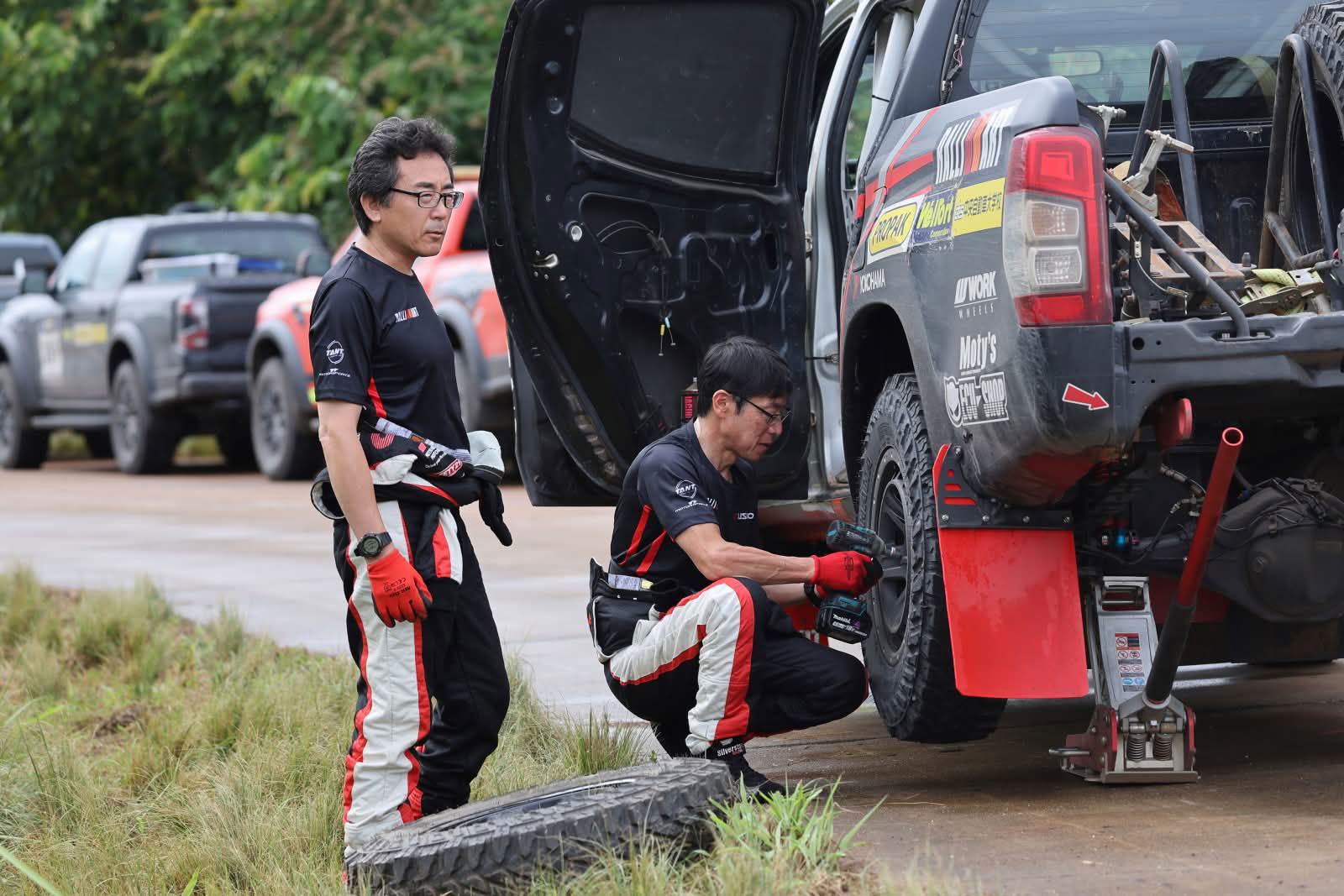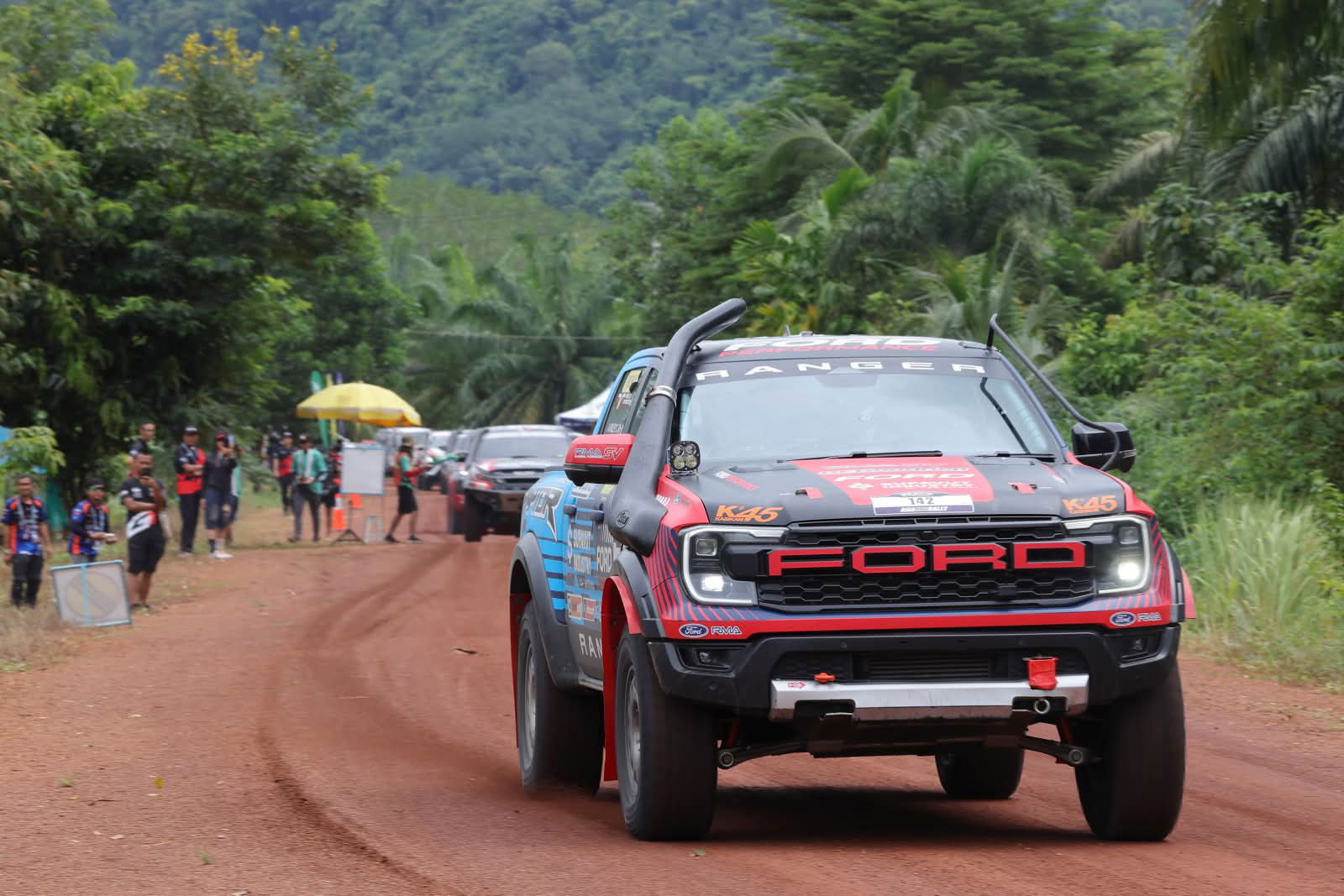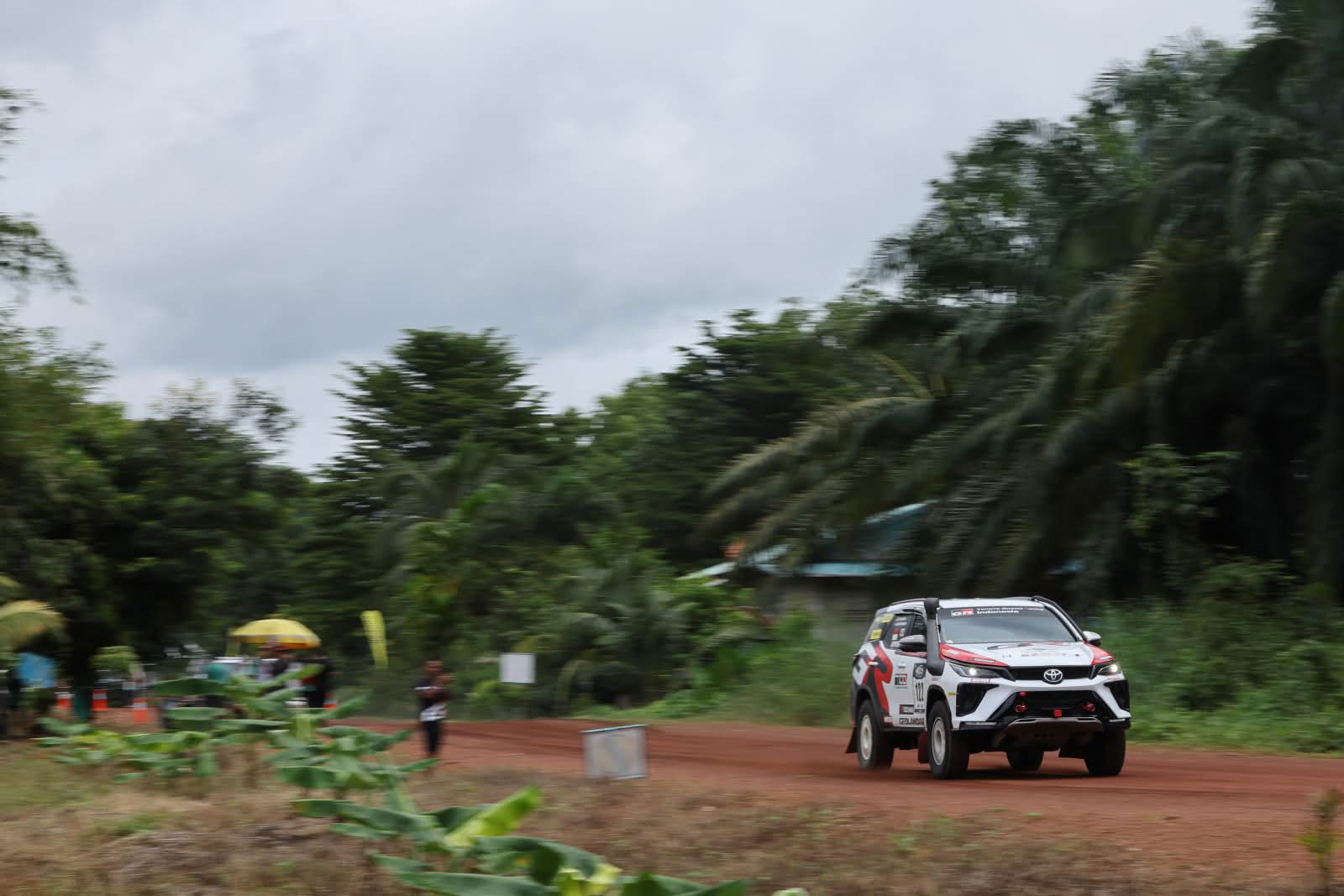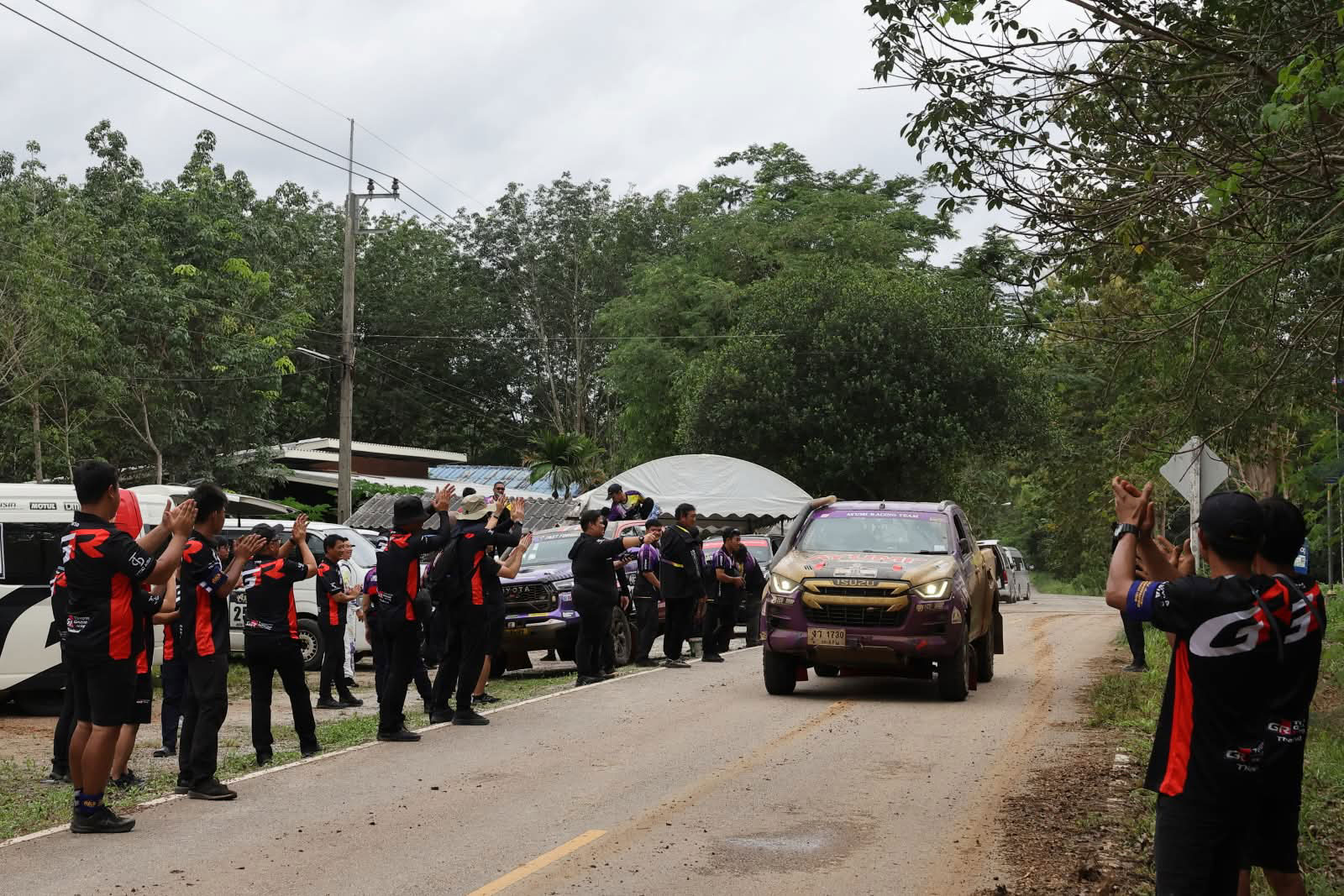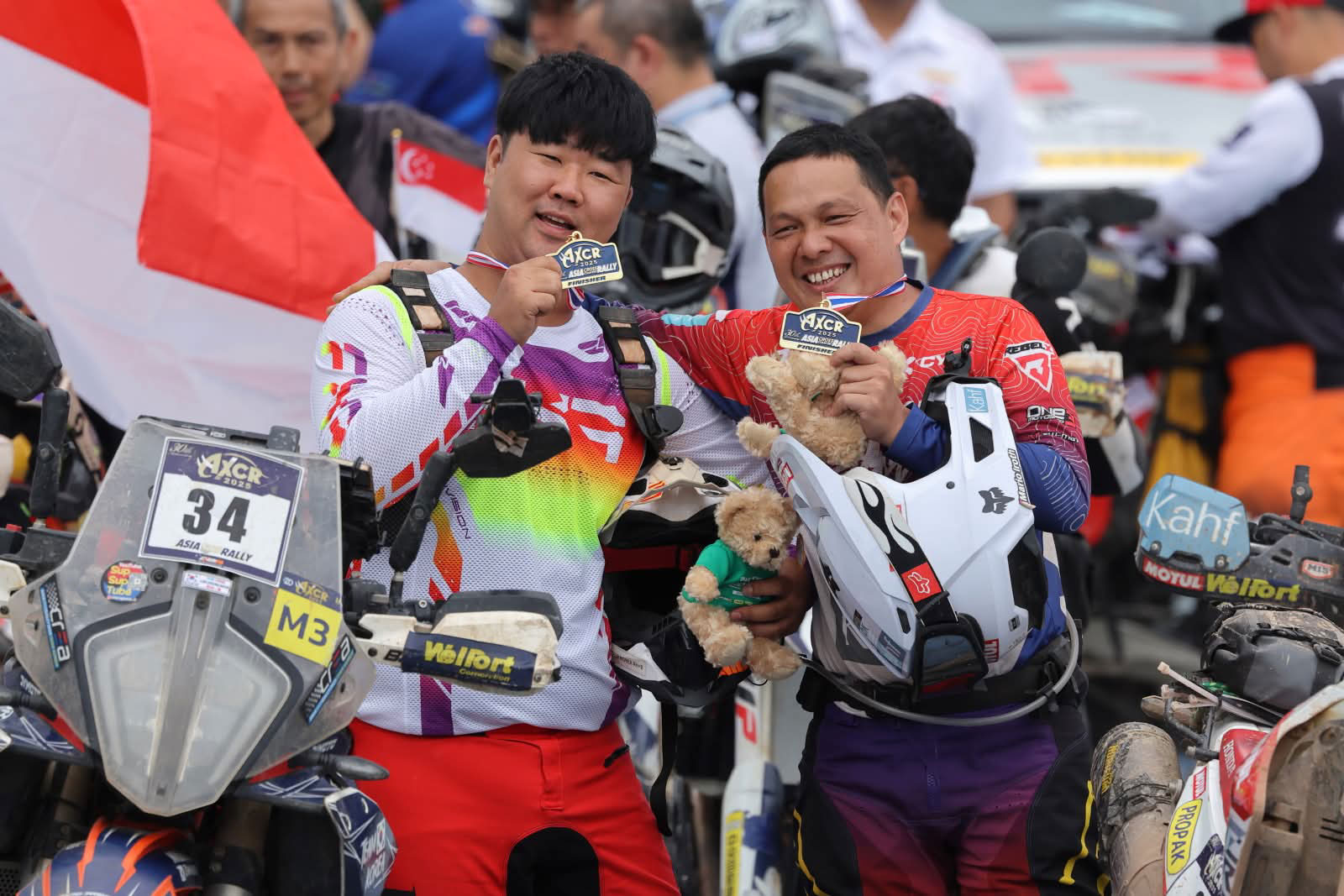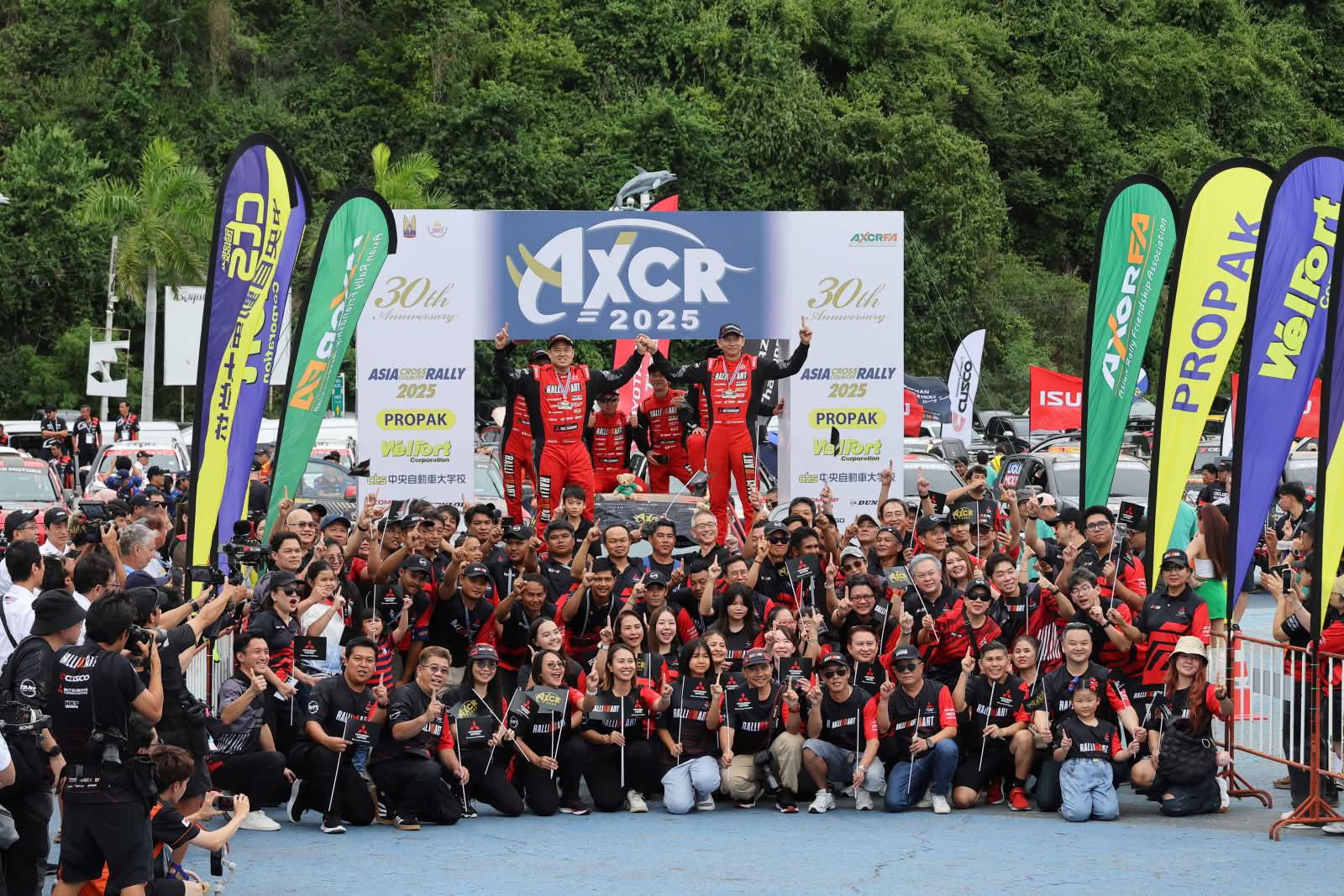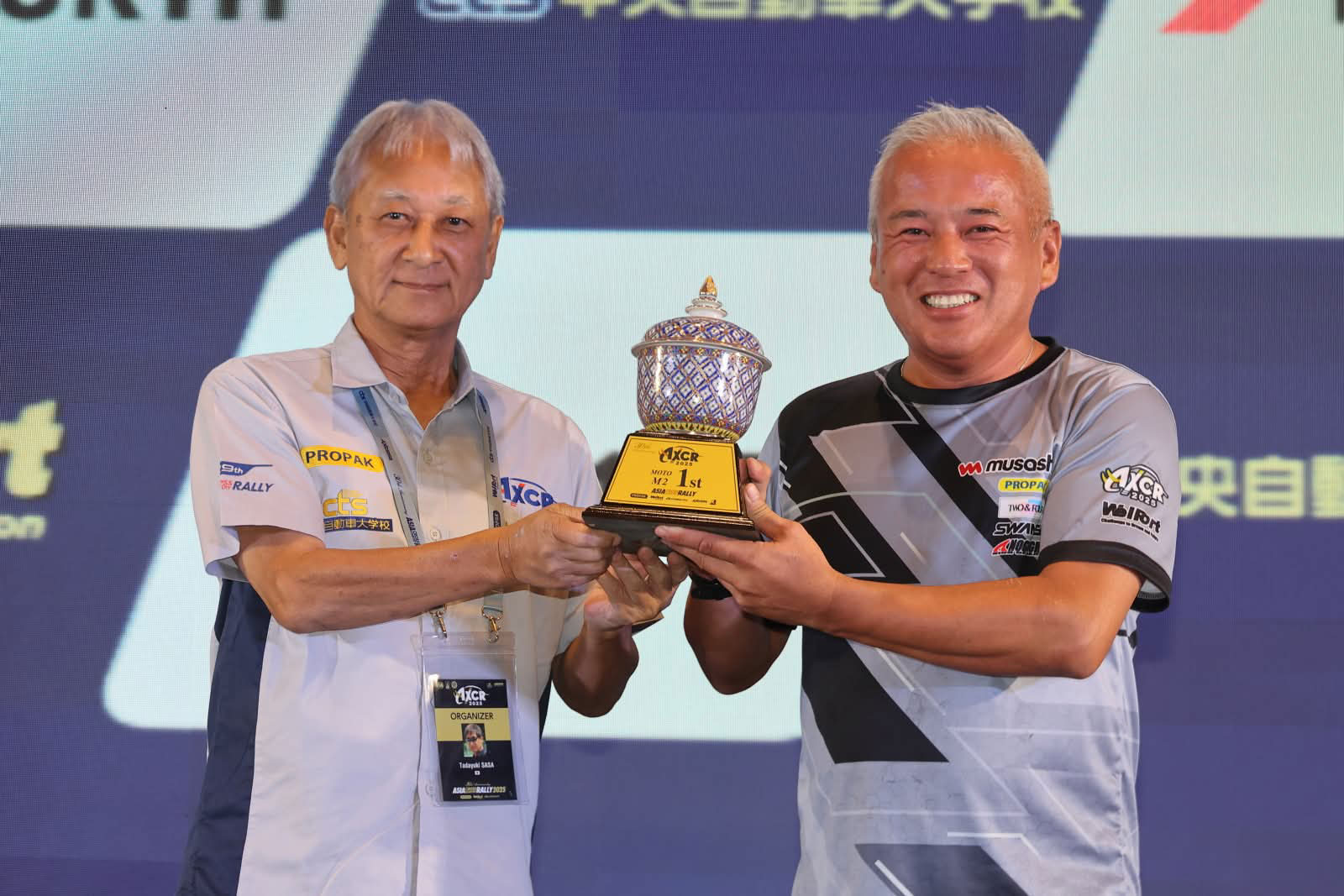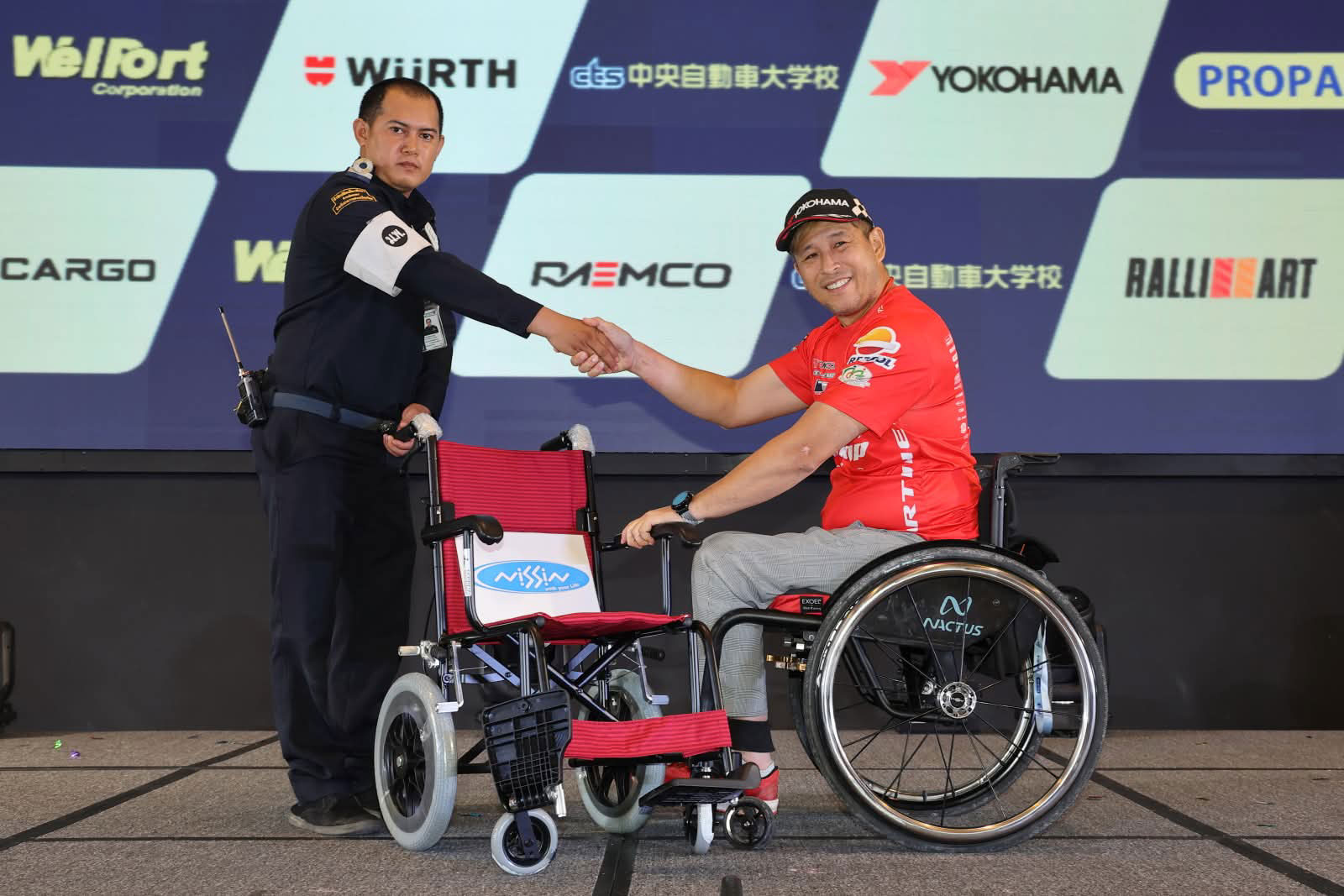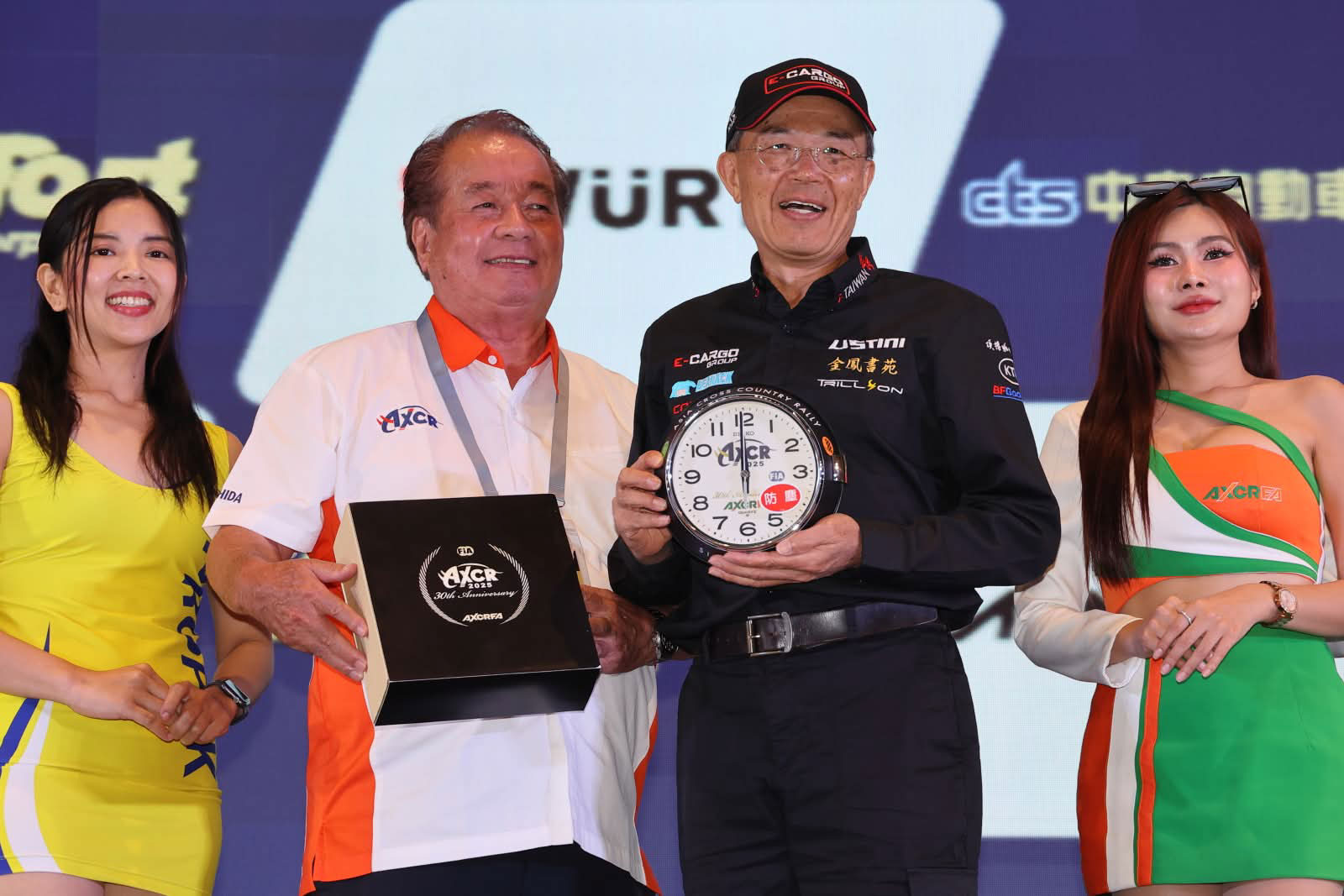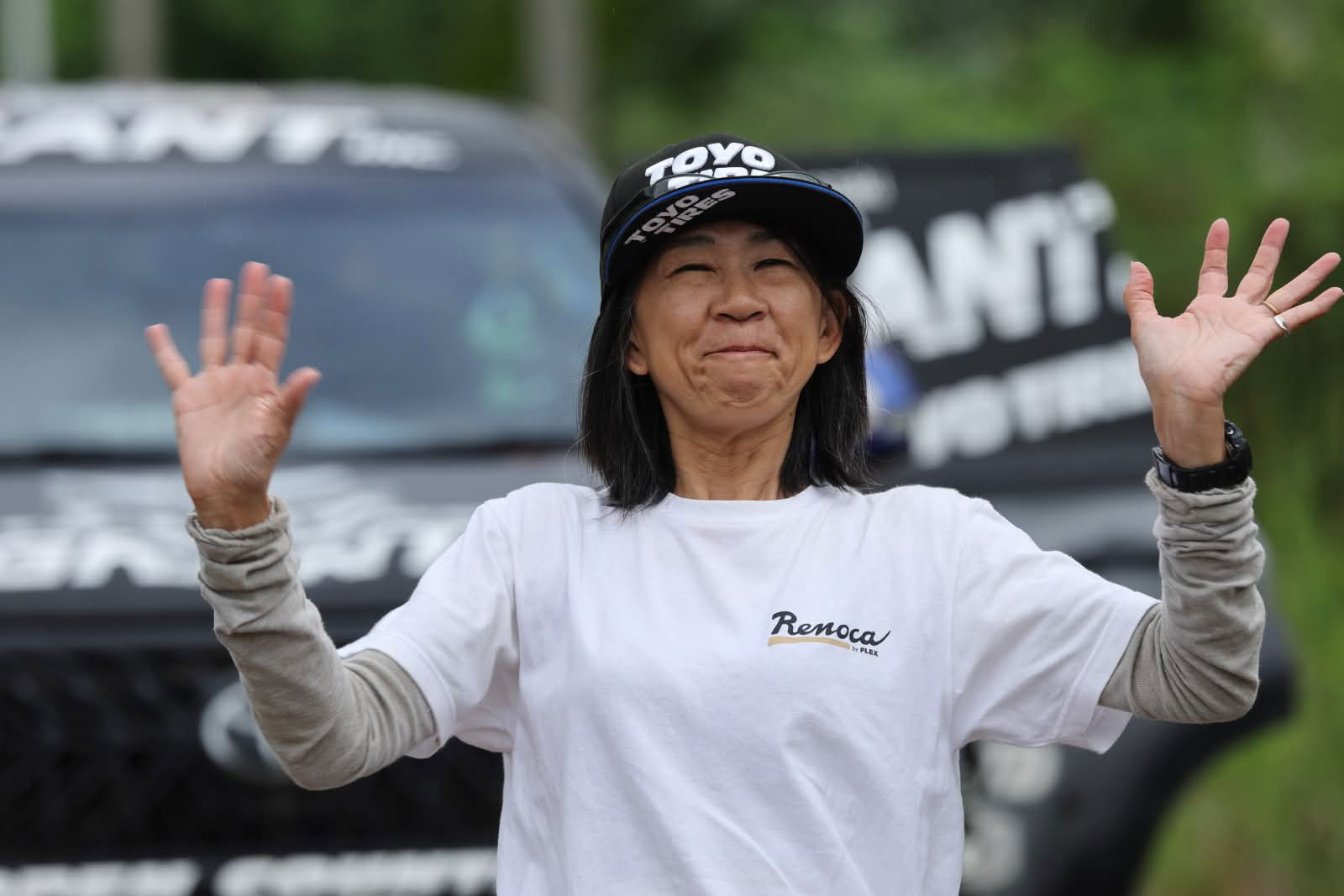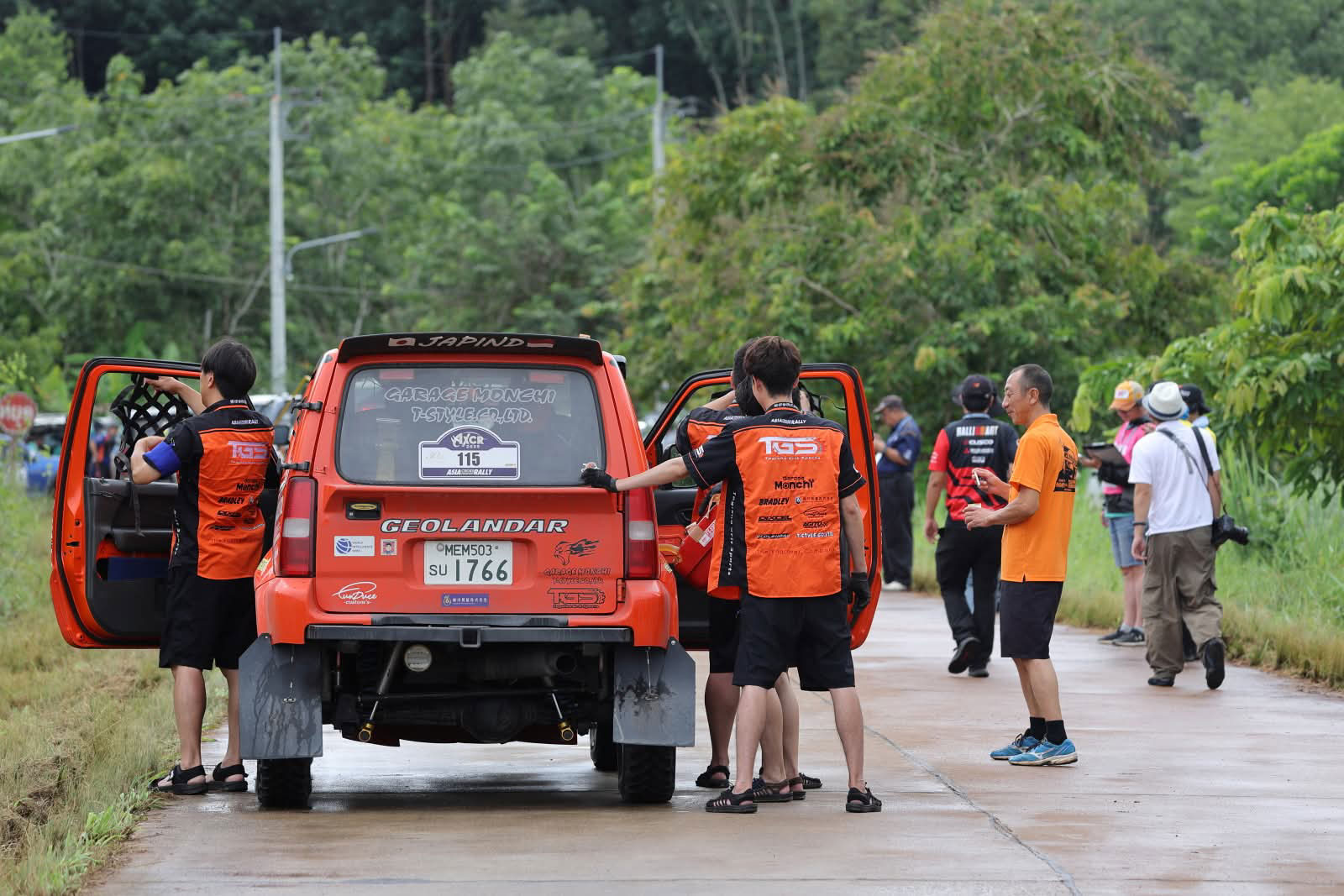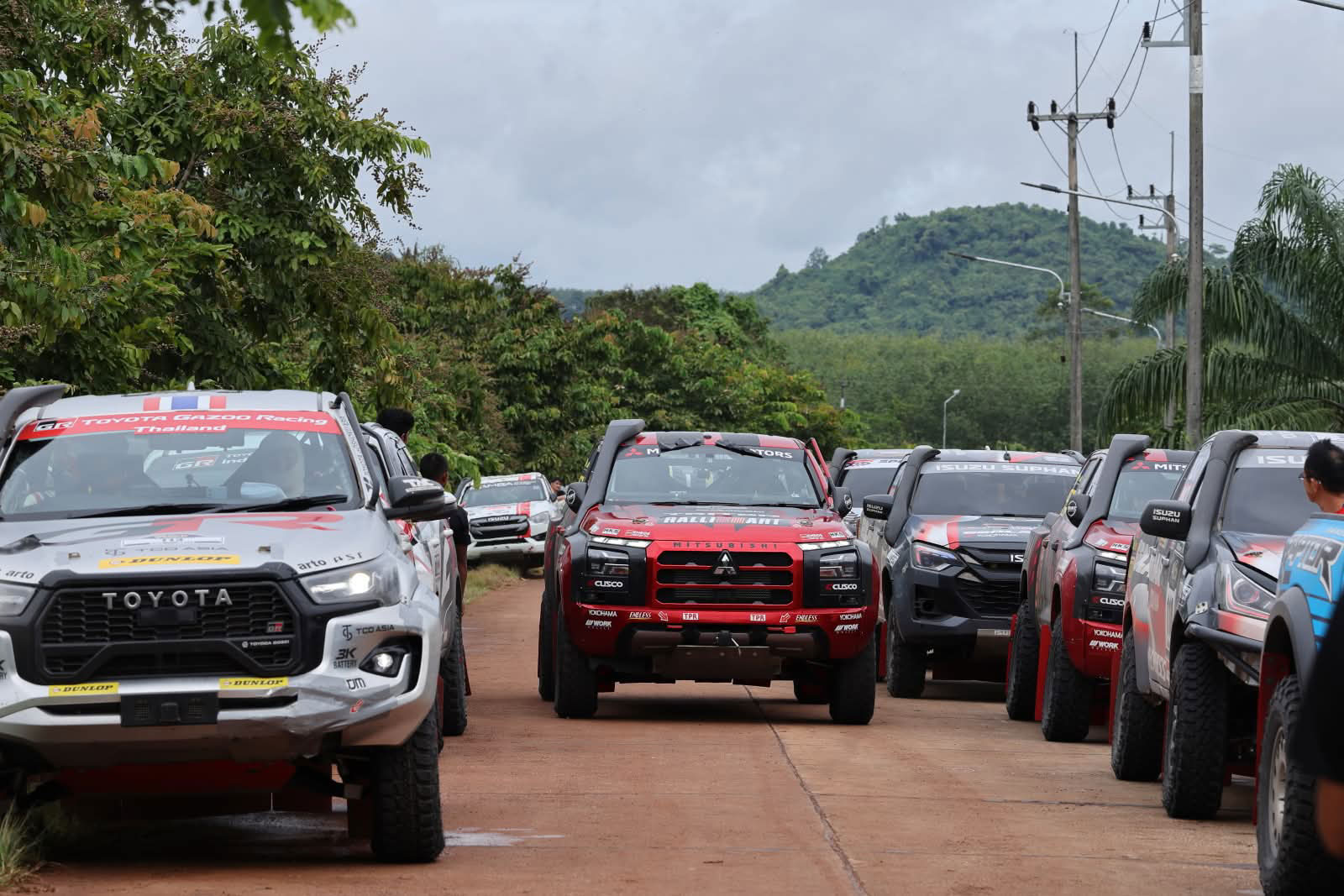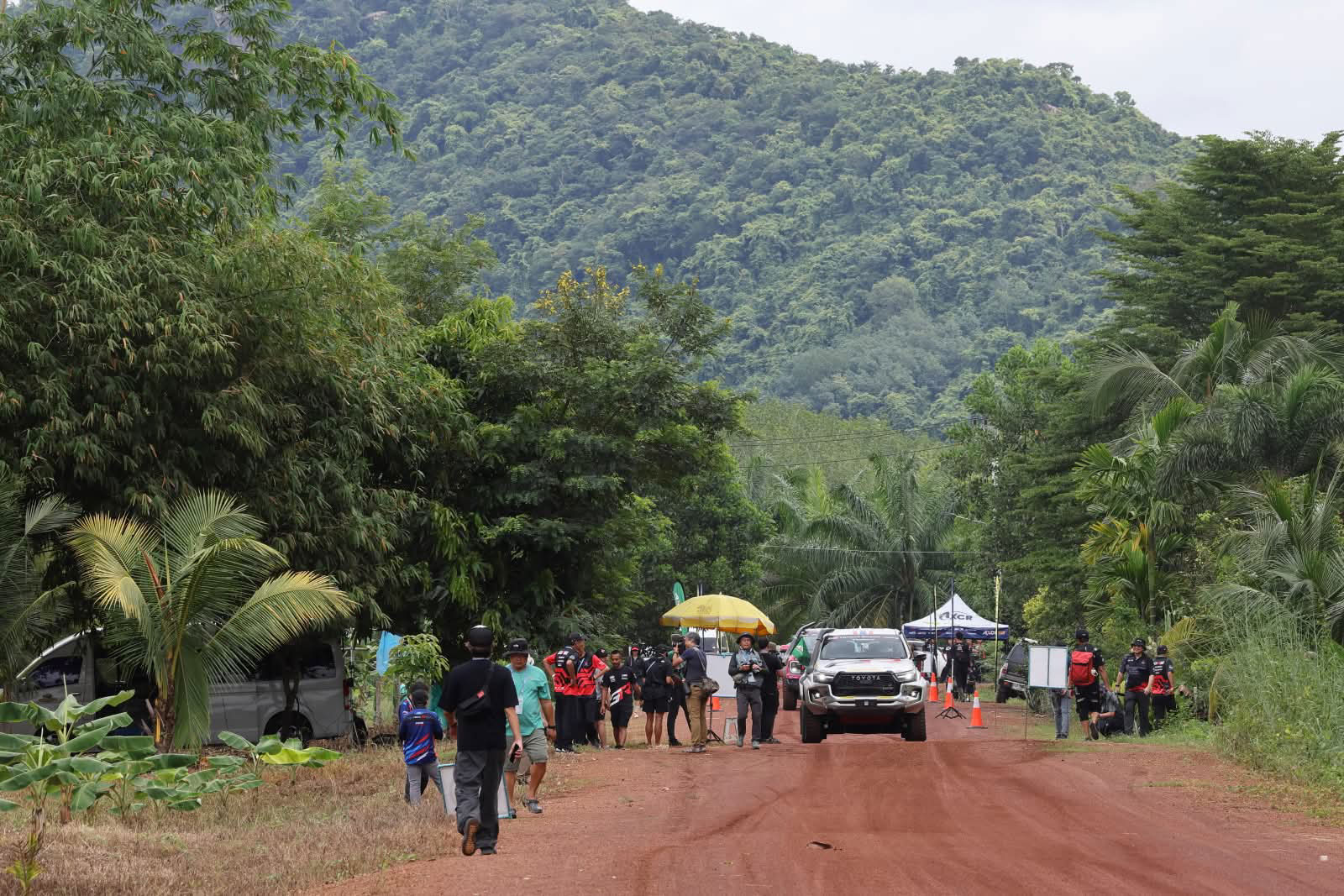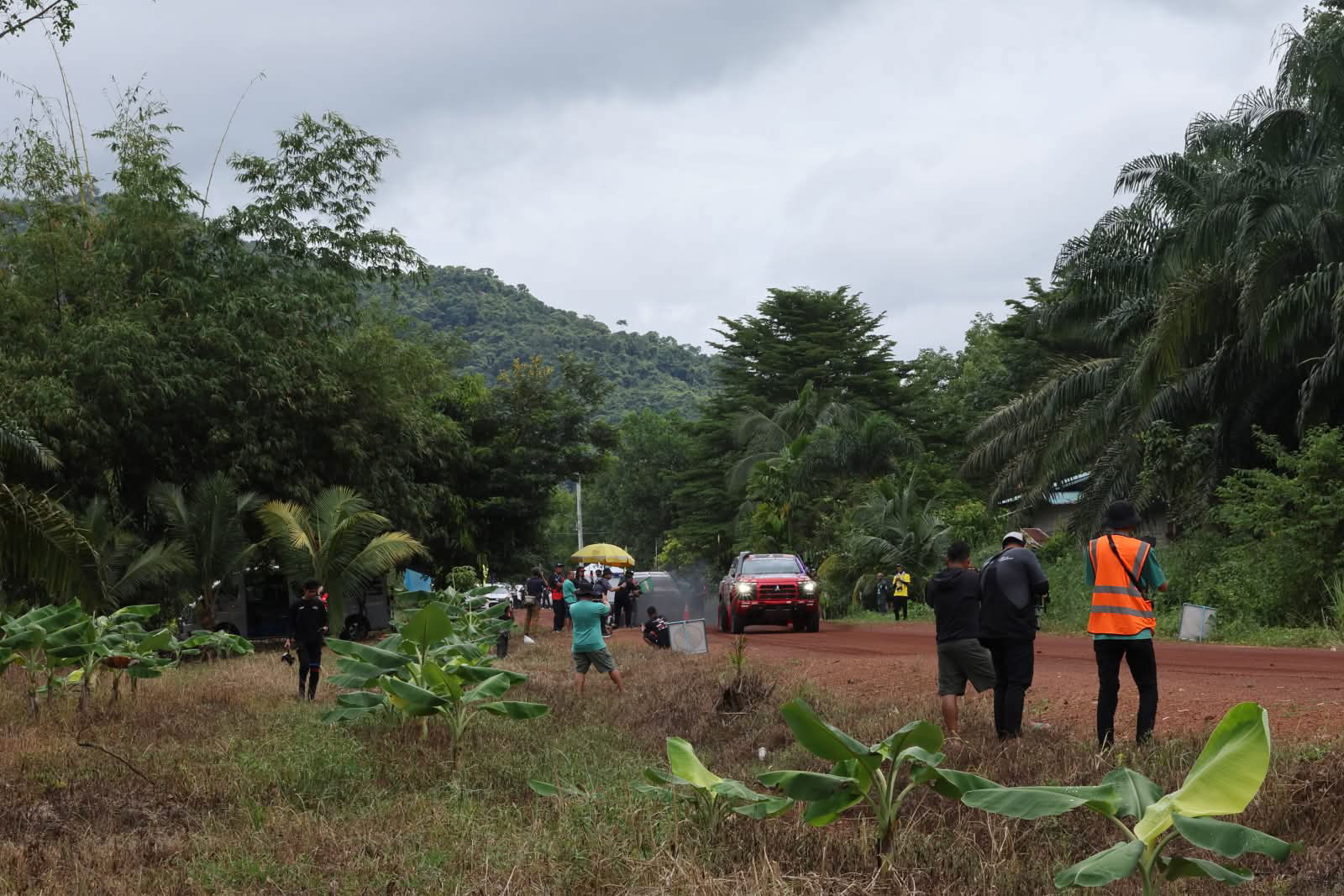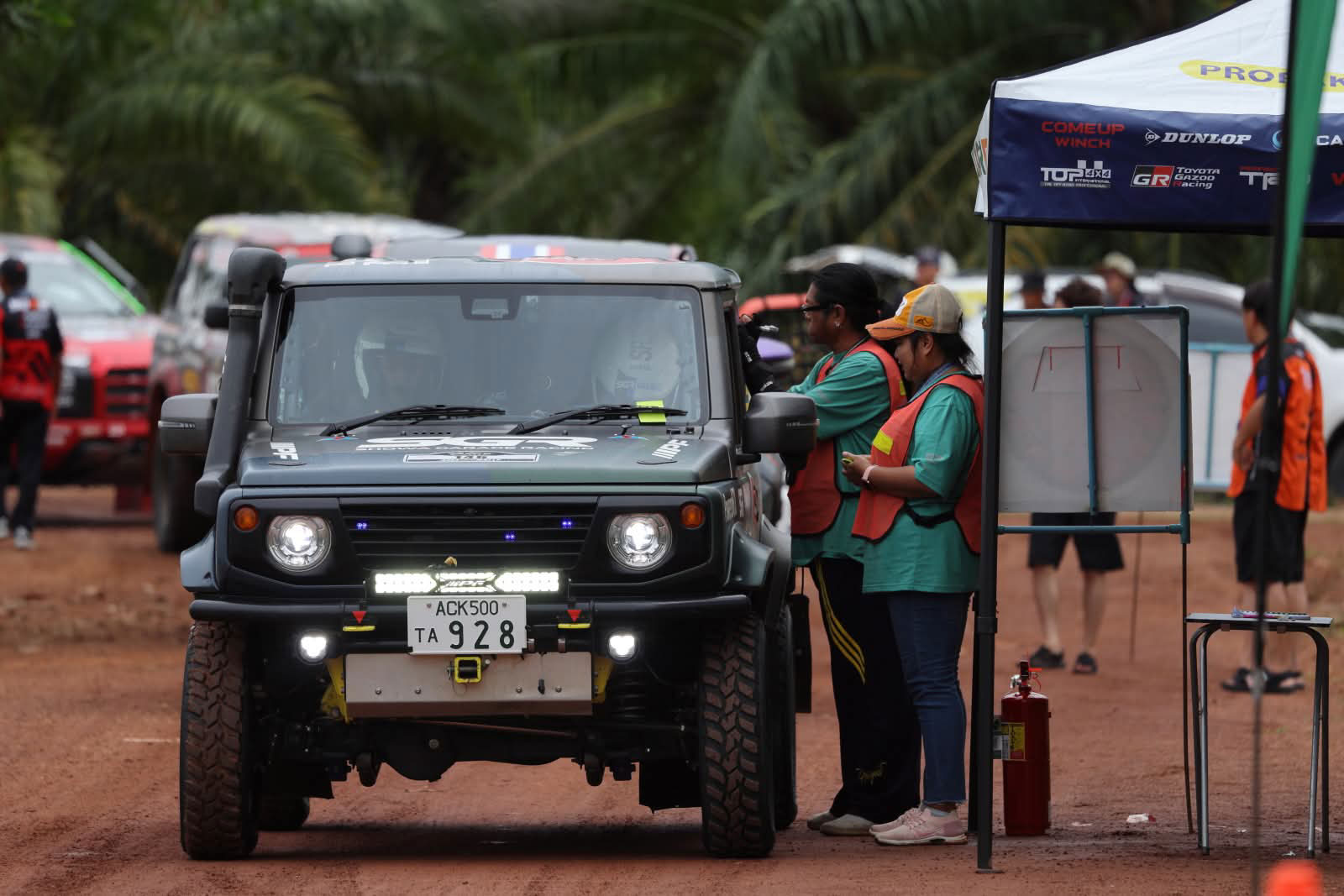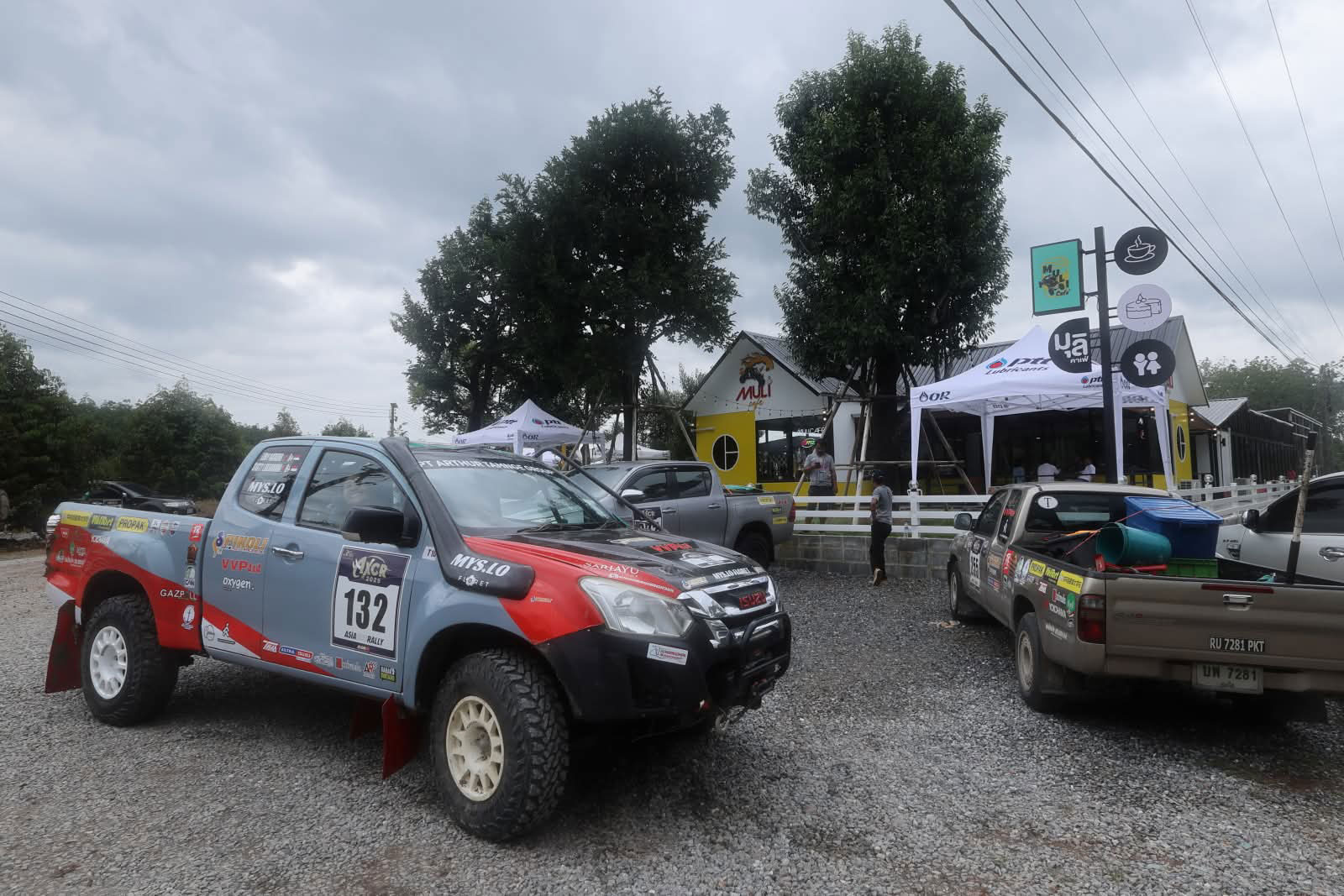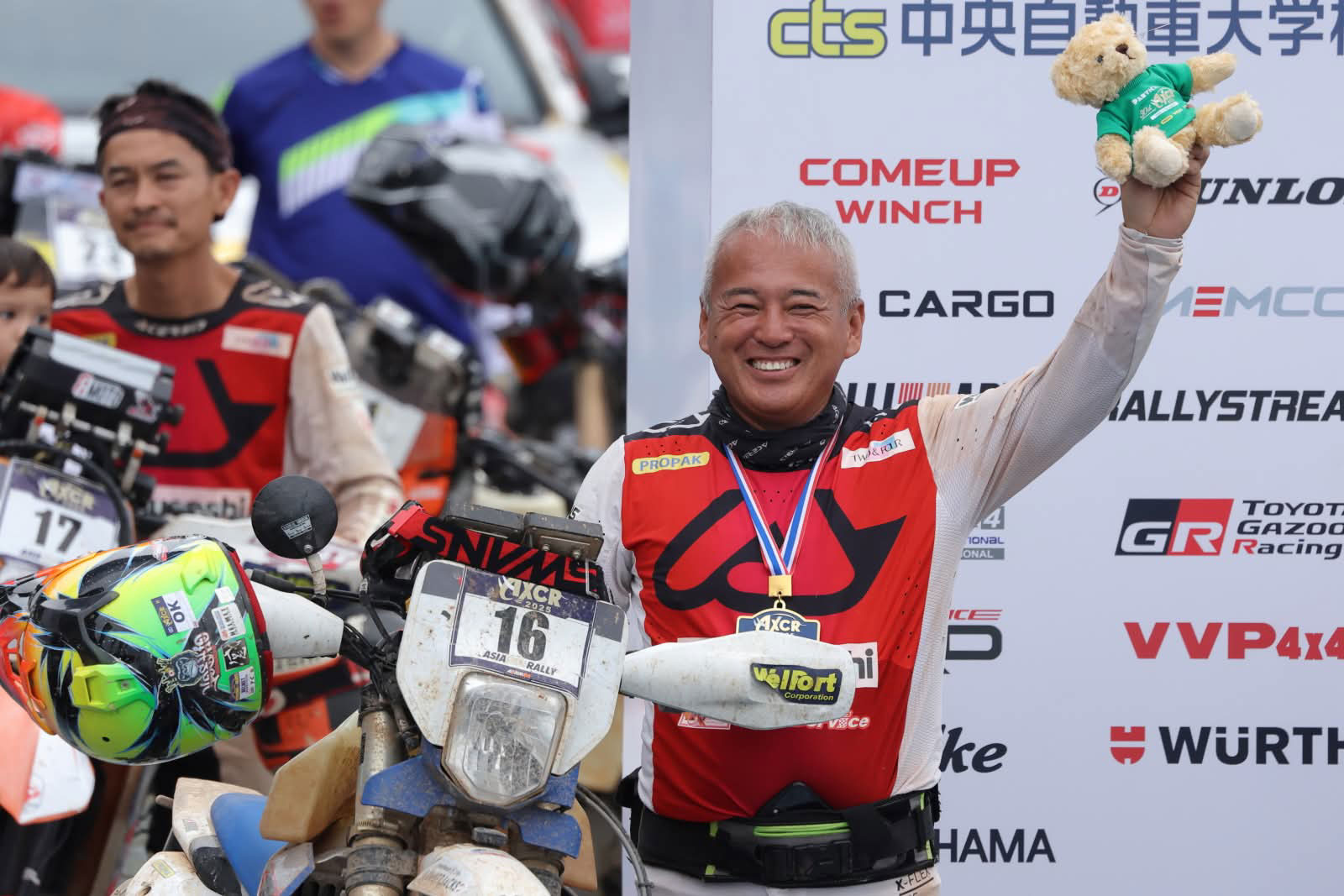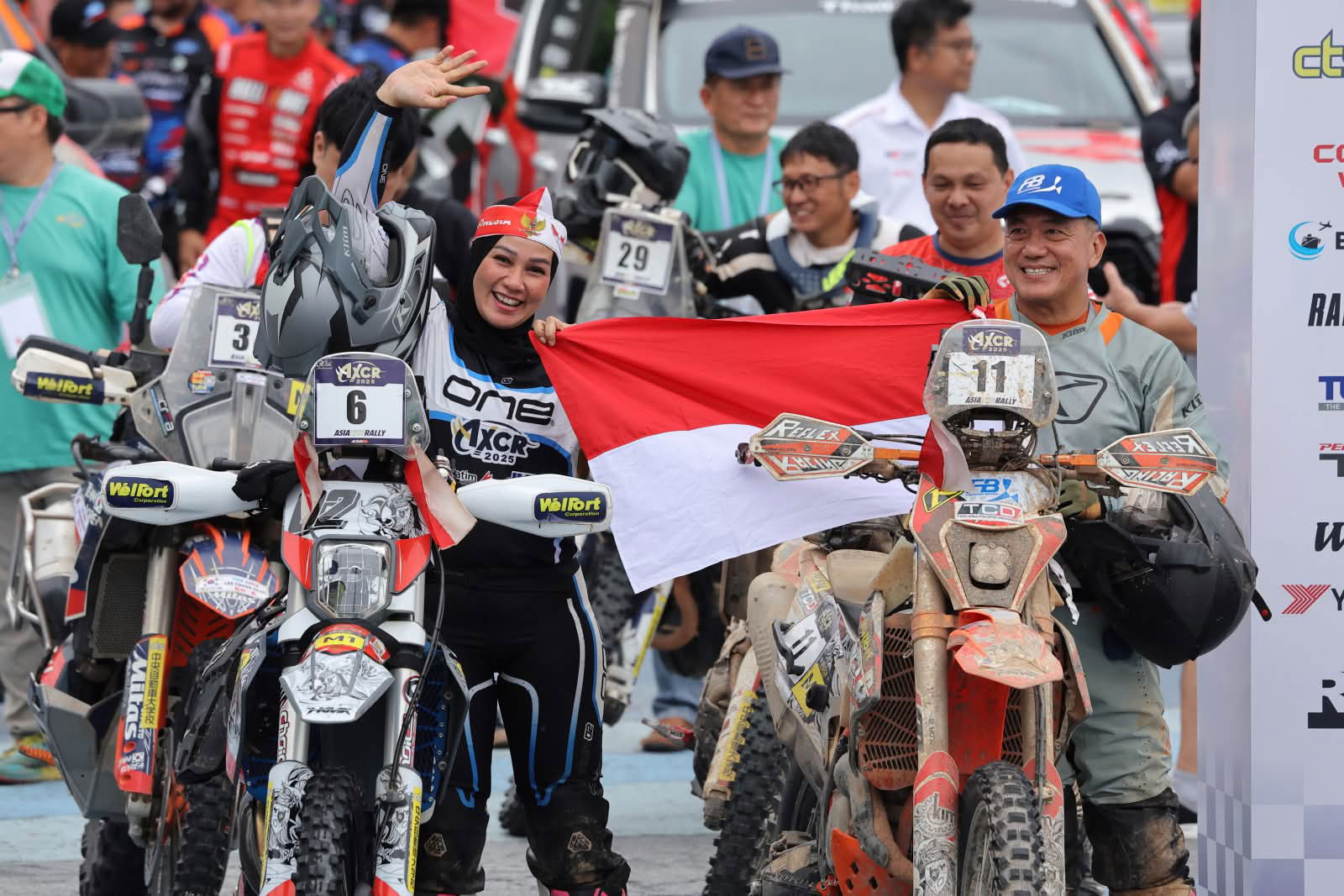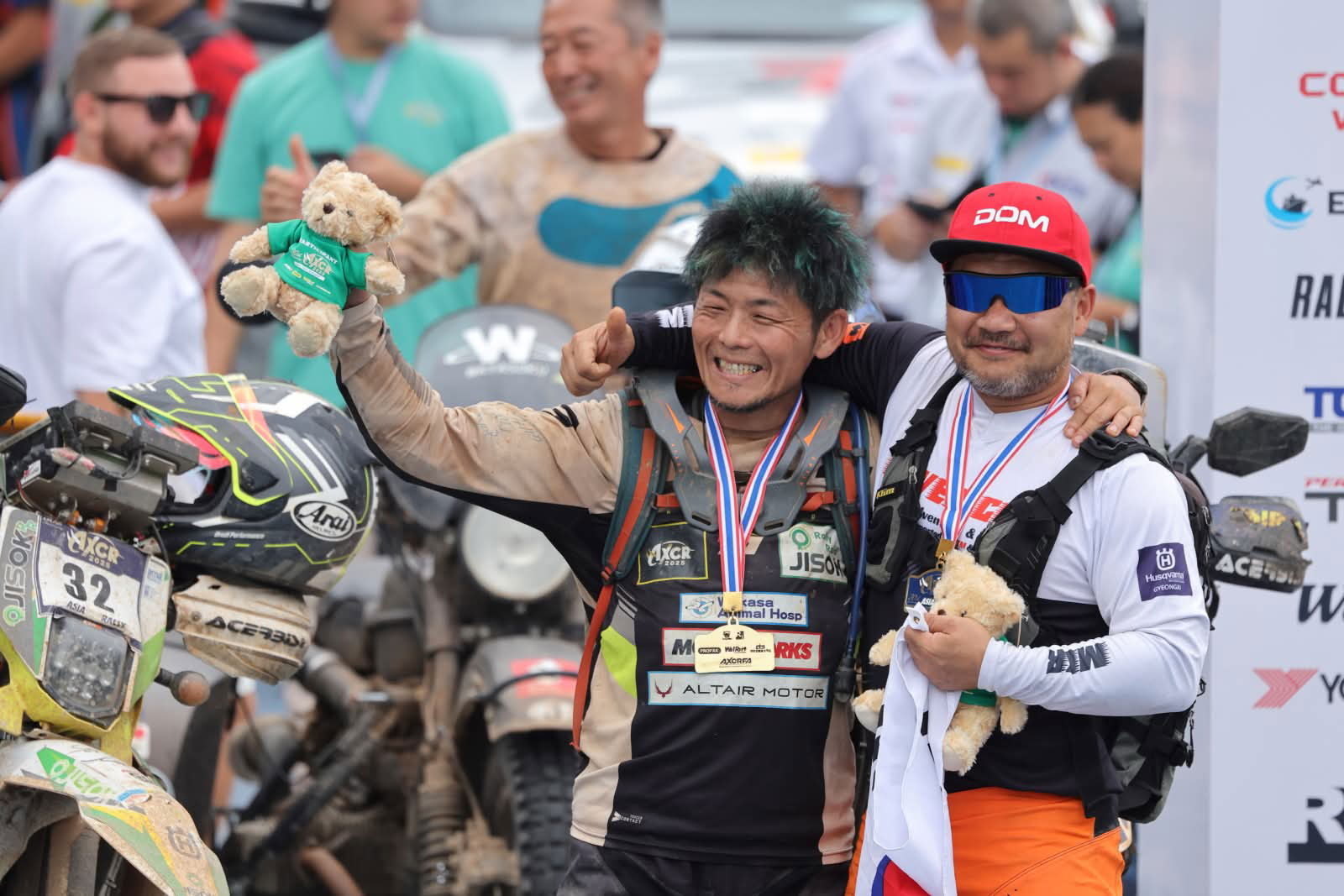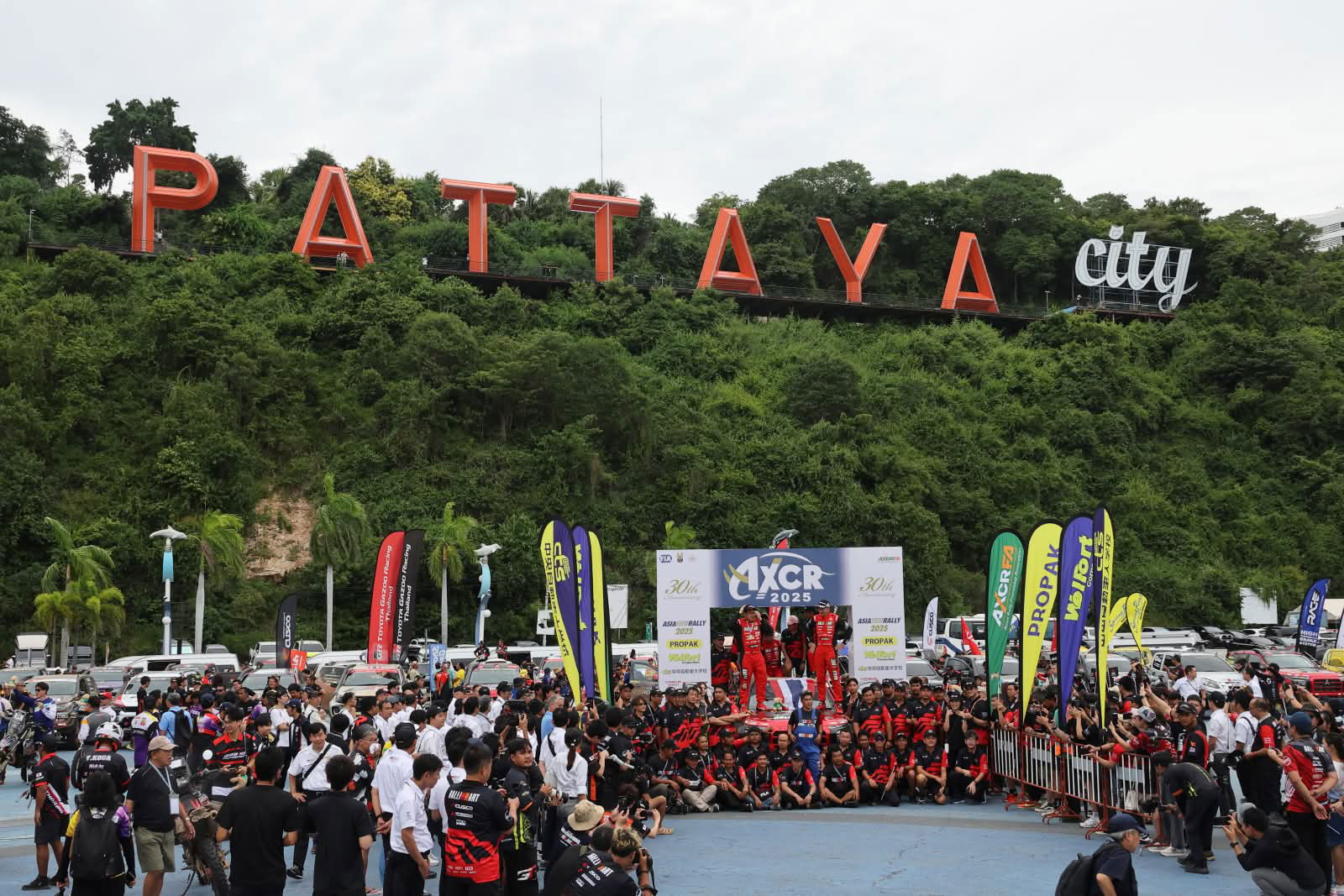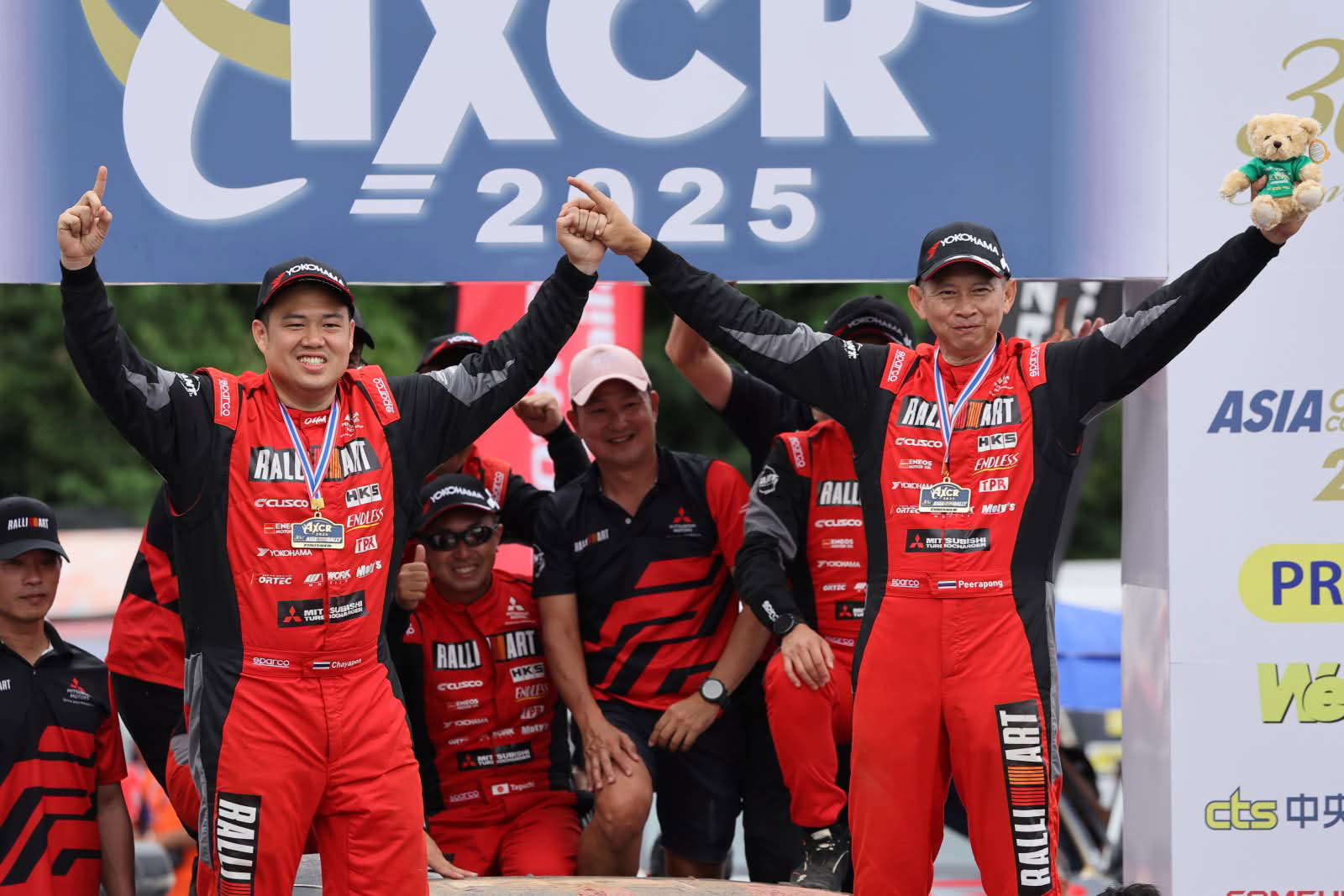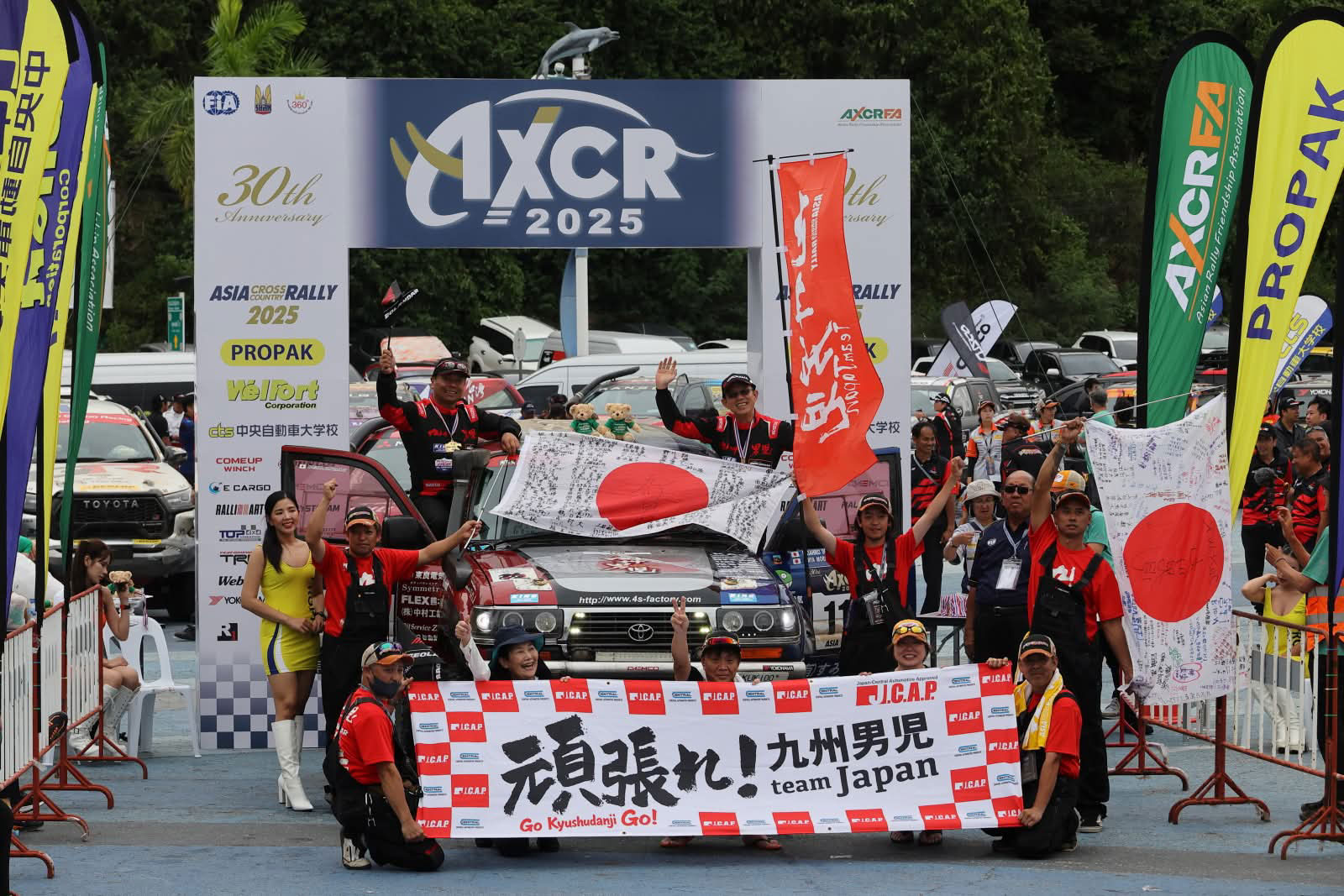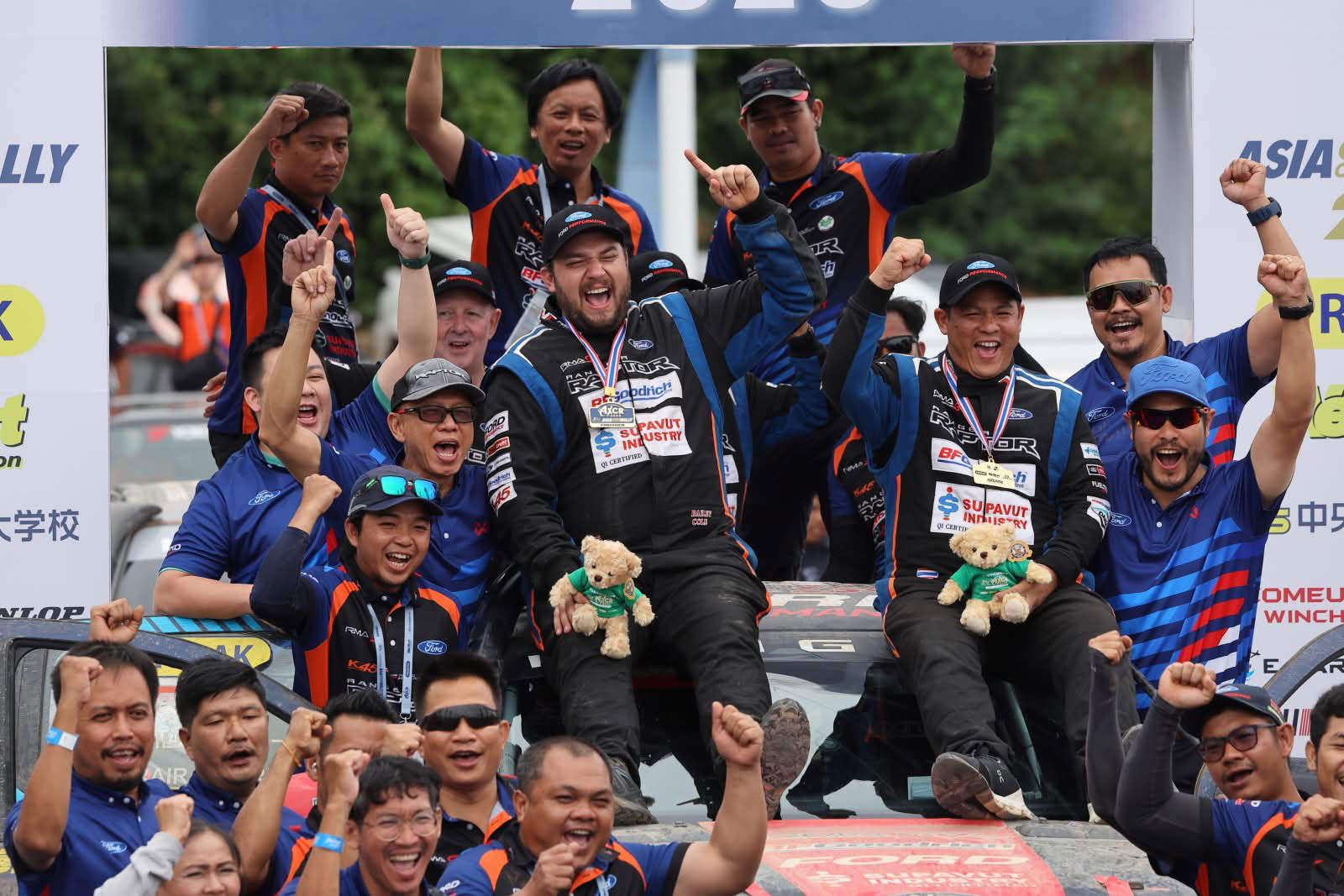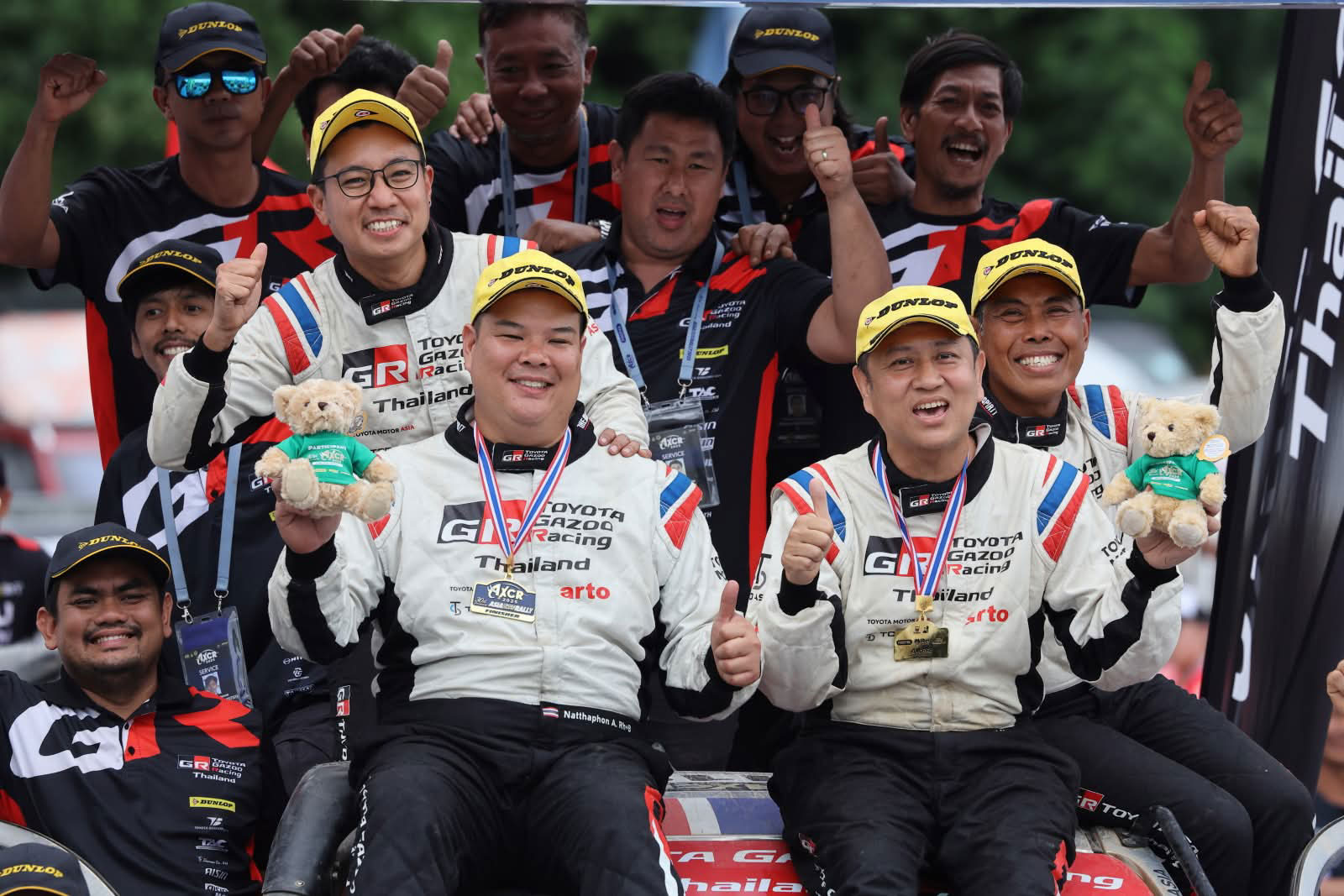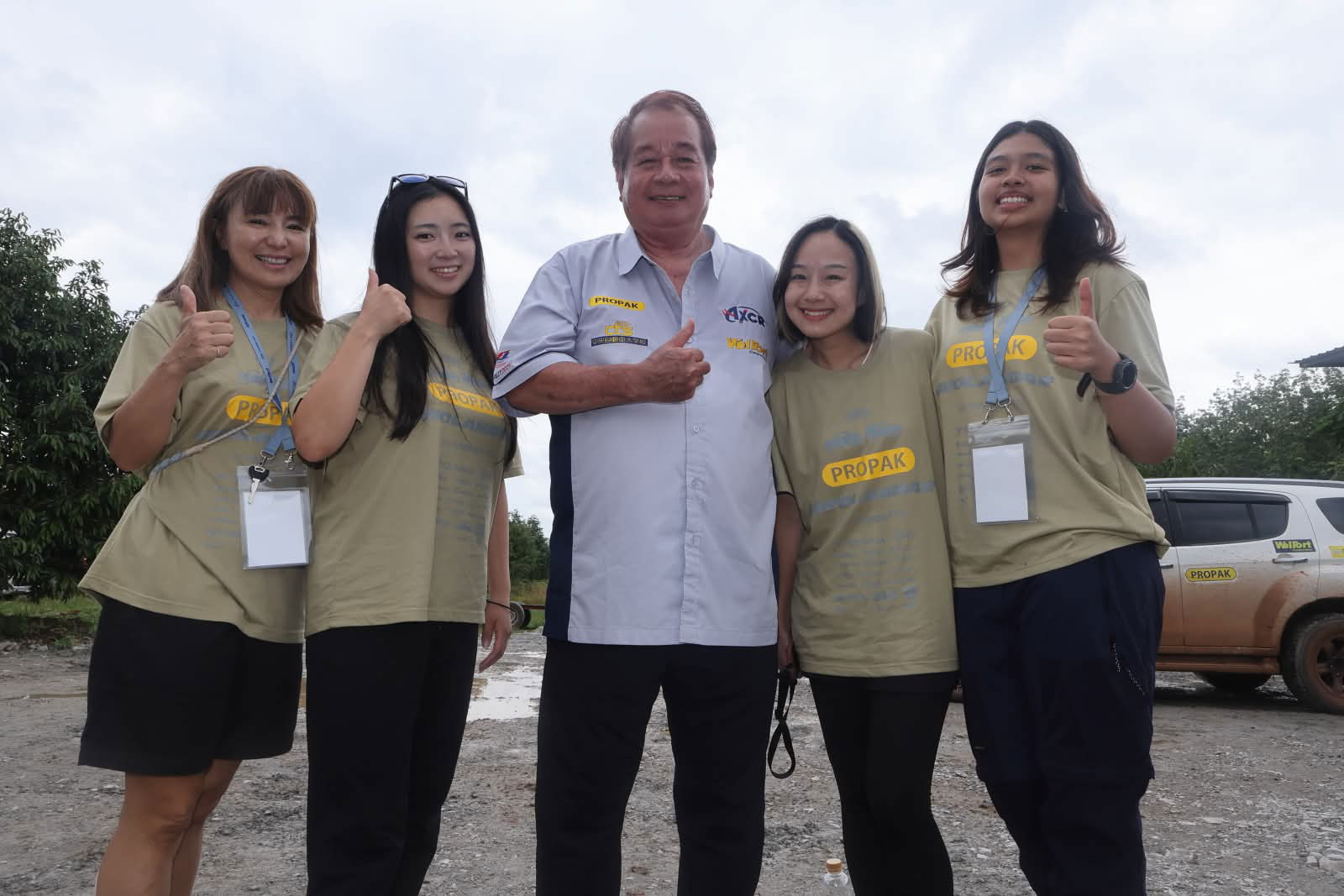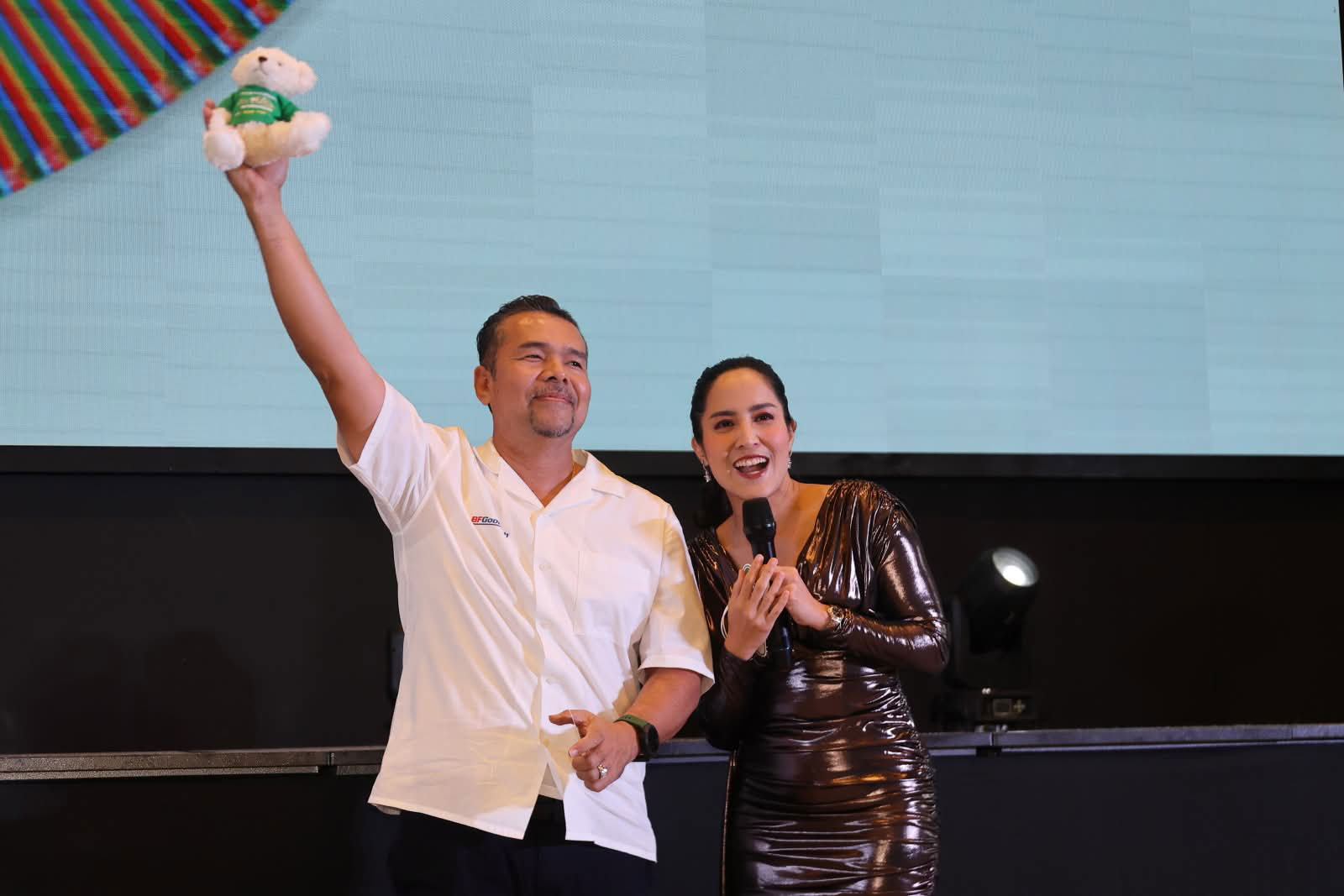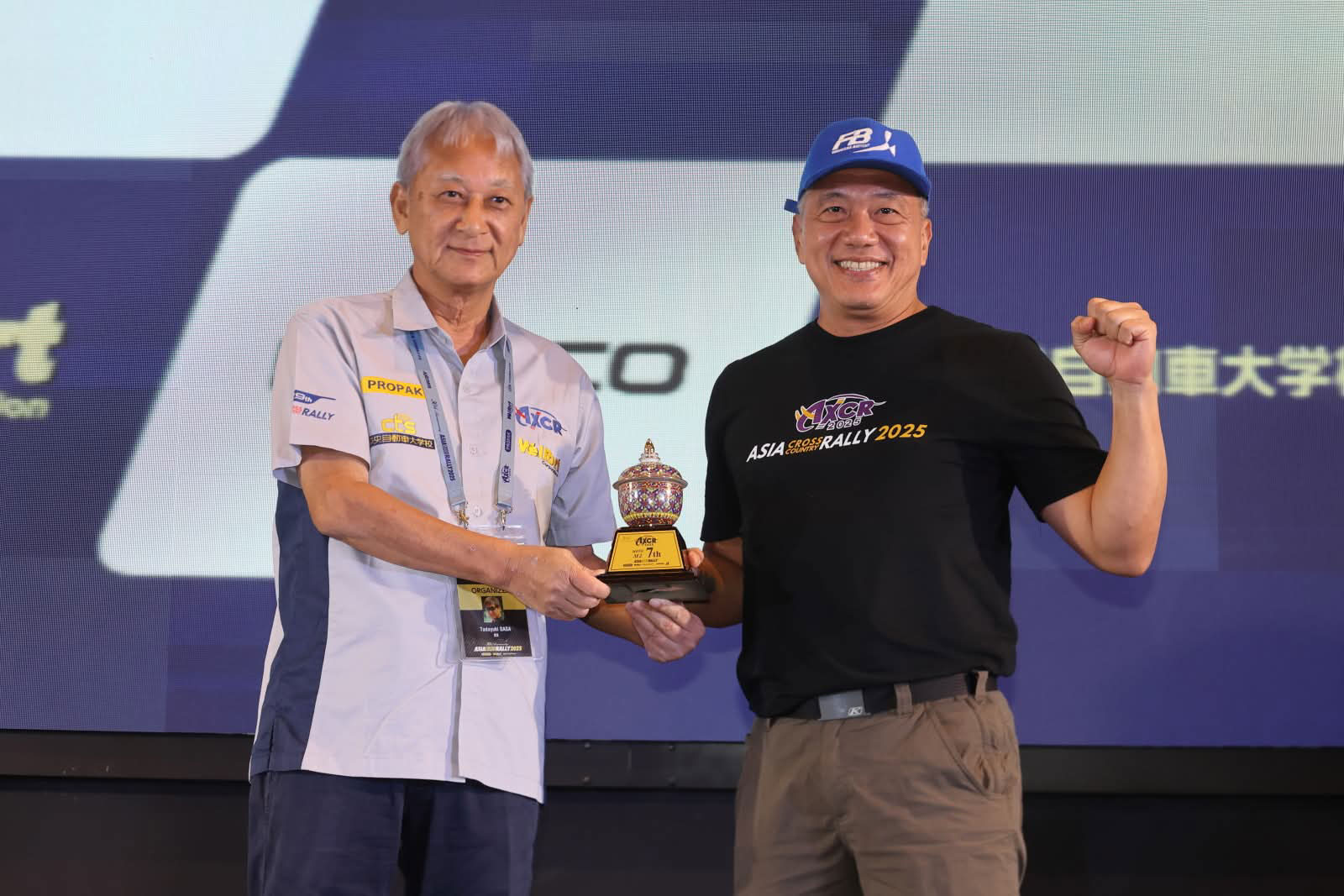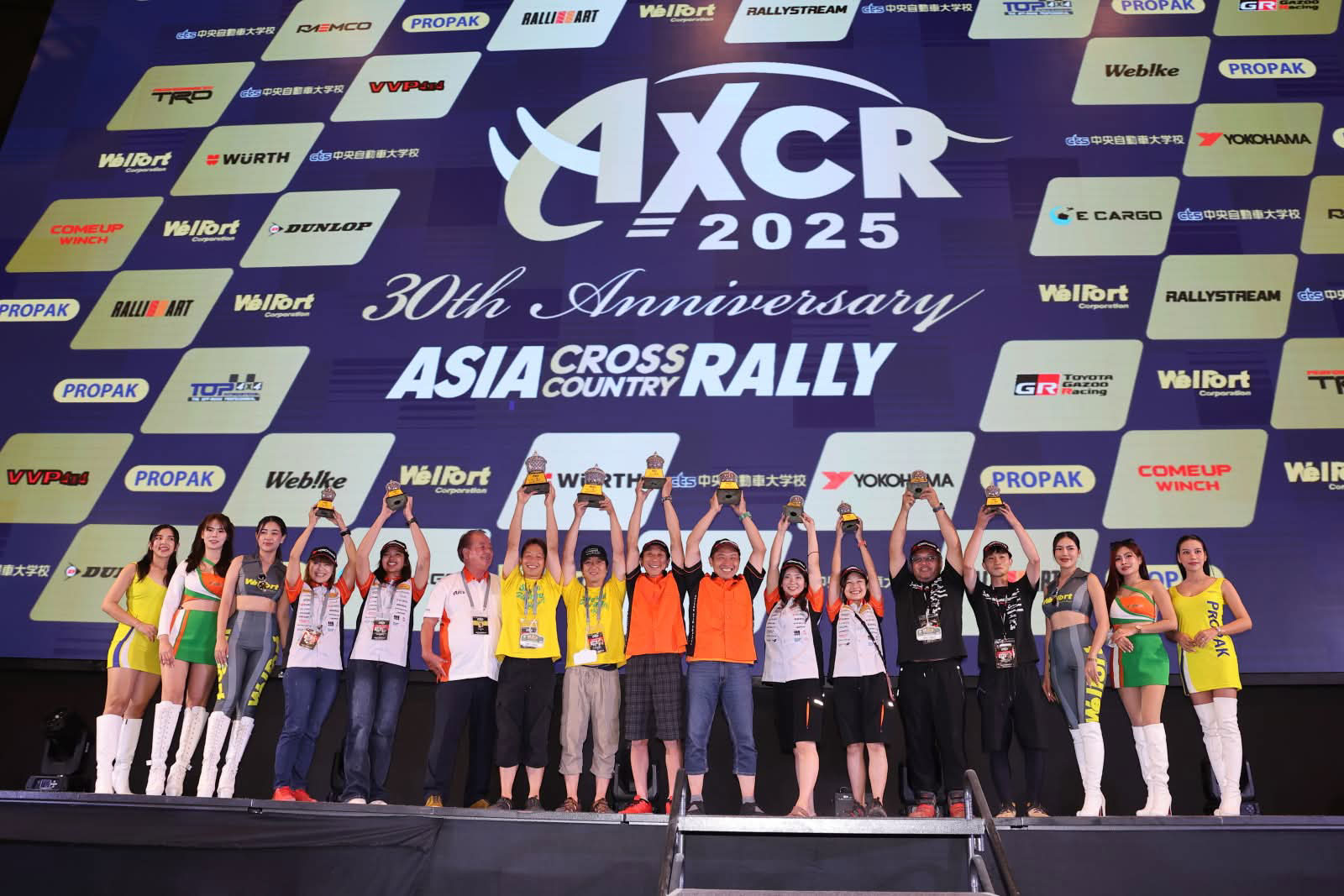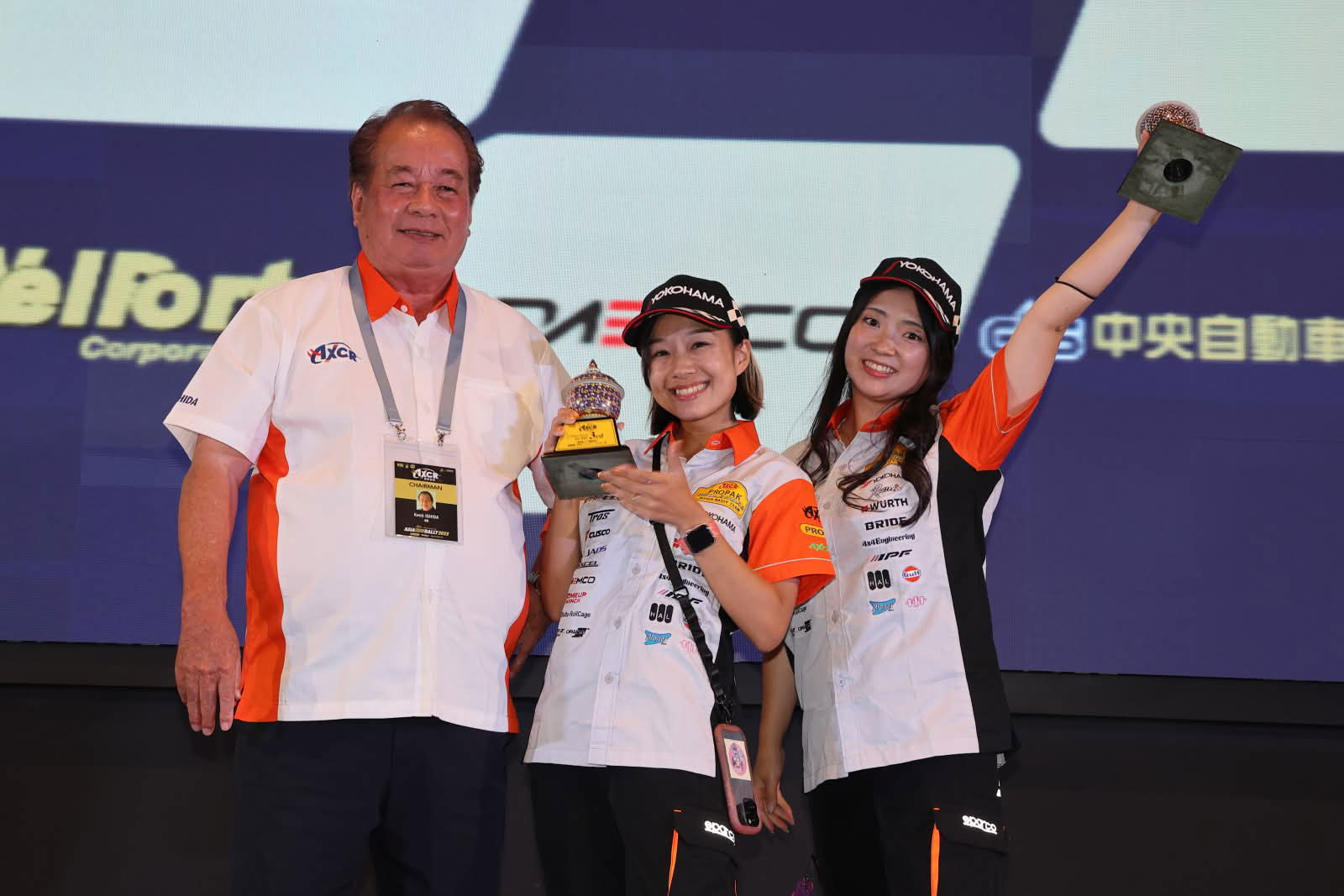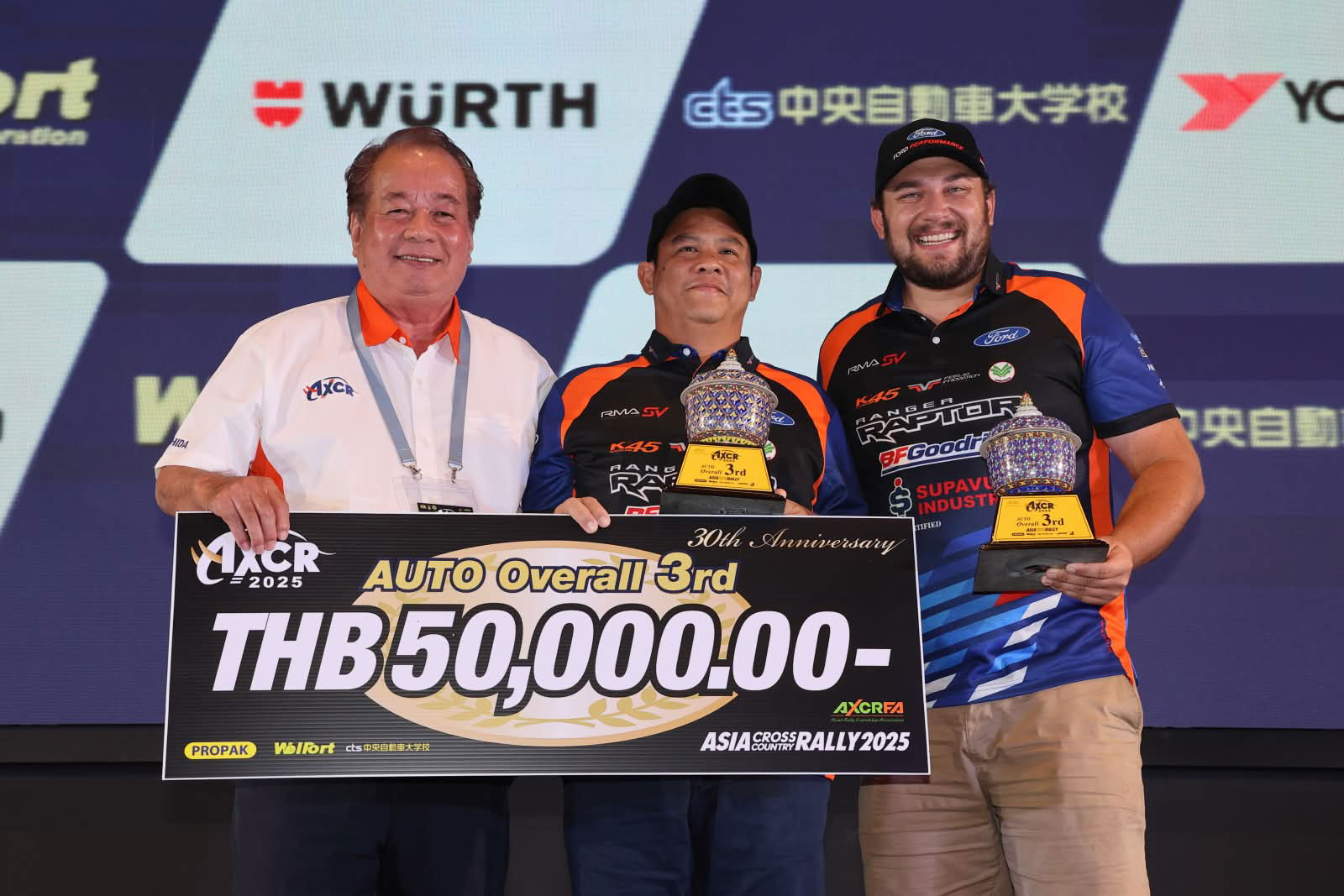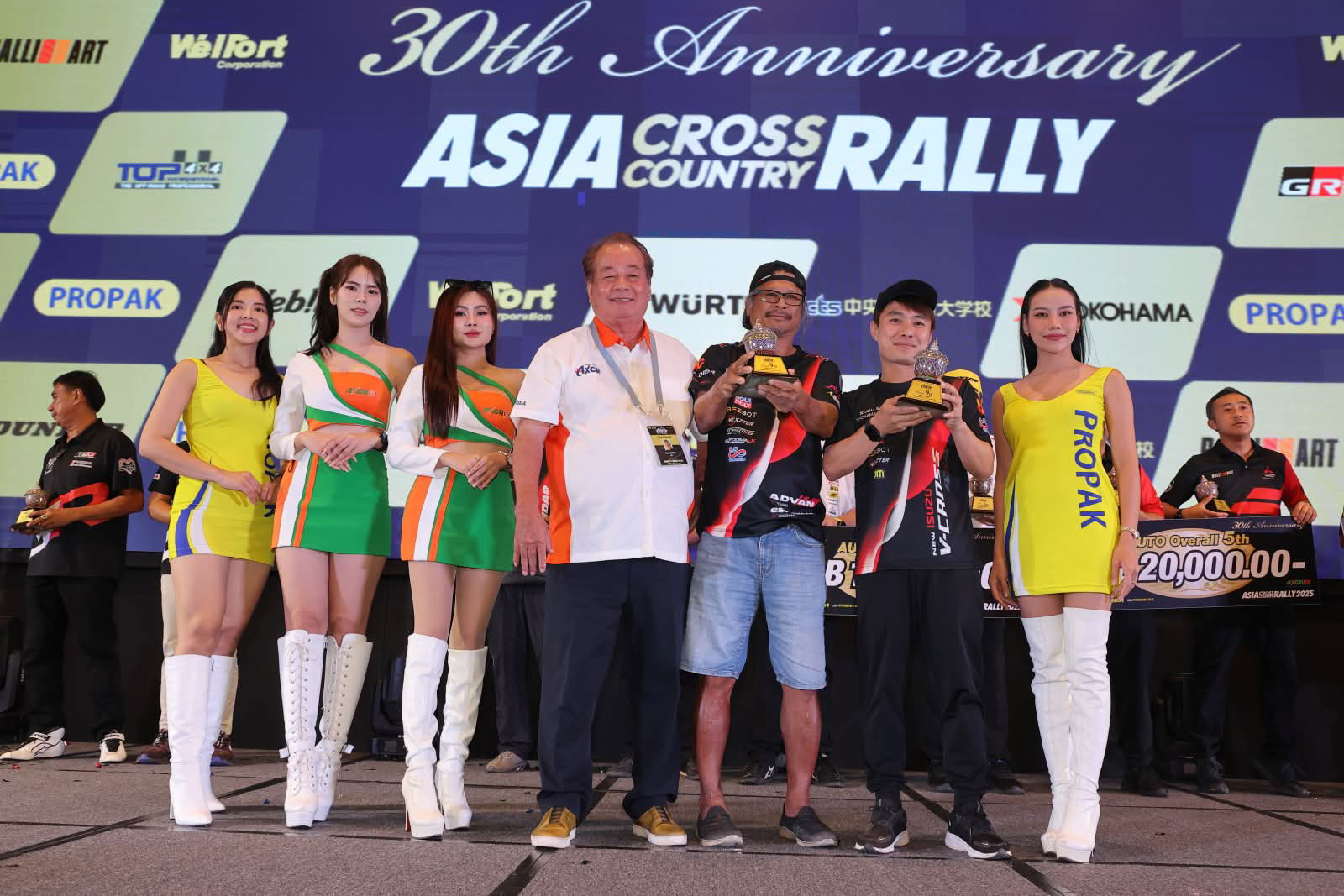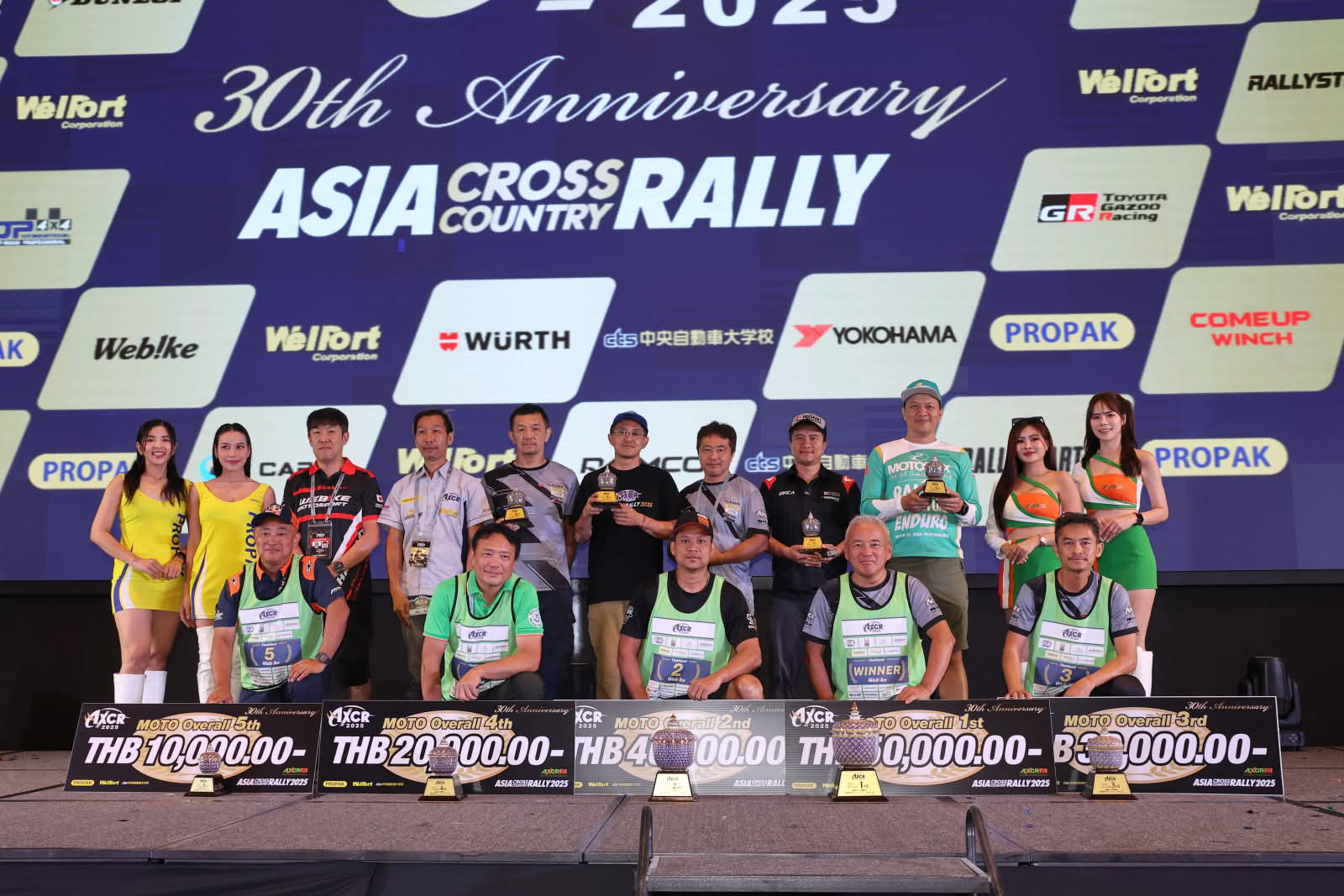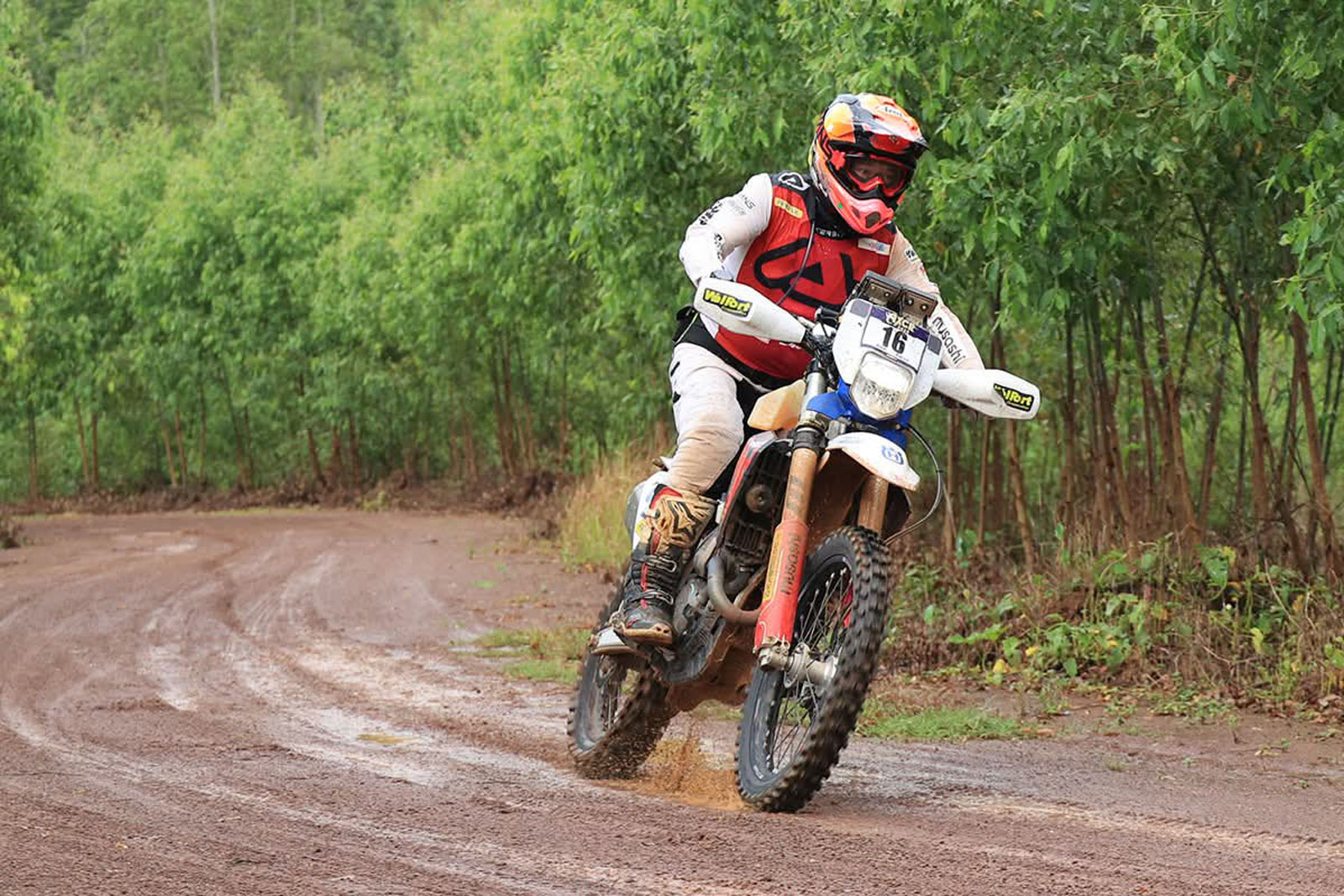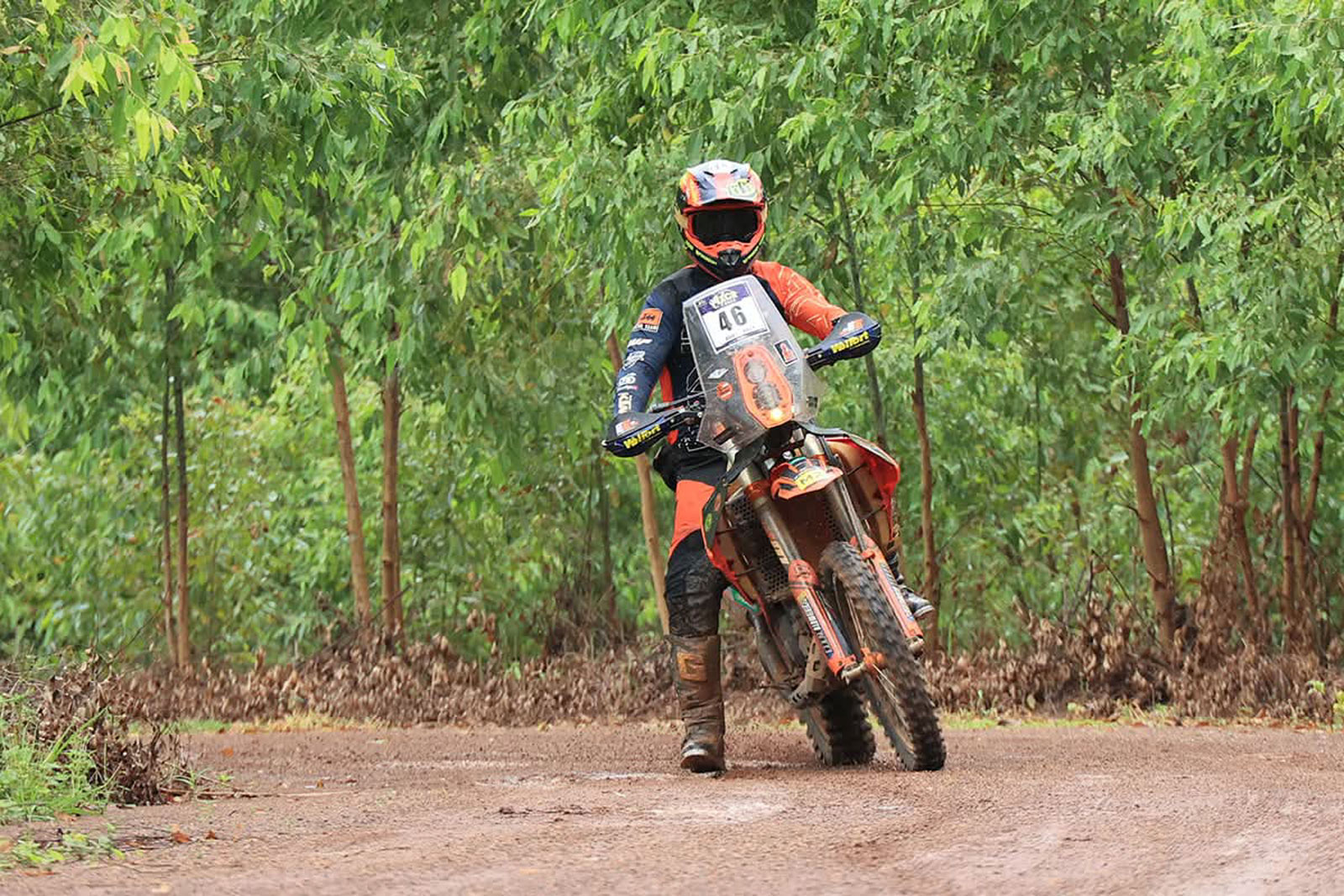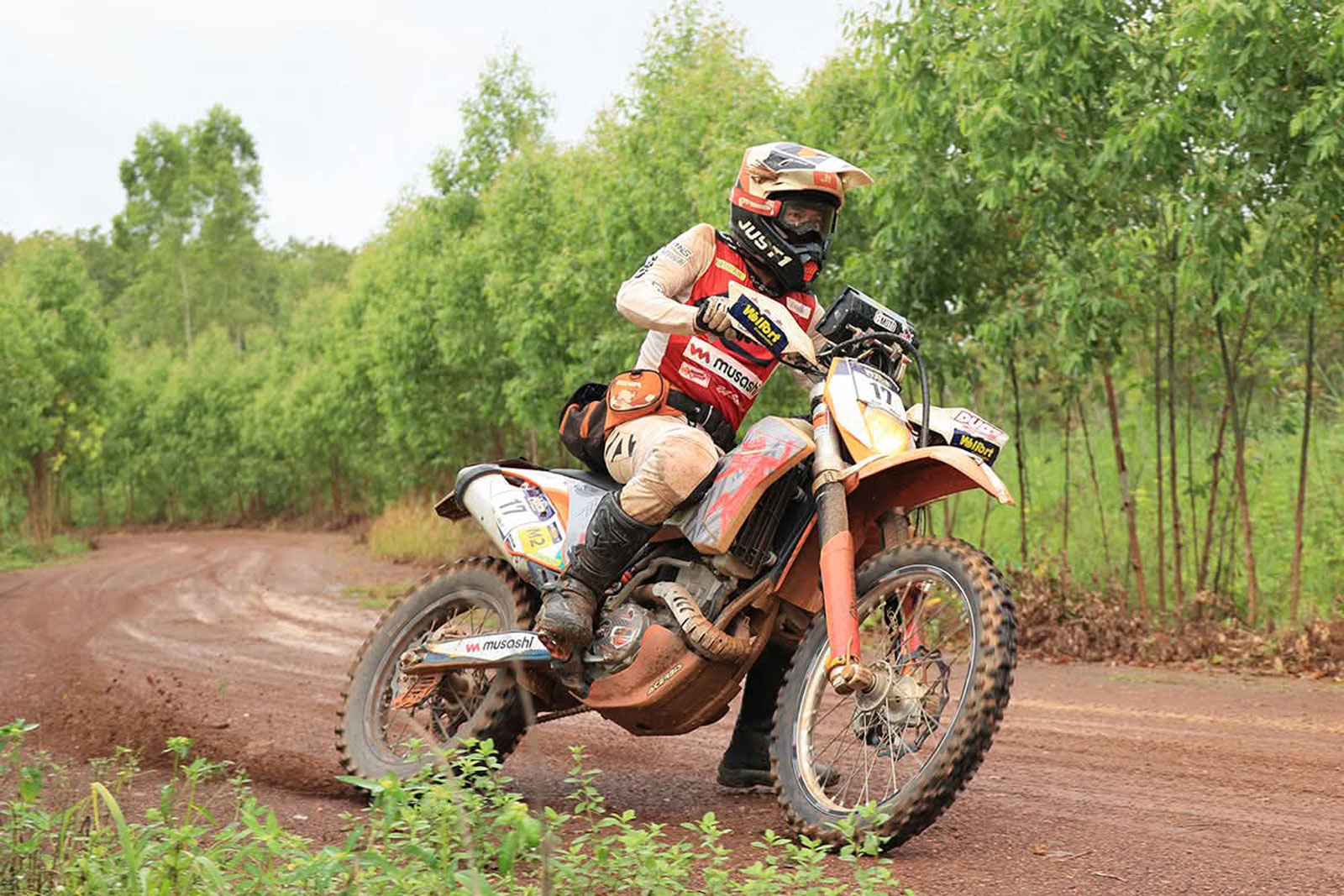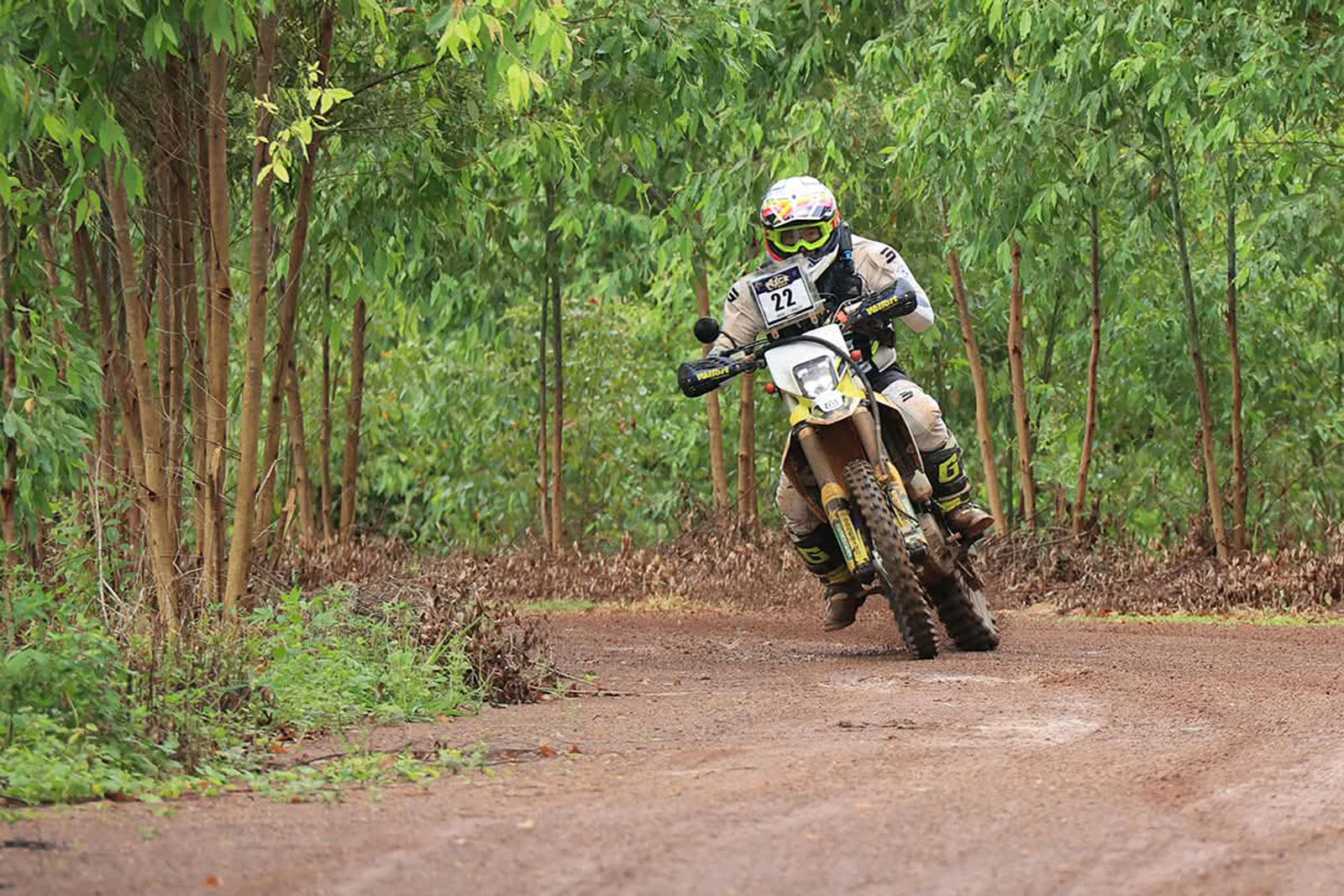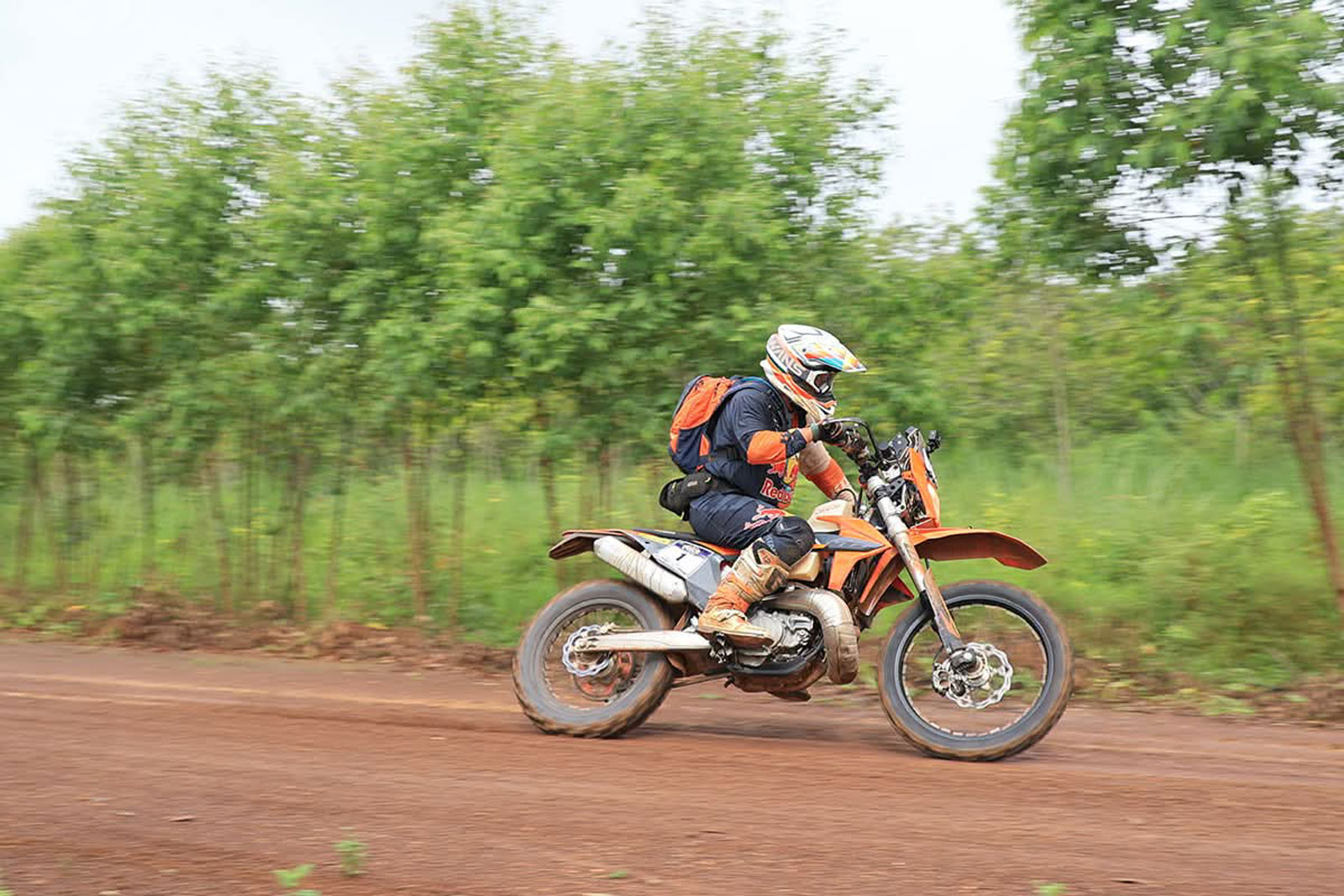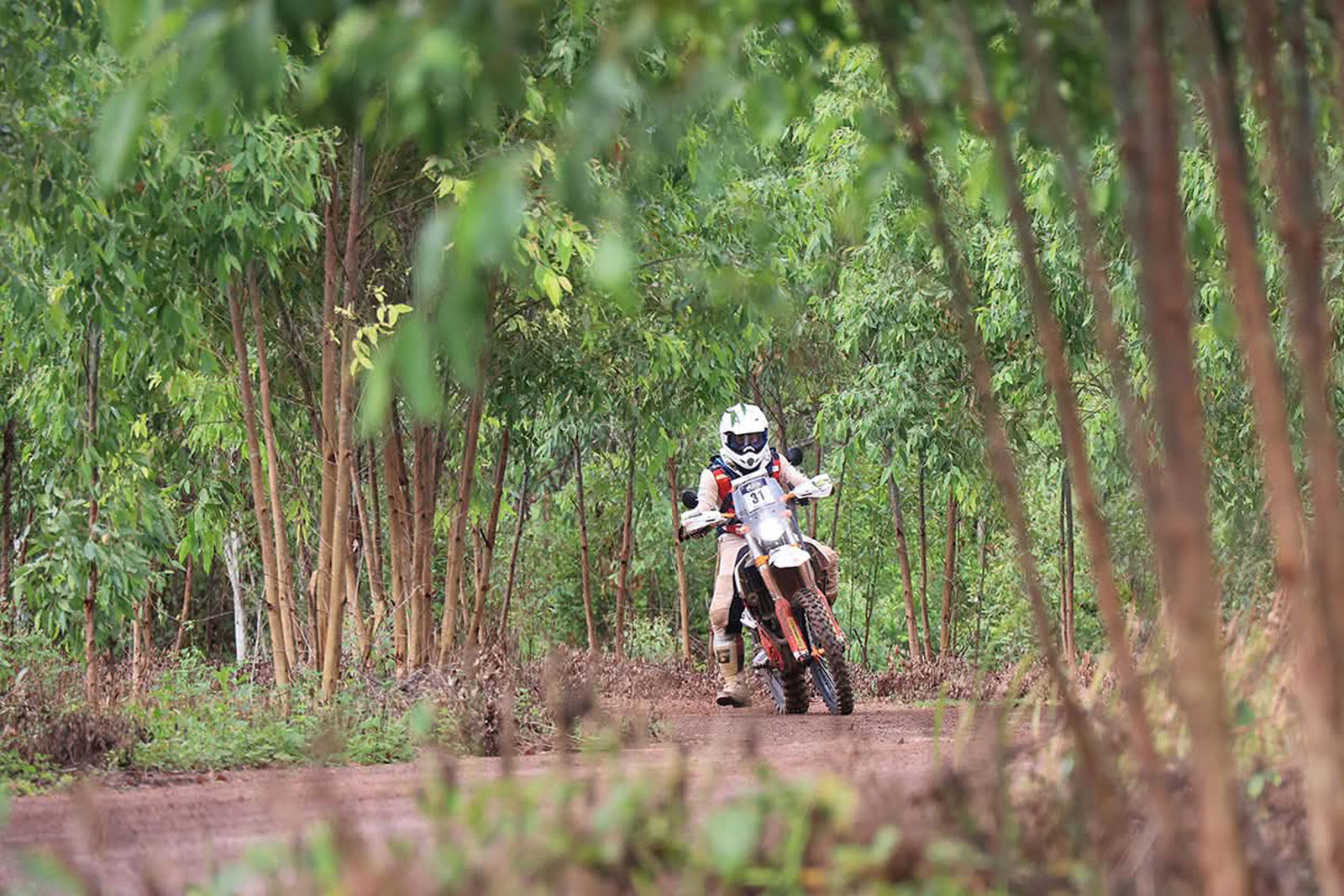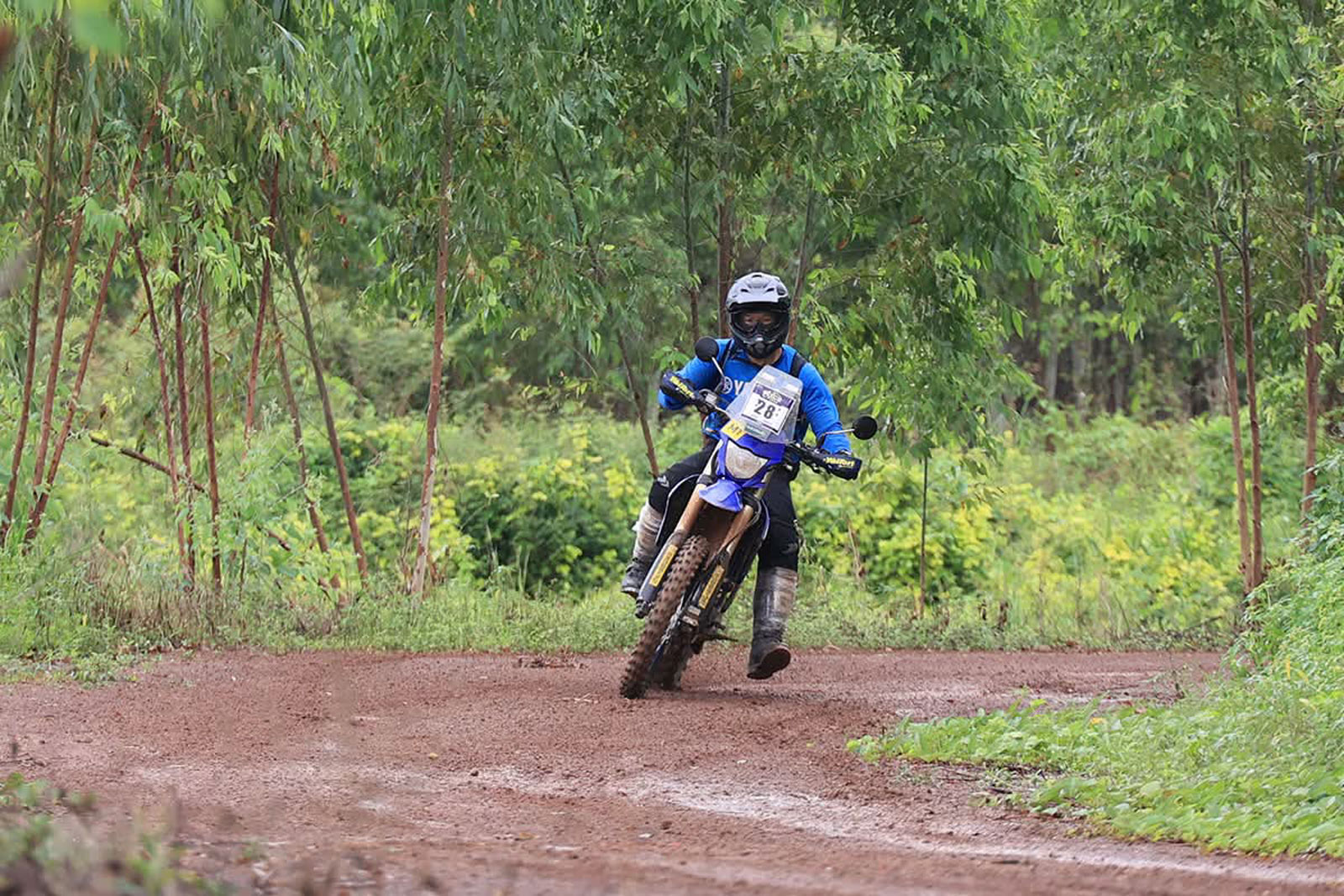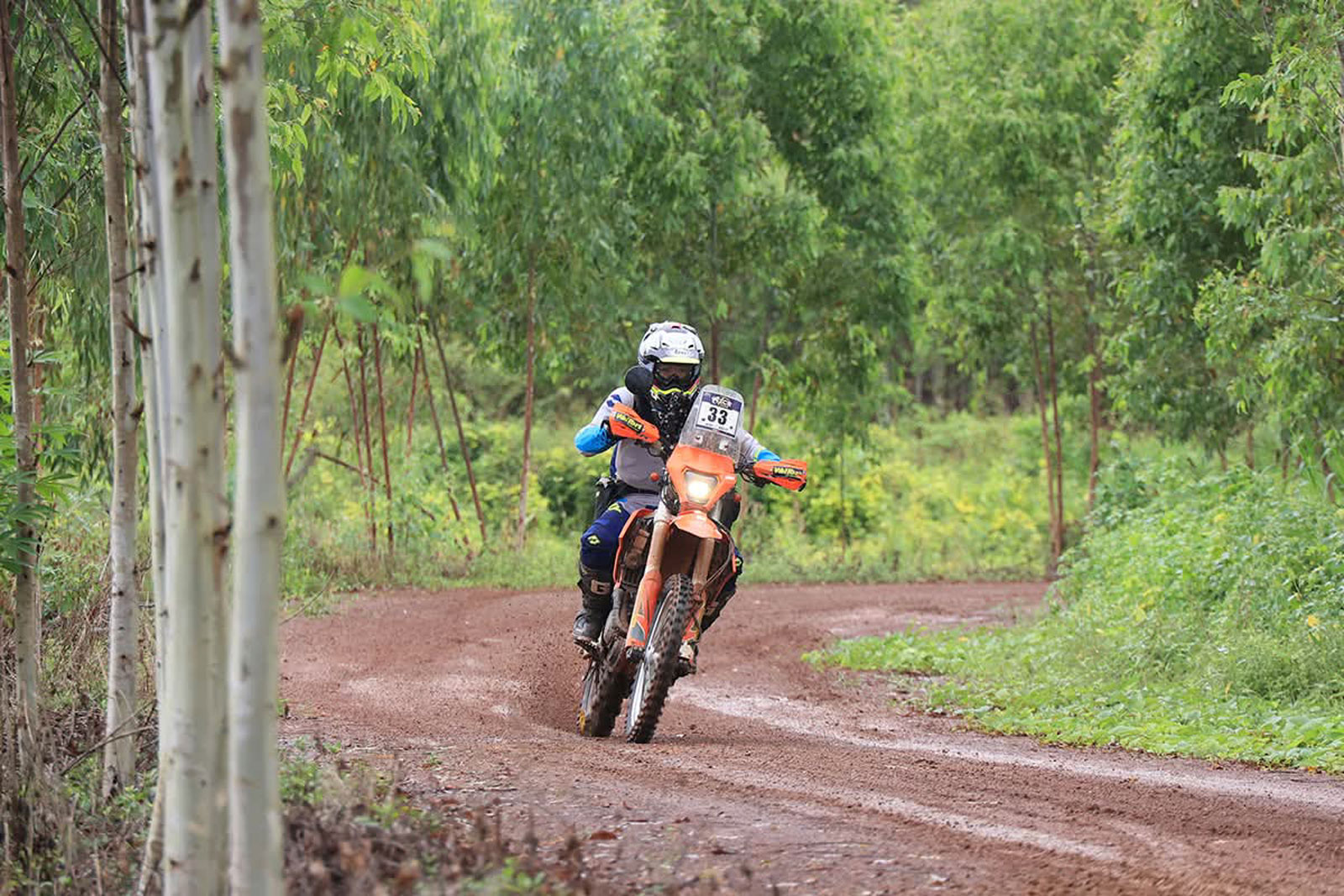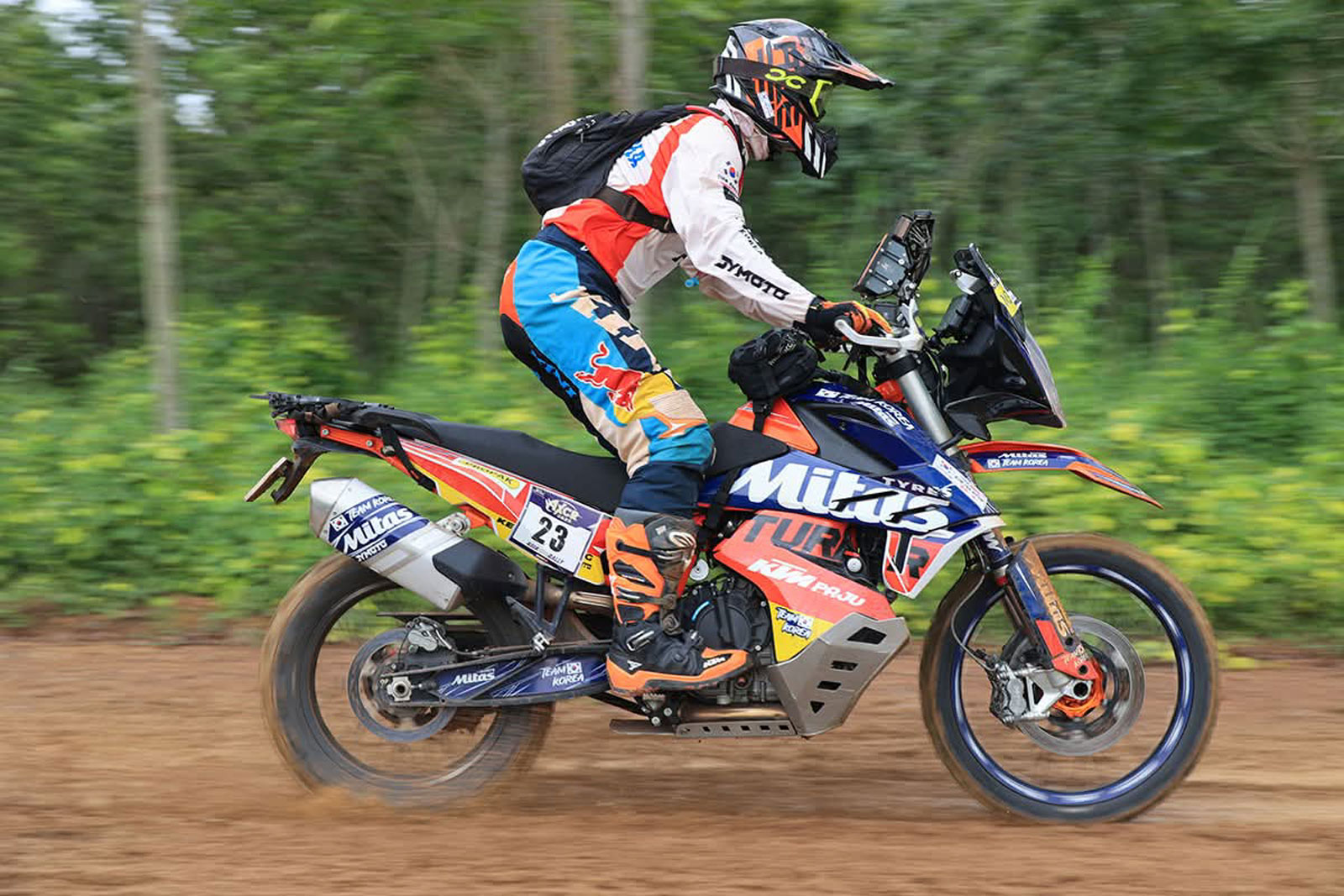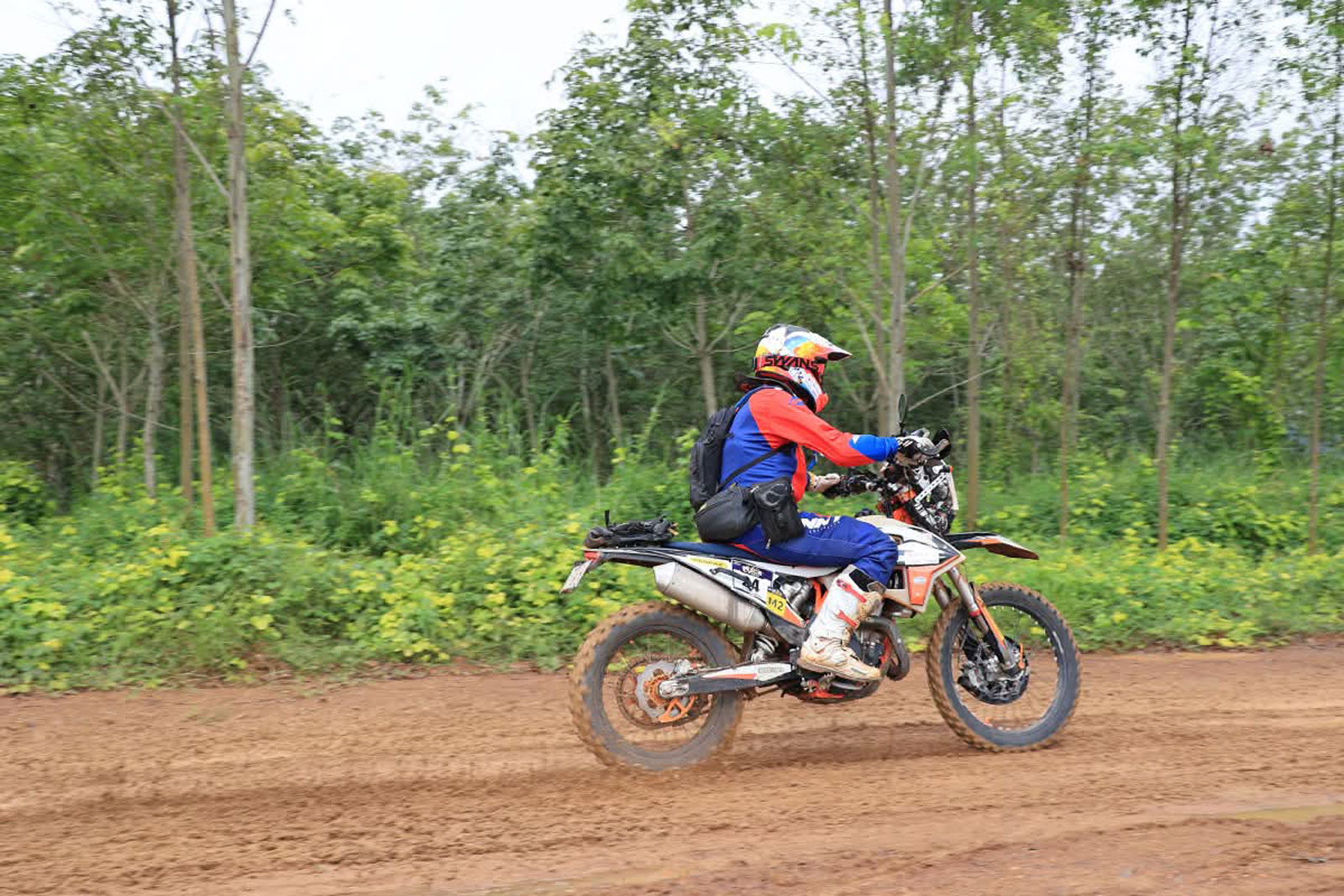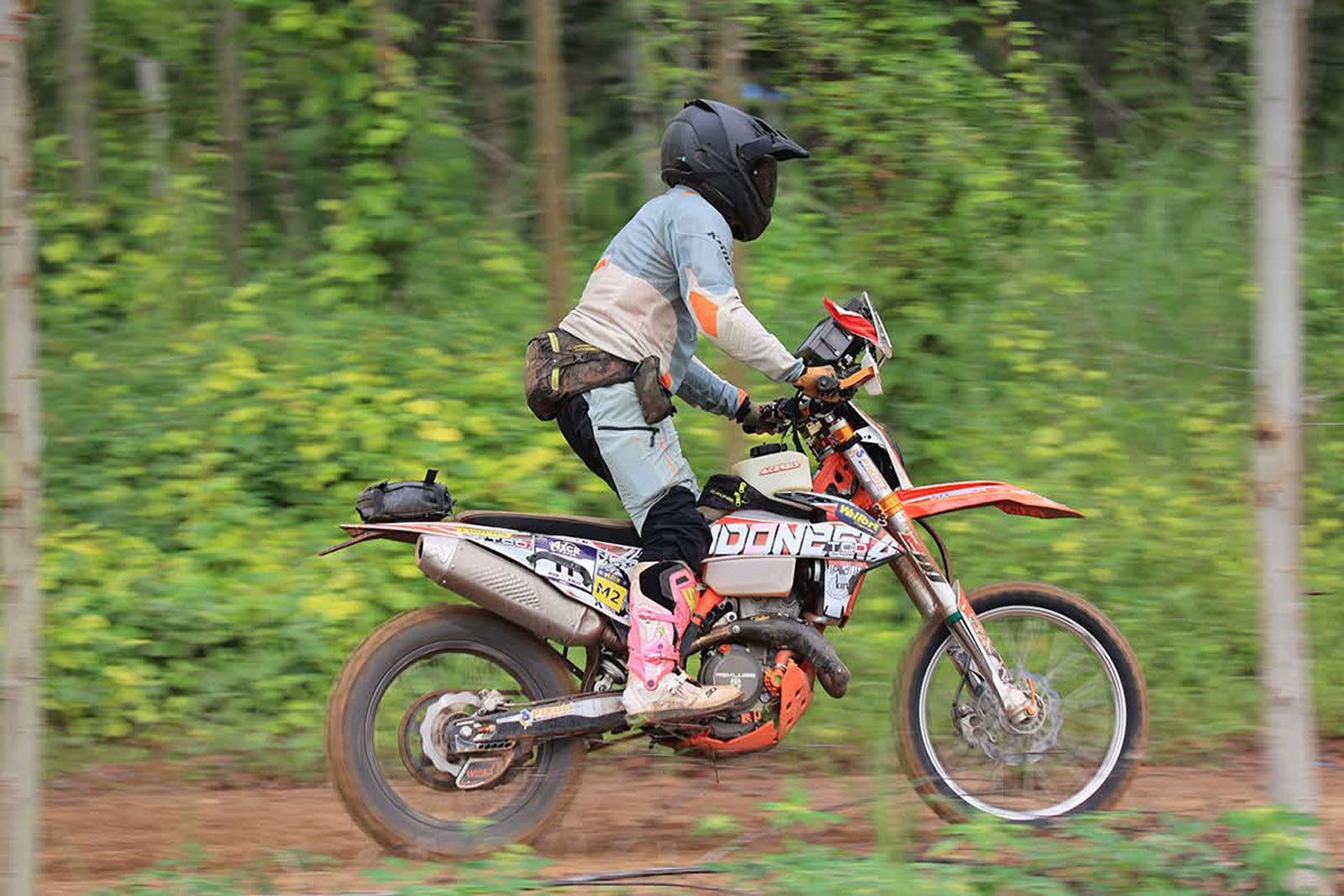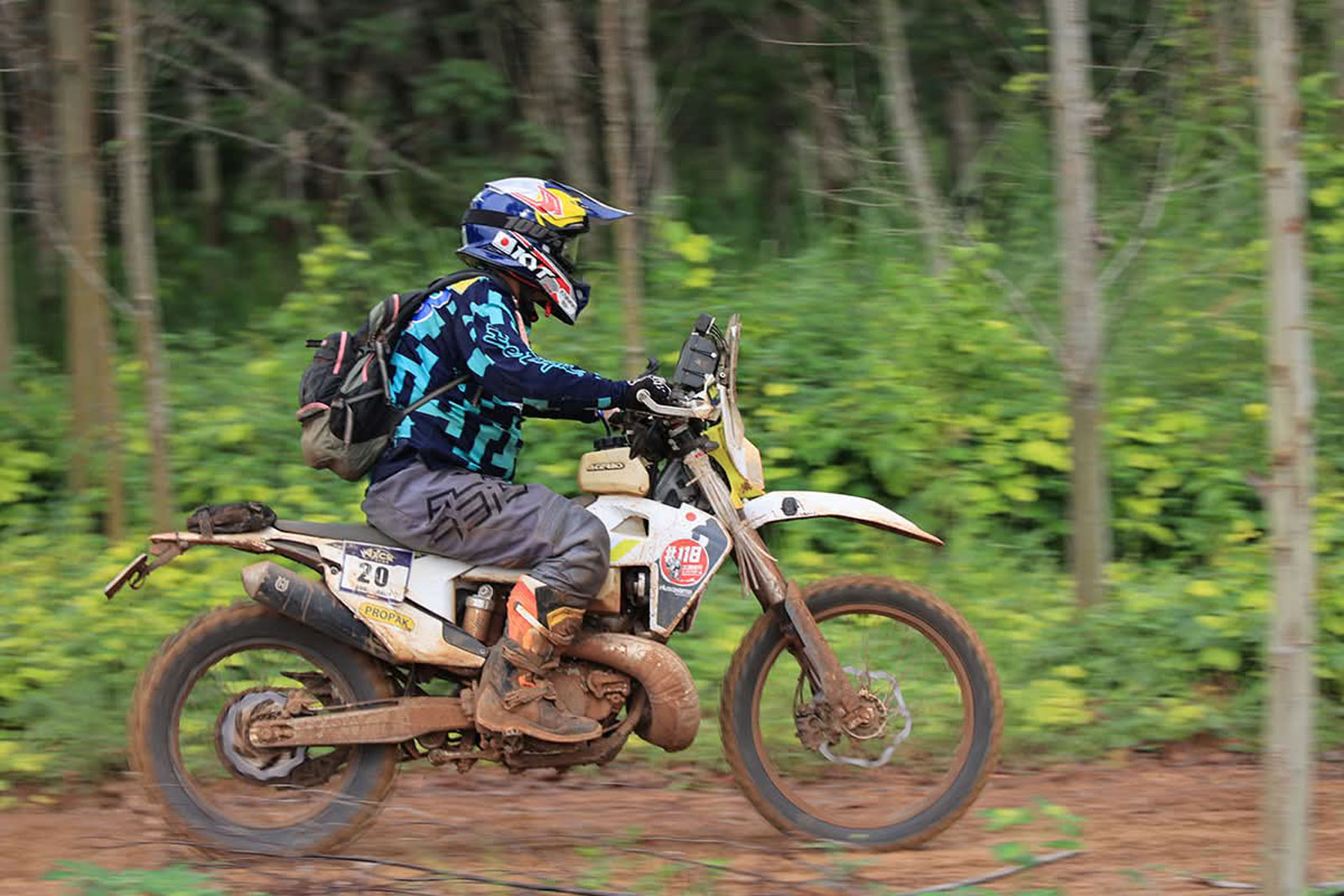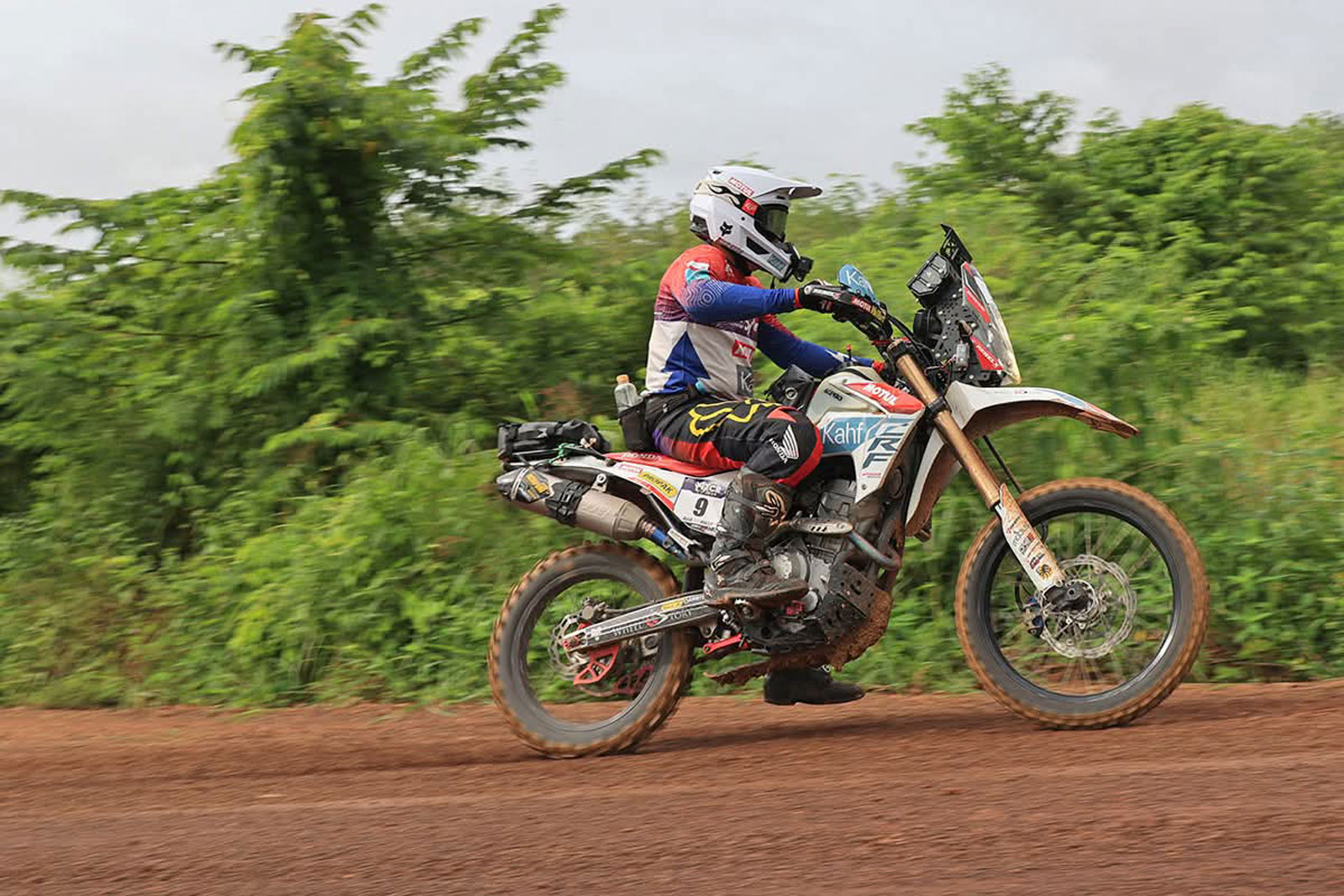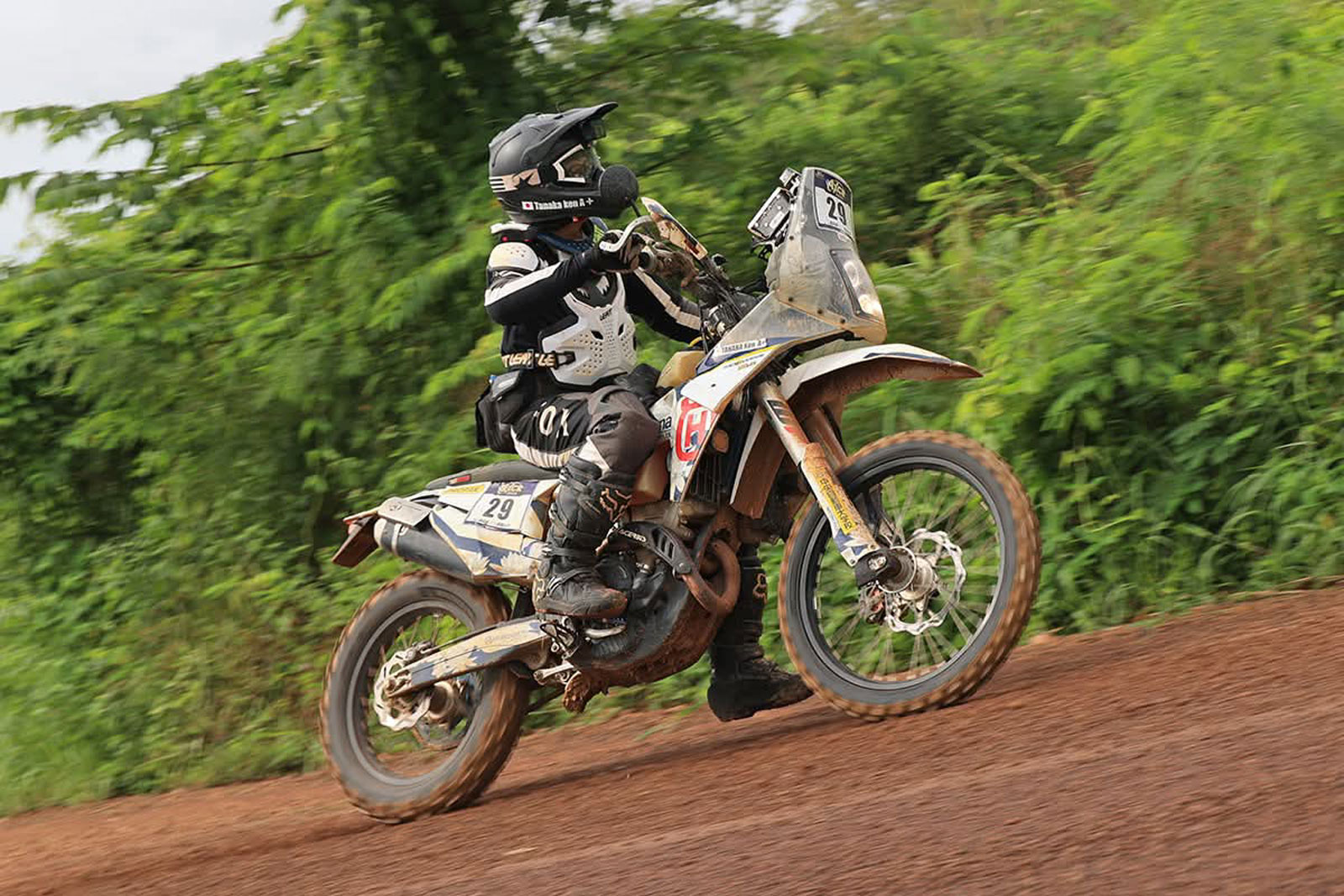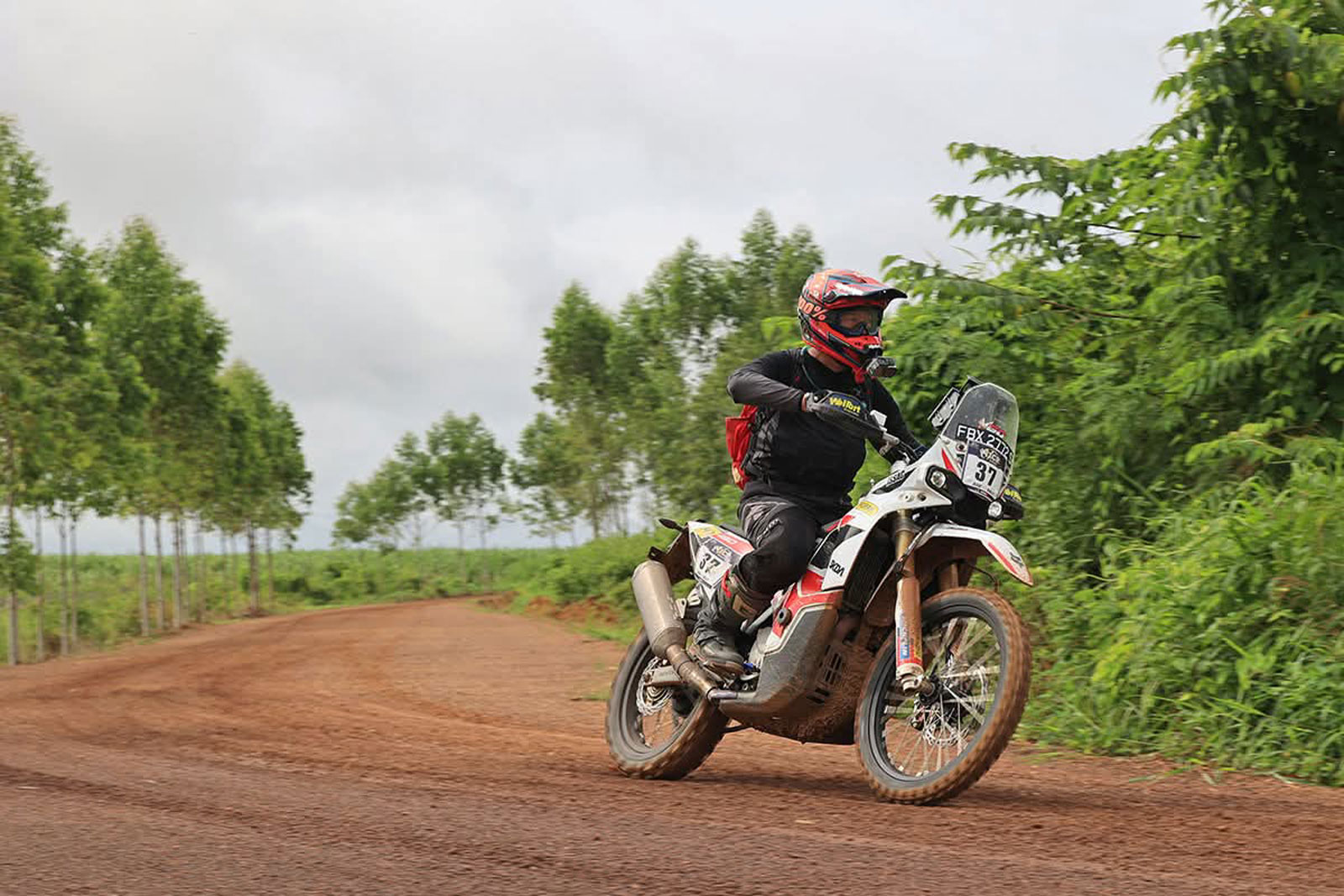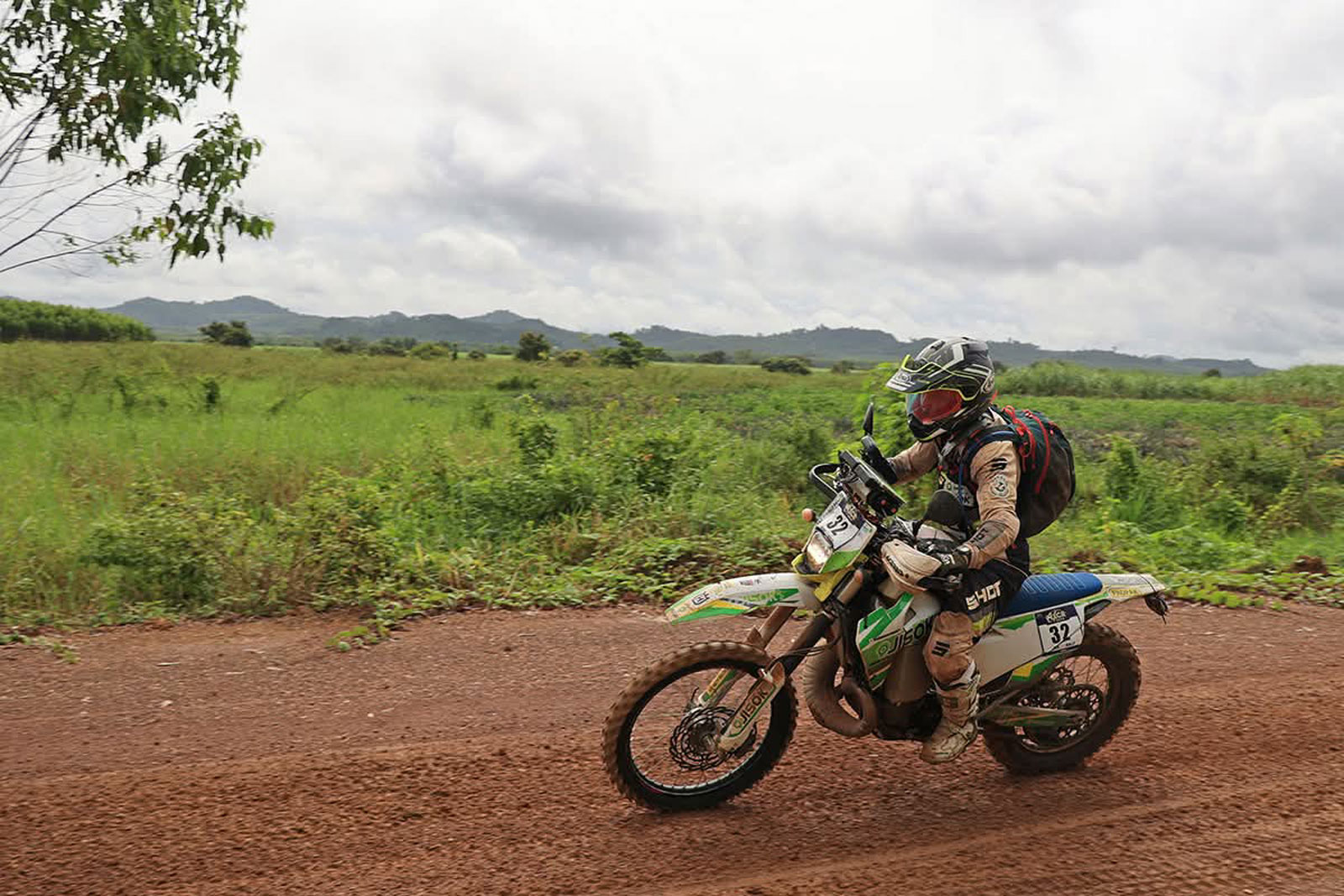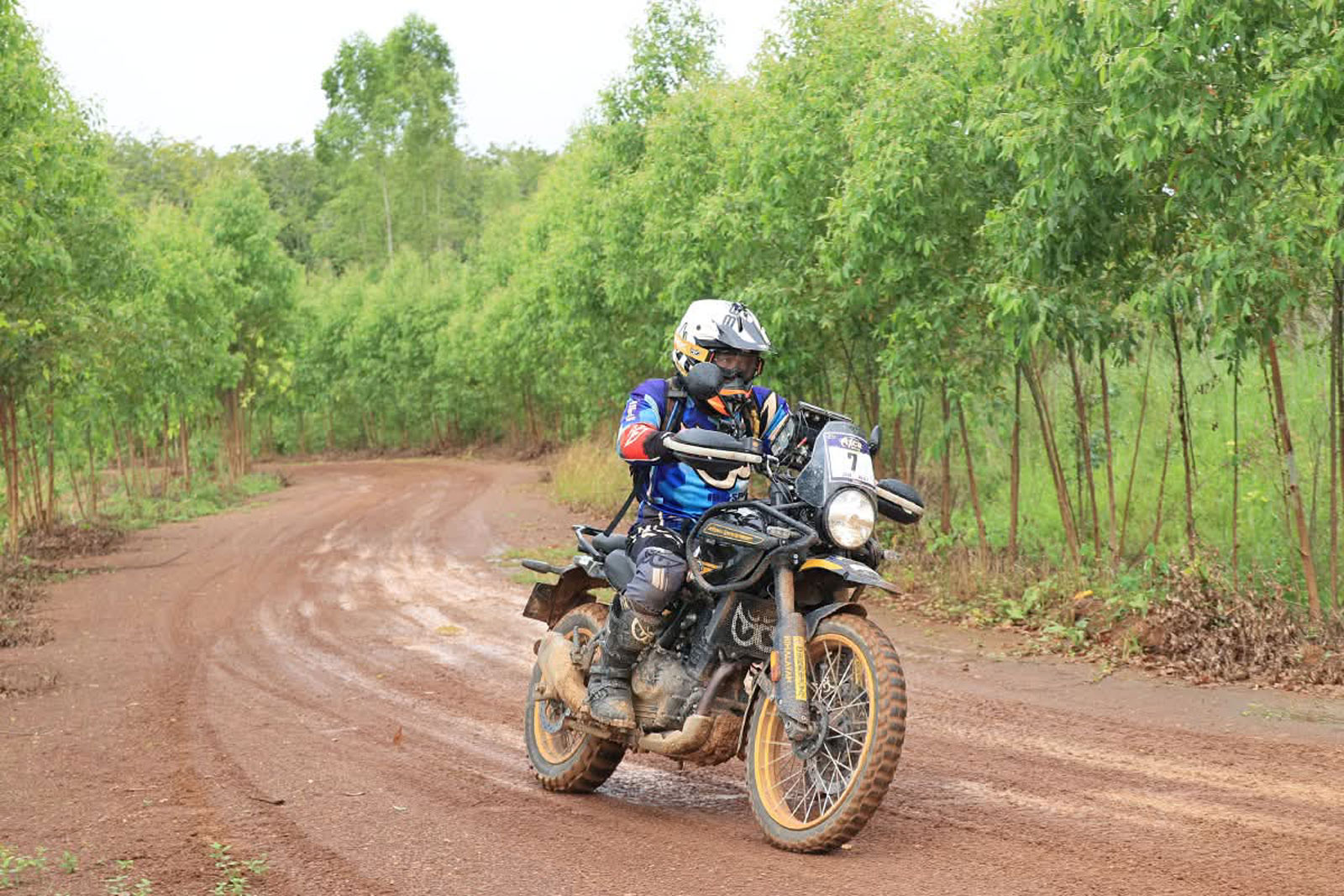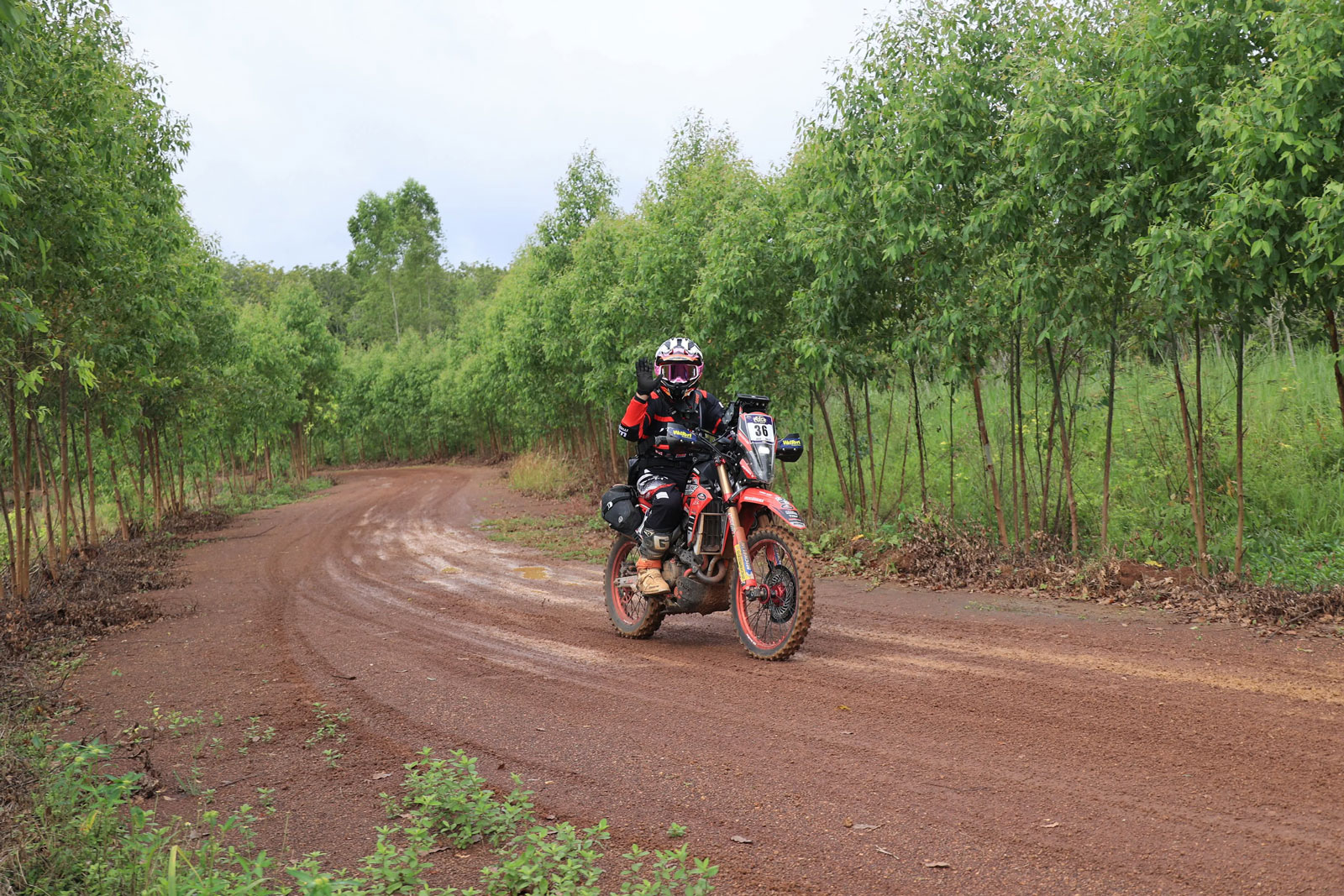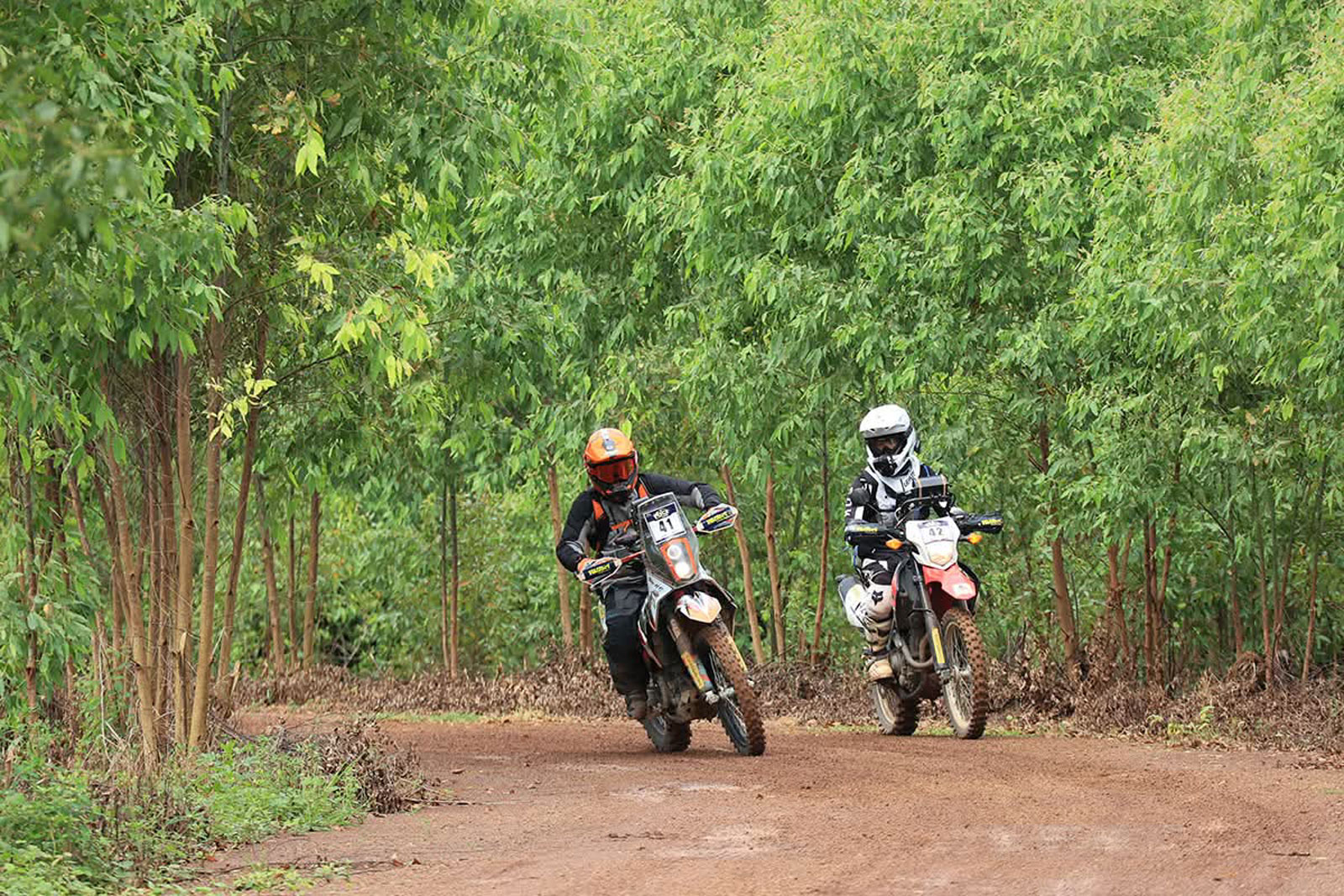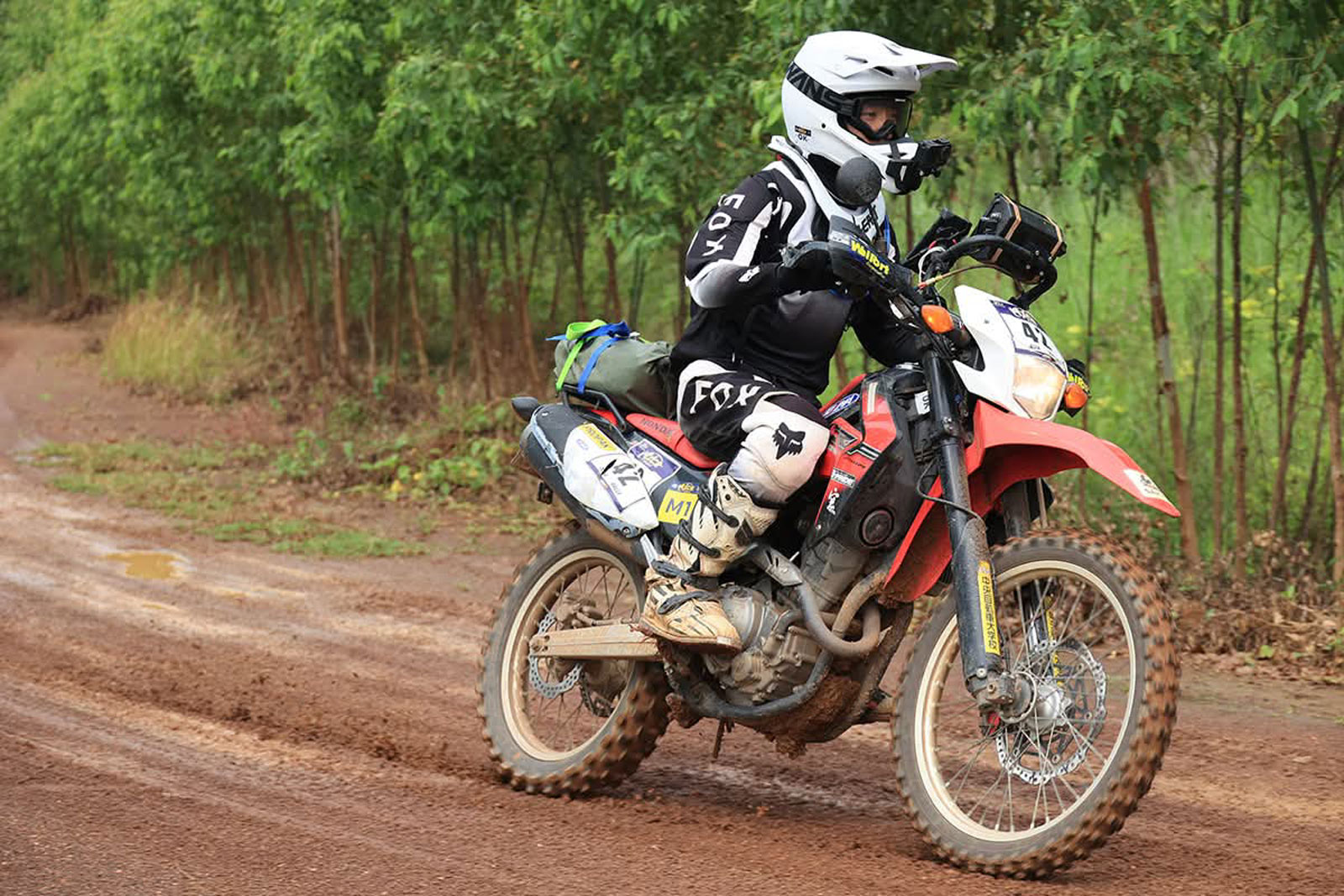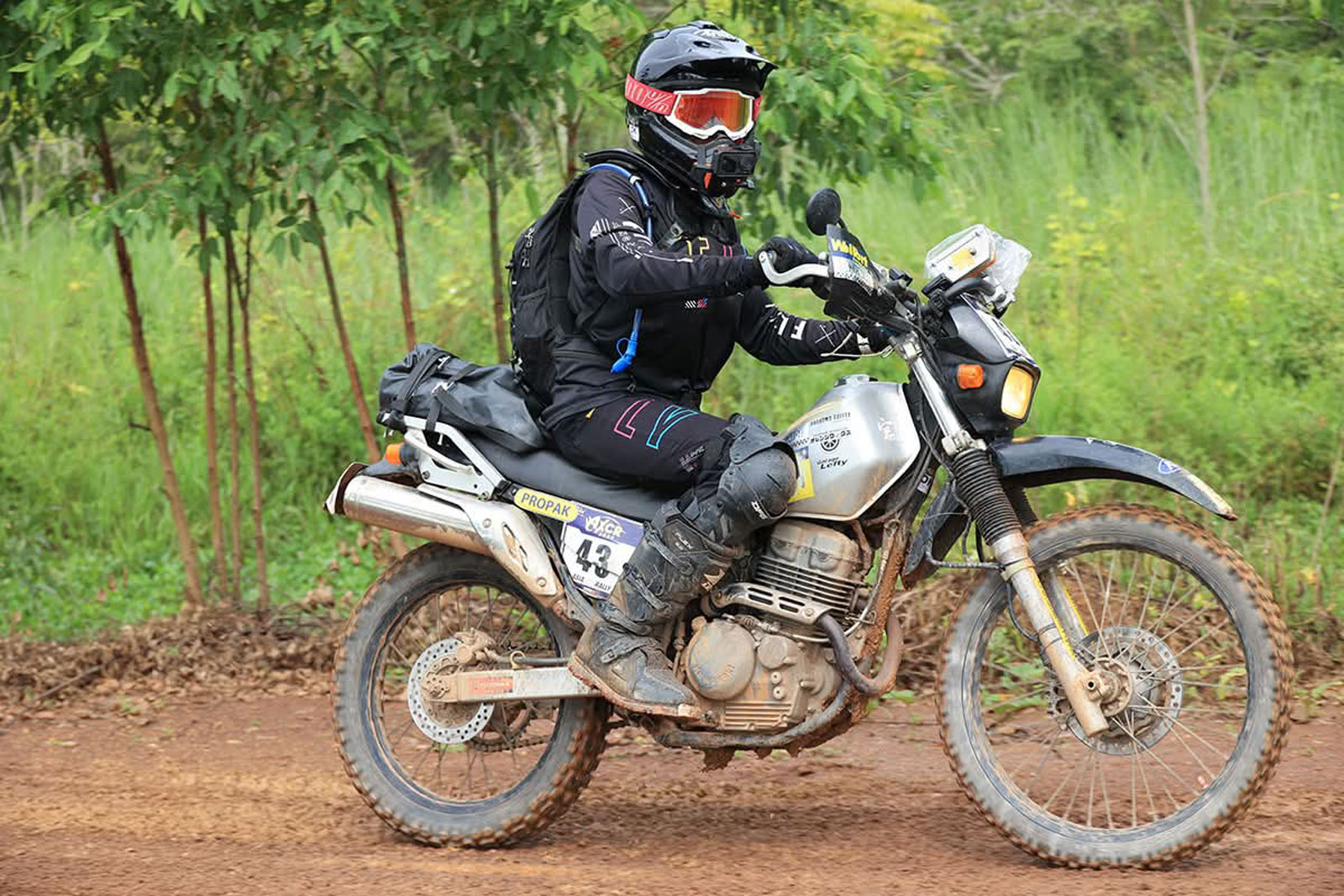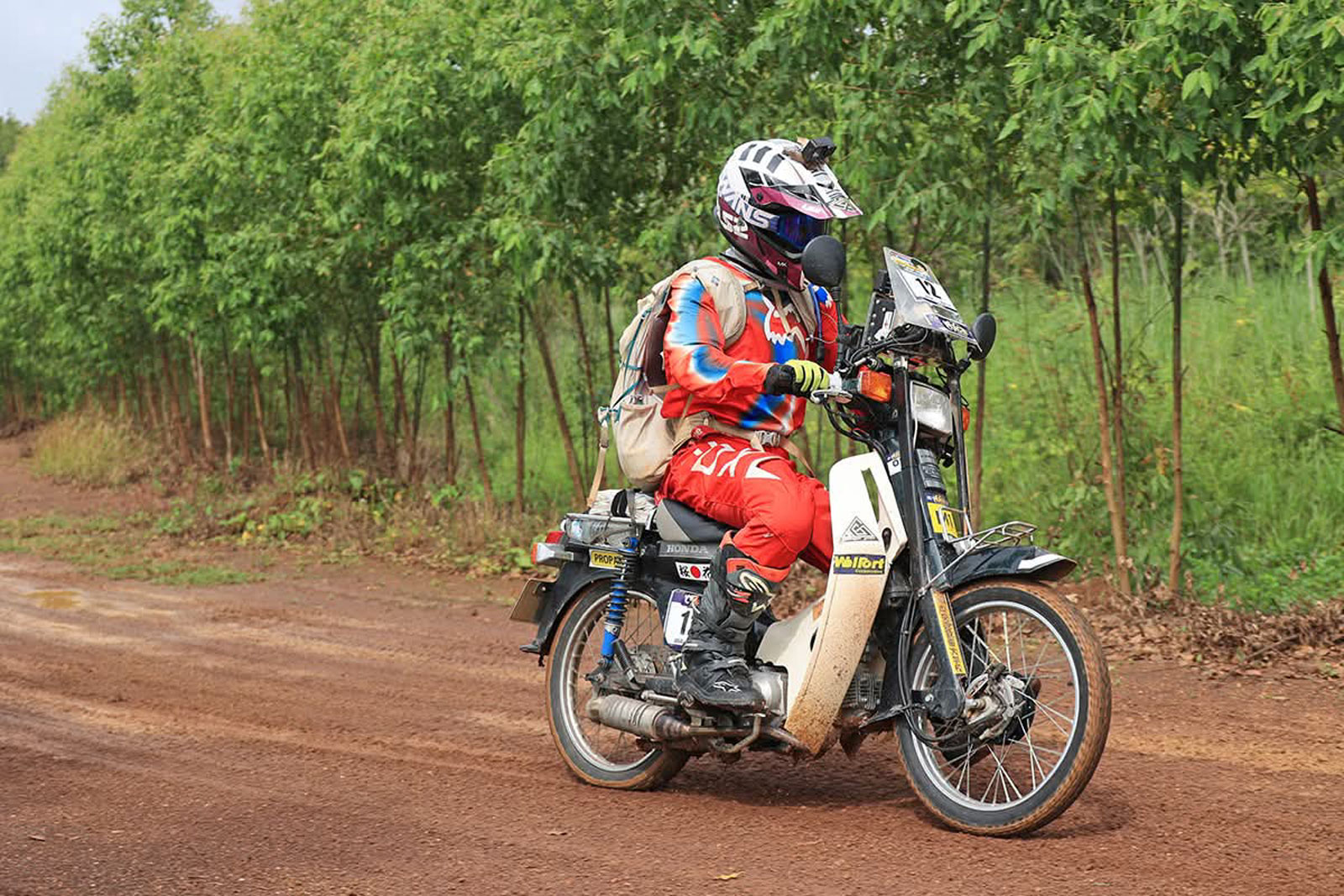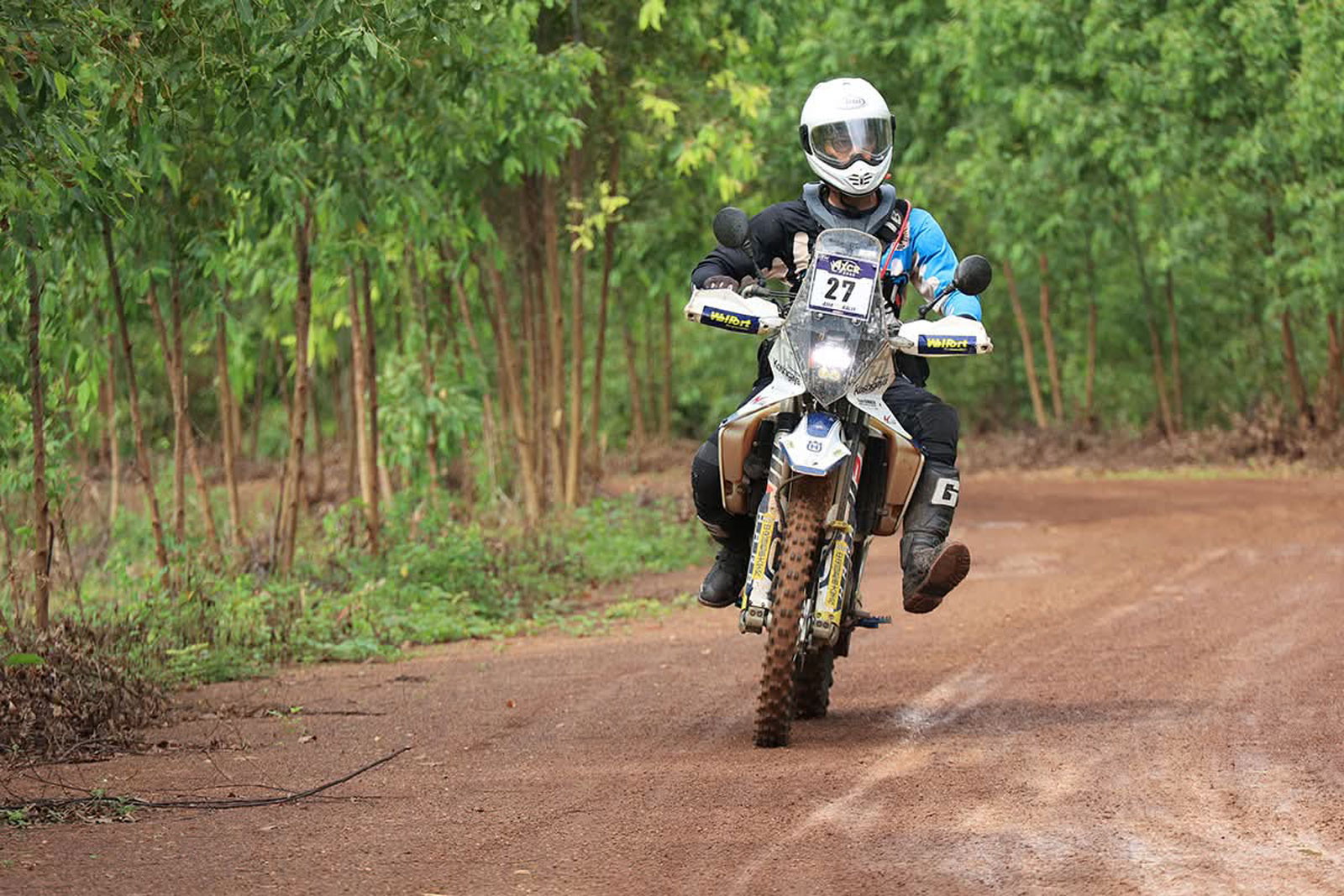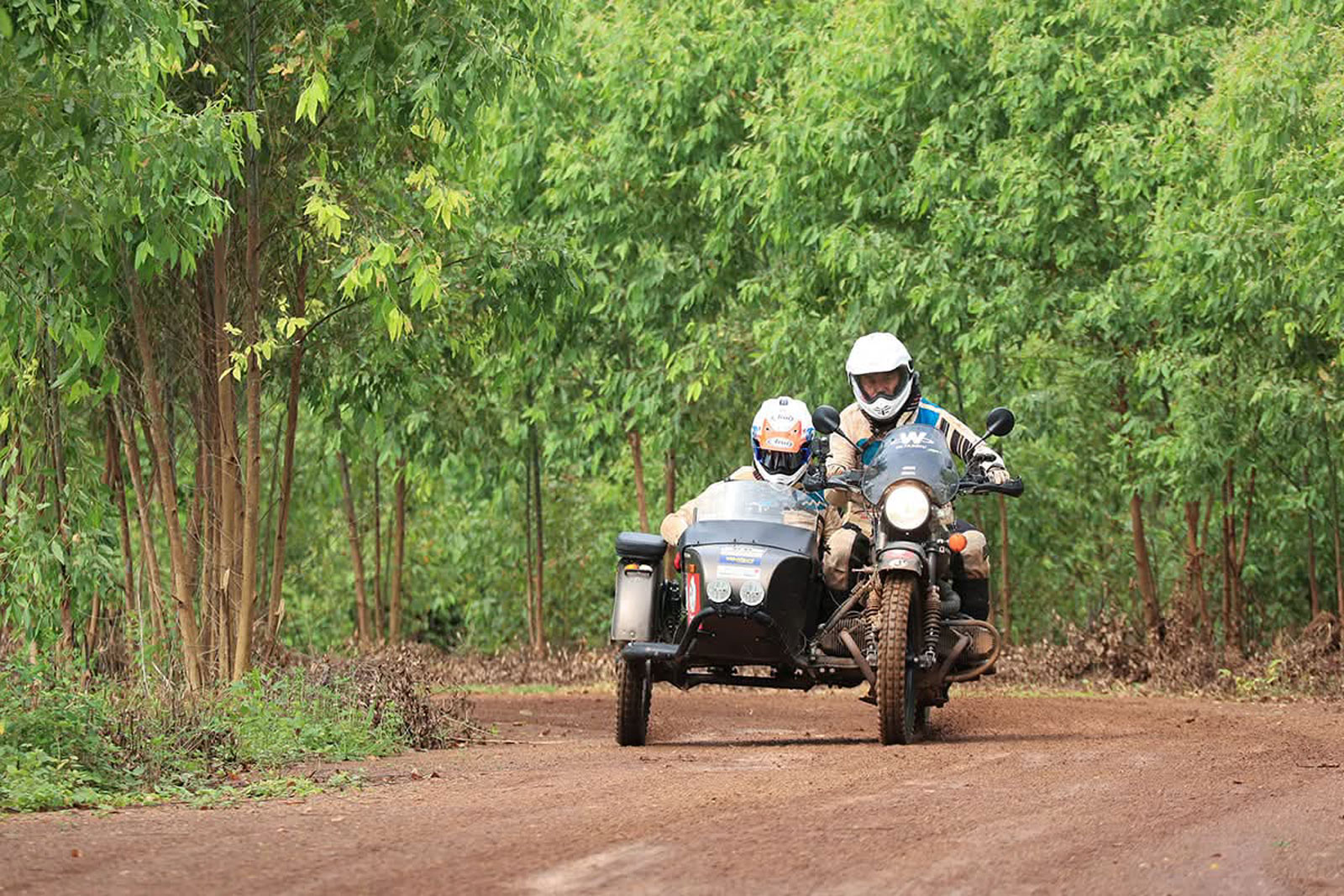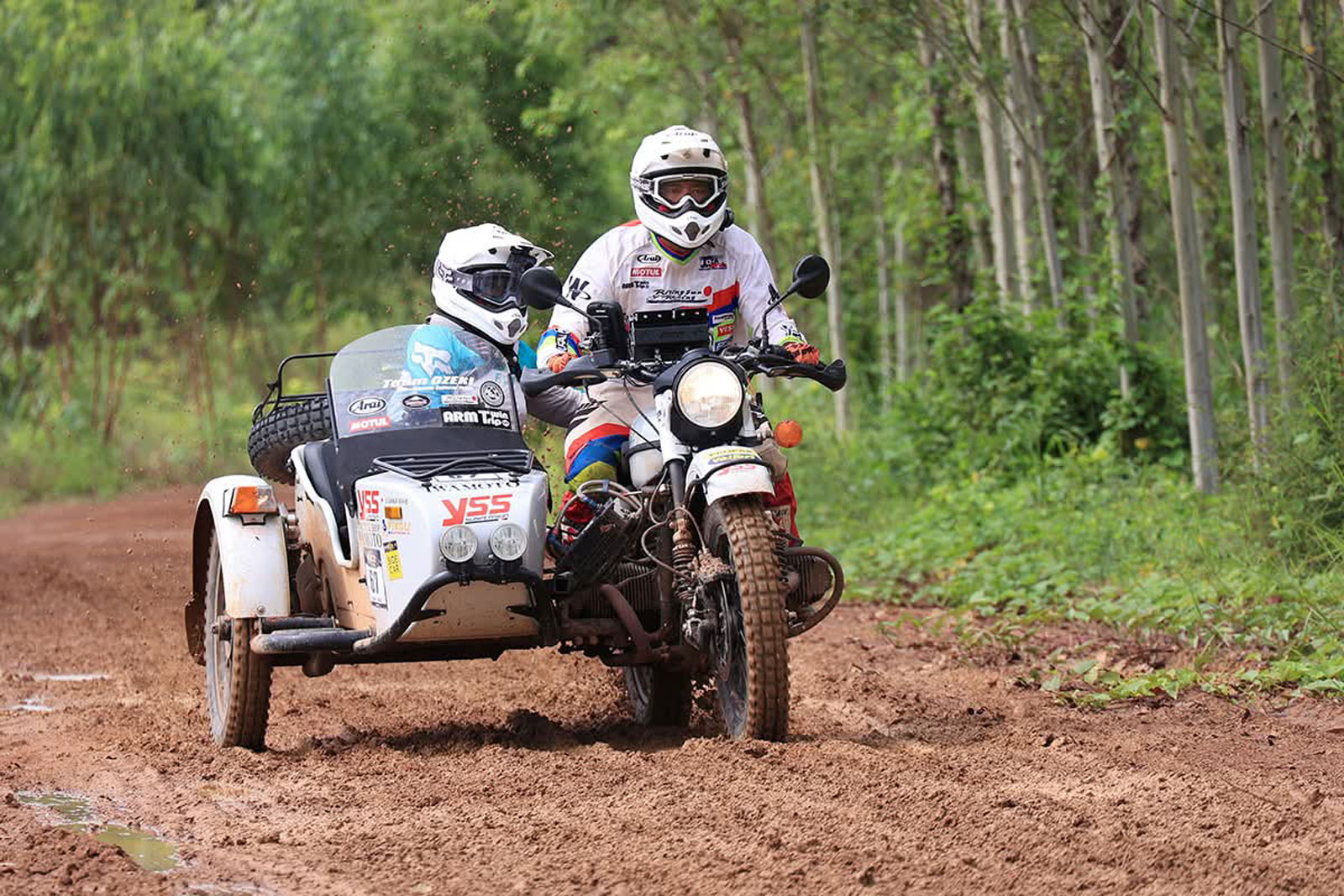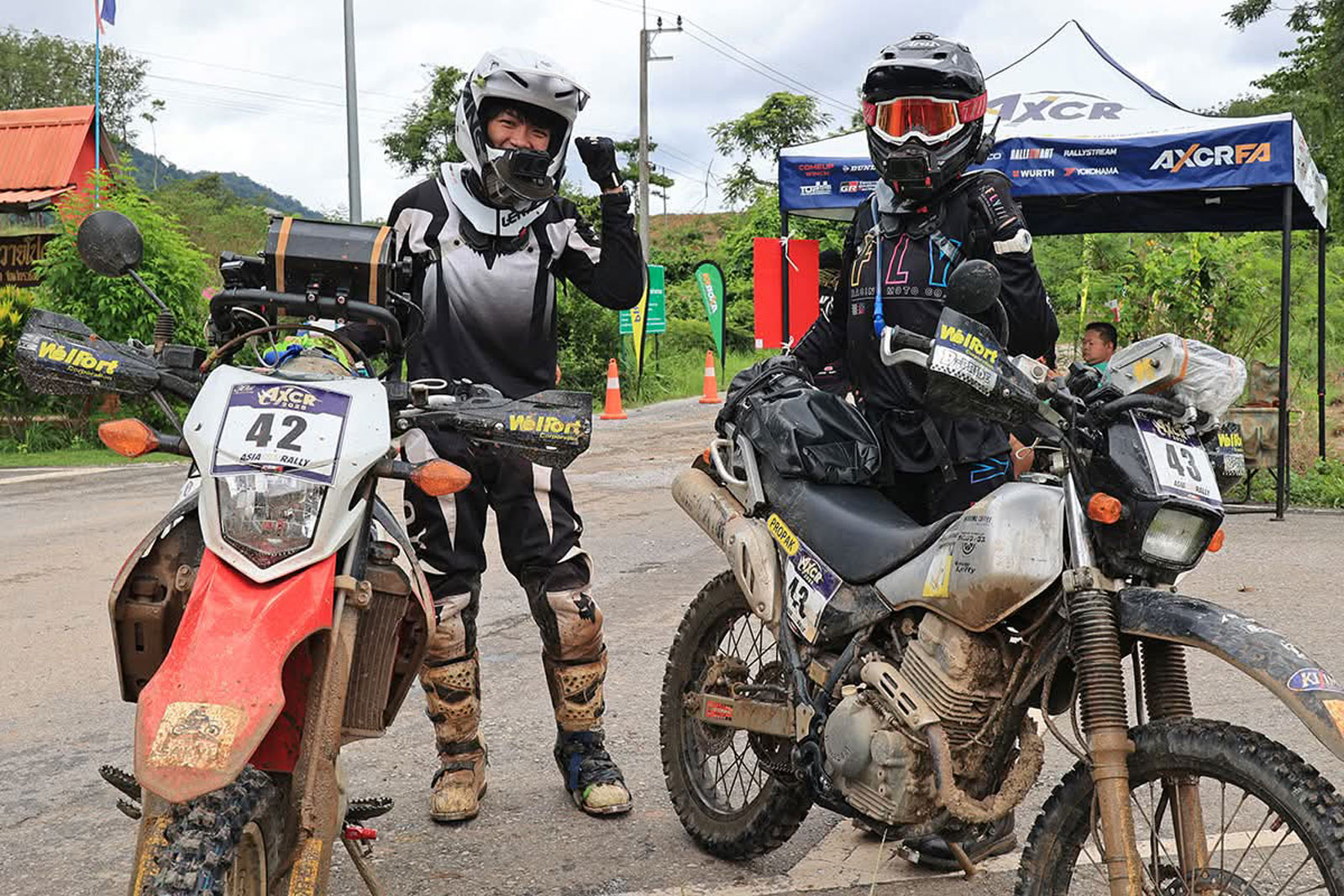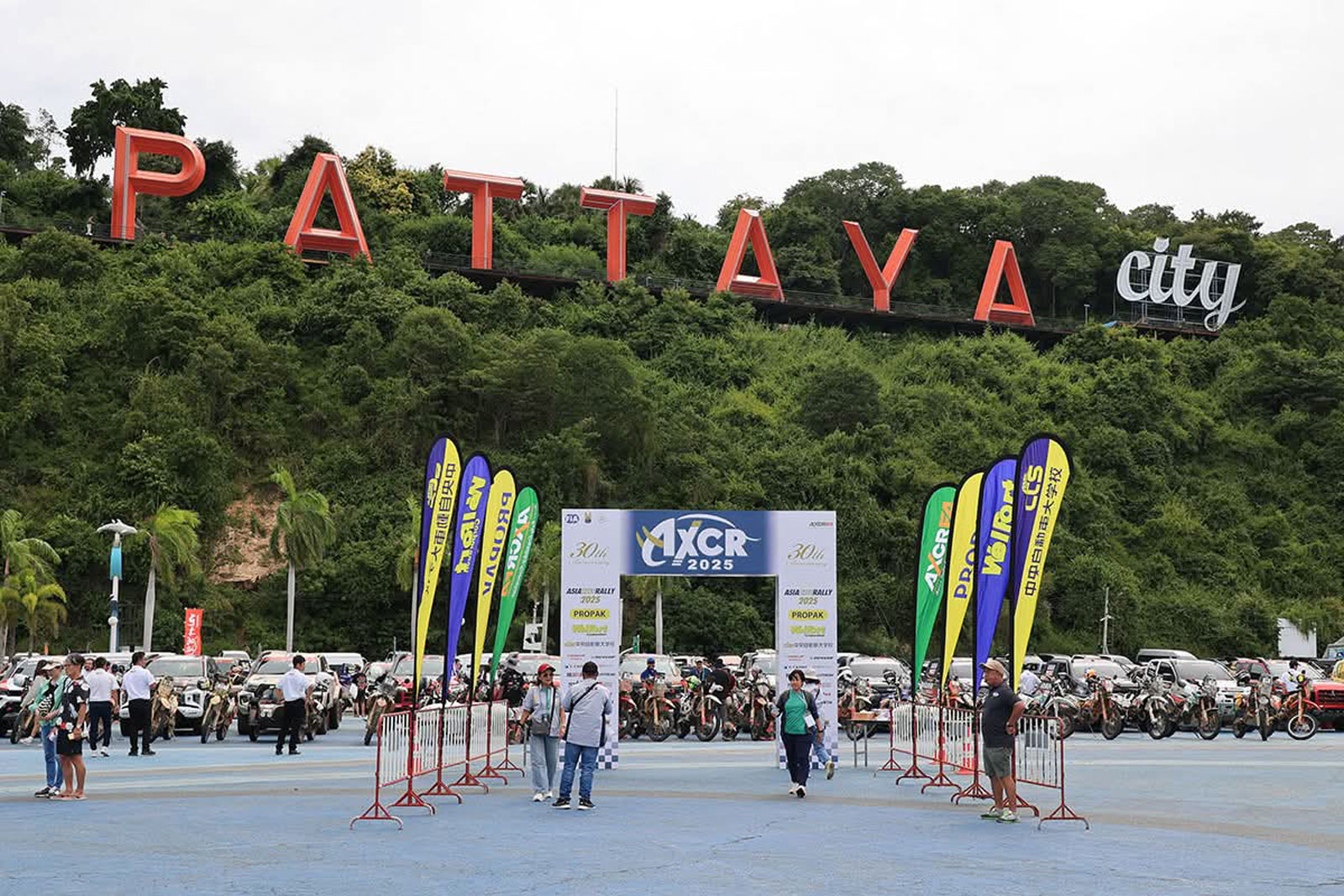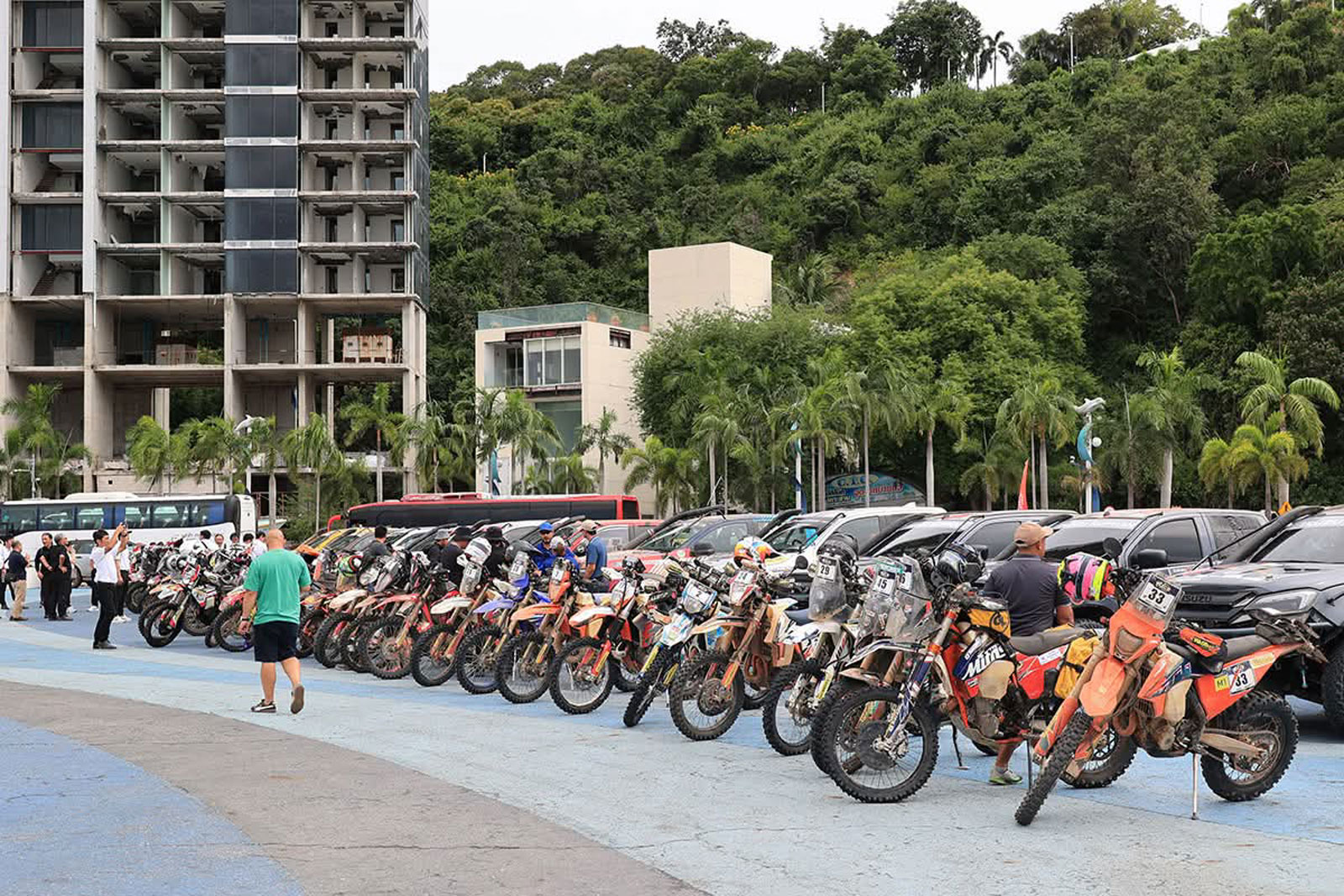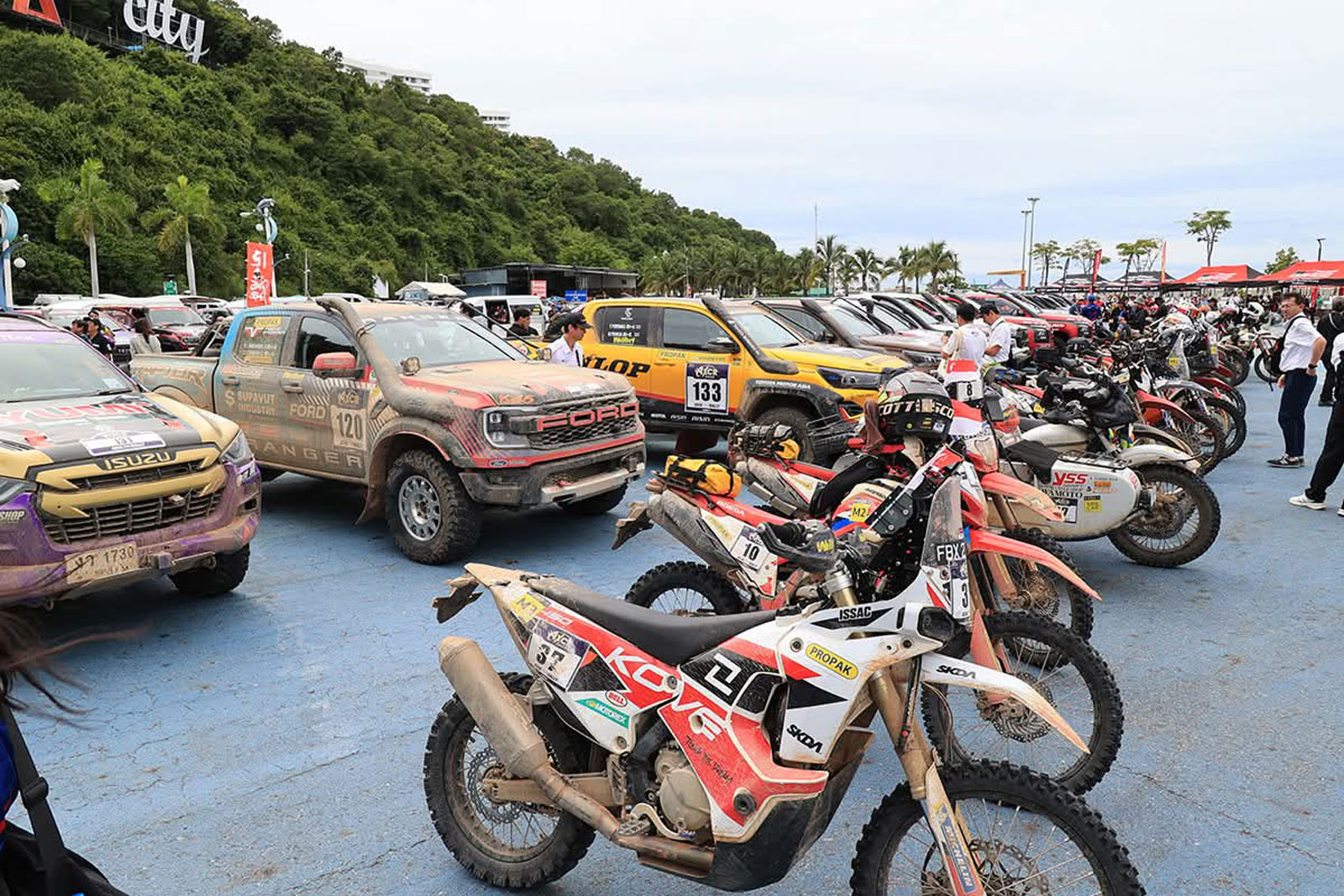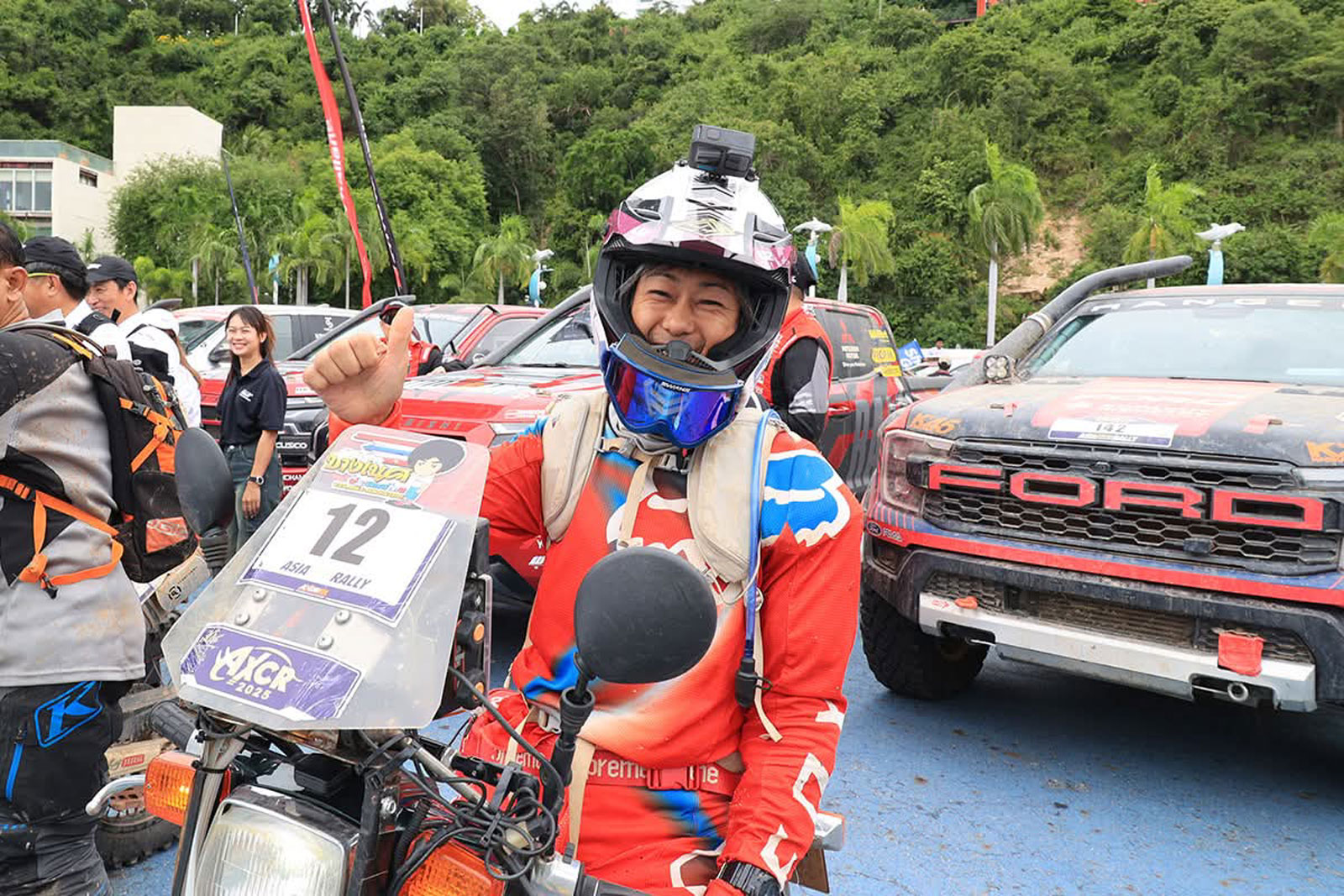

LEG8
Saturday, August 16, Pattaya
Team Mitsubishi Ralliart reclaims the four-wheel title for the first time in three years!
Yoshio Ikemachi wins the two-wheel title for the first time in seven years and for the fourth time overall!
The 30th Asia Cross Country Rally, held over 9 days from August 8, 2025, concluded all competition after completing its final special stage.
In the four-wheel category, the #112 Team MITSUBISHI RALLIART crew of Chayapon Yotha and Peerapong Sombutwong took the overall victory in their Mitsubishi Triton.
Driver Chayapon engaged in a fierce battle for the lead early on with the living legend of the AXCR, the Toyota Hilux driven by Natthaphon Angritthanon and Thanyaphat Meenil (#113 TOYOTA GAZOO RACING THAILAND).
Natthaphon took the lead in LEG1 with a 6-minute advantage over Chayapon in second place and maintained the overall top position with a steady performance on day two. Given that his record of seven consecutive wins up to 2019 was largely built on dominant runs from the first-day lead, some insiders were beginning to predict “Natthapon holds the advantage” this year too.
However, in LEG3, Natthaphon's Hilux suffered front suspension damage, causing a significant loss of time. Chayapon, who fought hard to finish third on the day, took the overall lead. This sparked a fierce battle for survival against the chasing Toyota, Isuzu, and Ford teams heading into the latter stages.
But this year's AXCR course was different and was indescribably tough. Endless, brutal bumps and ruts took their toll, gradually wearing down both cars and drivers. And in the most unexpected places, things broke in the most unexpected ways. Falling prey to this “extremely vicious road” – a rarity in recent years – wasn't just Toyota's Natthaphon.
During LEG5, the Isuzu D-MAX driven by Suwat Limjirapinya and Prakob Chaothale (#102 ISUZU SUPHAN YOKOHAMA LIQUI MOLY RACING TEAM), who were in 2nd place overall and trailing Chayapon by 11 minutes and 40 seconds, was transformed beyond recognition. During the SS attack, their ladder frame snapped and naturally, they fell out of contention for victory. Mitsubishi's Triton, driven by Katsuhiko Taguchi and Takahiro Yasui, also suffered suspension arm damage for the same reason. They had already lost over an hour in LEG3. As reported daily in this coverage, numerous other machines broke down as well.
Amidst this, as many rivals dropped out due to metal fatigue and troubles stemming from the relentless run of “super” extreme terrain, overall leader Chayapon also suffered an accident in LEG5. The vehicle was stuck in deep mud and the loss time it took to recover sank his result to 9th place, 12 minutes behind leader Katsuhiko Taguchi.
Here, rising like a phoenix from their earlier struggles, was the Toyota Hilux of last year's champions, #101 TOYOTA GAZOO RACING THAILAND's Mana Pornsiricherd and Kittisak Klinchan.
They showed a furious comeback with 1st place in LEG3 and 2nd in LEG5, rising to 2nd overall, 14 minutes behind Chayapon. They continued to chase the leading Triton with strong times daily, taking 1st in LEG7 and 2nd in LEG8, but unfortunately, it was too little, too late. Mitsubishi's Chayapon, who drove steadily to 2nd and 5th place after LEG7, held on to win by 7 minutes and 51 seconds, claiming the overall victory in this prestigious commemorative event.
Chayapon secured his second victory in three years since his first win at the 2022 event held post-COVID. He demonstrated remarkable consistency with a 50% win rate across four attempts, including one third-place finish. Additionally, Mitsubishi finally achieved the coveted “Triton victory” they desperately wanted.
Here are the overall ranking changes by LEG this year. While Chayapon seemed to hold a steady lead from the mid-season onward, the battle with #101 Mana, who steadily improved his form as the season progressed, was fierce. With excellent vehicle handling, their intense, almost possessed battle was spectacular, as if their fighting spirit had merged.
Here, we should highlight the #142 Feeliq Innovation Motorsport team of Bailey Cole and Sinoppong Trairat. Their Ford Raptor is a “T2A” vehicle, based on a production car with strictly limited modifications. Amidst results dominated by modified cross-country vehicles (“T1”), their T2A achieving 3rd place overall shines particularly brightly.
Bailey Cole is a rare American driver in the AXCR. He's a professional off-road driver who accepted the Ford team's offer to compete as a spot entry from North America. In his debut, Bailey started 26th on Day 1 but finished with the 11th fastest time. He then steadily climbed the overall standings, ultimately securing the honor of 3rd place overall.
Looking at his daily standings: 11th, 8th, 4th, 5th, 8th, 7th. Driving the large Raptor through jungle trails must have felt vastly different from racing across the vast horizons of American desert races. Yet, he managed to navigate these rough surfaces without veering off, pushing the car to its limits while driving so carefully yet quickly.
In any case, Bailey proved to us that American racers can compete in Southeast Asian jungles, and that the Ford Raptor is tougher than anyone imagined.
Let's return to Chayapon. The time is just before the final SS on the last day. Nearly 40 cars, having finished the morning road section, lined up in starting order at the entrance to the special stage. Drivers and navigators made final tire pressure adjustments, chatted with mechanics and media. The usual jovial pre-start scene unfolded, but only Team Mitsubishi Rally Art's Team Manager Hiroshi Masuoka, standing at the start line, had eyes that remained sharp, fixed intently on a distant point.
In fact, at this moment, Chayapon's Triton—the car entrusted with the team's fate—had stalled during the RS. The nightmare of losing the lead late last season flashed through the minds of Mitsubishi personnel. No, nearly every driver and co-driver who passed the broken-down car was almost certain Mitsubishi would suffer misfortune for the second consecutive year. Because the start was just two minutes away.
But then, a single red machine appeared like the wind.
The third Mitsubishi Triton, driven by Kazuto Koide and Eiji Chiba, arrived at the scene. They identified the cause, made repairs, and brought car #112 back to life. It turned out to be a simple plumbing issue.
But the trials continued. Only on the final day, the starting order was based on overall standings, not the previous day's times. Chayapon had to start ahead of #101 Mana's Hilux; otherwise, an RS time-over penalty would be imposed.
Chayapon's heart must have been about to leap out of his mouth and the waiting Mana was probably thinking, “My rival won't show up now.” But, a miracle happened. As the official clock ticked down to one minute before the start, the #112 machine slid in front of the #101 machine.
“Thirty seconds, ten seconds, five, four, three, two, Go!” Chayapon shot out like an arrow.
“That was heart-stopping... Well, he'll probably make it through the last 60km or so!”
A smile returned to the eyes of Team Manager Masuoka, who had been wryly smiling.
Then, at the service area after the finish. Driver Chayapon, honking his horn repeatedly as he entered, stopped right in front of the service crew. Instantly, he and co-driver Peerapong scrambled up onto the roof of the Triton. There, they raised high the Ralliart flag covered in countless messages and waved it vigorously. The Team Mitsubishi Ralliart pit was already a whirlwind of joy. A small tear glistened in Director Masuoka's eye.
“Success isn't born from one person's strength. It's born from teamwork. We are Team Mitsubishi Ralliart!!” Chayapon's heartfelt sentiment, later posted on social media, was encapsulated in the small fist pump he made while gripping the raised flag.
And this day was also Chayapon's birthday. Exactly one year had passed since that dreadful day when the engine stalled just 2km from the finish. Using that frustration as fuel, he gave himself and the team the greatest gift possible this year.
The four-wheel team awards saw Team MITSUBISHI RALLIART (#105, 112, 118) take first place, TOYOTA GAZOO RACING THAILAND (♯101, 113, 133), and third place went to ISUZU SUPHAN YOKOHAMA LIQUI MOLY RACING TEAM (♯102, 103, 110).
Team Mitsubishi Ralliart fought tooth and nail against reigning champions Toyota and claimed victory in fair and square fashion. This past year began with reflection on engine troubles, followed by daily trial and error seeking a setup that balanced high output with high durability. They also undertook on-site training to hone crucial navigation skills for the AXCR. The year 2025 saw them take on the challenge with the motto ‘Third time lucky with the new Triton!’ – a last-ditch effort. Their efforts bore splendid fruit. It also produced a young, energetic, and clever hero: Chayapon.
However, precisely because of this, it was undoubtedly a contest decided by the narrowest of margins against rival teams. The ever-increasing speed of the competition and the historically rare, exceptionally treacherous terrain. What became apparent at this 30th anniversary event, where these two factors converged, was a new form of cross-country rally, where the highest levels of ‘building vehicles that won't break on any terrain’, ‘driving fast without breaking down on any terrain’, and ‘navigation skills that won't lose their way on any difficult course’ were fused together.
Asphalt, dirt, mud, rocks, sand, repeated river crossings and endless stretches of water-logged terrain. Is there another rally where the road surface changes so drastically? Is there another rally where such intense undulations persist endlessly? Is there another rally where the weather shifts so dramatically, and where the human element is so profoundly felt?
Despite unavoidable cancellations, we wish to pay tribute to every entrant who conquered nearly 2,500 kilometres of ever-changing terrain to reach the finish line, and to every challenger who, though regrettably forced to retire, gave their all.
Time flies like an arrow. Thirty years that felt long yet passed in the blink of an eye. The AXCR has passed a milestone and is now marking a new era. The organisers travelled to Cambodia this year and have not forgotten the frustration of not reaching Phnom Penh. Our friends in Cambodia and Vietnam, who regrettably had to withdraw, are surely waiting eagerly too. Look forward to next year's Asia Cross Country Rally, unchanged, taking place right in the middle of the rainy season!
Moto
Six Japanese riders ranked in the overall top 10. Although it was expected to be a long race, the eight days flew by in the blink of an eye.
On the eighth and final day of the race, LEG.8, the morning was not particularly intense, but the rain that had started the night before continued to fall. The red clay flat dirt track along the lakefront in the first half of the SS route was damp with moisture, waiting for the riders to start. In Thailand during the rainy season, thunderstorms are a common occurrence every night, but as dawn broke, the rain gradually subsided, and by midday, strong sunlight streamed through the gaps in the clouds.
Describing the unpaved roads of Thailand as ‘red soil’ has become a cliché, but once you see it, you can't help but agree. The roads are truly ‘red soil,’ a brick-red colour mixed with fine gravel, stretching on endlessly.
With the finish ceremony scheduled for the afternoon, this day's total distance of approximately 327 km was slightly shorter than usual, with about 120 km designated as SS. The first half of the route, spanning approximately 60 km, featured straight sections, gentle curves, and sharp corners, with occasional glimpses of a lake on the right-hand side. Though it may seem monotonous due to the lack of elevation changes, this terrain allows riders to clearly feel the machine's handling through throttle work and weight transfer, making it an enjoyable stage for riders.
One characteristic of this red clay surface is that there are areas that grip even when wet, and others that offer no grip at all, resembling a sheet of iron coated with grease.
This is likely due to the texture of the soil—whether it is sandy or powdery. Powdery soil, when dry, forms a fine, light powder that hardens like foundation makeup, and when scraped by tyres, it turns into dust that swirls in the air and lingers for a long time. Conversely, when moist, it transforms into a sticky, slippery paste.
On wet red clay dirt roads, it's hard to tell at a glance whether the surface is sandy or powdery, making it a tricky spot, especially when accelerating. Among them, the aggressive riders who charged past the camera at the filming point were Sumaetee (#17/ Team Musashi International / KTM 250 XCW), and Izumoto, who is making his second appearance from Japan (#22 / TEAM JISOK-RR / HUSQVARNA FE450). In fact, the two riders' section times were several minutes faster than the others.
Apart from these two, I don't think there were any other riders who showed off counter steering (cornering by turning the handlebars in the opposite direction). This is a dynamic move that is visually appealing and gets the camera crew excited. Incidentally, Izumoto checked the tension of the wheel wires every day, but it seems that one of them broke. That shows how much stress was being put on them.
The latter half of the SS took place on a rough road between vast forests and plantations, with ‘water holes’ deep enough to completely submerge the tyres.
Looking at the final day's overall standings, the top contenders who had been competing for the lead every day were once again in the top positions.
Ikemachi (#16/Team Musashi International/HUSQVARNA FE350), who first participated in the Asian Rally (Asia Enduro) in 2001, secured his fourth overall victory, while Jakkrit (#46/JC DIRT SHOP/KTM 500 EXC-F), the champion from Thailand, finished in second place. Similarly, Sumaetee (#17/ Team Musashi International / KTM 250 XCW) finished third, while Izumoto (#22 / TEAM JISOK-RR / HUSQVARNA FE450) remained in fourth place, and last year's winner Matsumoto (#1 / Indonesia Cross Country Rally Team / KTM 250 EXC-TPI) followed in fifth.
For details, please refer to the official results, but six out of the top ten riders were from Japan. There are also other Japanese riders of high calibre besides the aforementioned riders.
This year, perhaps due to it being the 30th anniversary event, there were a large number of Japanese participants, including some first-timers. When asked about their impressions of the Asian Rally after it concluded, they said, "I understand why people want to come back. The festive atmosphere here is unmatched and very enjoyable. Of course, rallies in Mongolia and Africa are also fun. Each has its own charm, which is great."
Participants with extensive rally experience both domestically and internationally said, ‘I like racing with friends who I can compete with, so if there is such a place and I have friends to go with, I would like to participate again.’
Originally, the competition was scheduled to last eight days, but due to various circumstances, two days of rest were inserted. Some participants mentioned this.
‘There's a bit of a sour taste, but it can't be helped. Unlike motocross, where you compete at full speed for a short time, rallying is about sustaining the load on the rider and machine over several days to create a difference in the competition. Continuing to race even as others drop out is what leads to victory, so it's regrettable that the rest days relieved that load. I think we could have gone further up the rankings.’
One participant who has been involved in the Asian Rally since its inception in 1996 says this year will be his last due to his age. It is already remarkable that he continues to participate in this gruelling rally despite being well over 70 years old, but he has also had nearly annual crashes resulting in injuries, sometimes requiring hospitalisation, followed by a return to Japan for surgery and treatment.
Among his peers, there were many voices of genuine concern mixed with jokes, such as, ‘Please don't get injured this year!’ and ‘If you die, I'll xxxx you!’
Naturally, there were many repeat participants and veterans among the participants, but this year, there were also some newcomers who were participating for the first time and had never competed in a rally before, which was a refreshing development.
The Asian Rally has a unique atmosphere that differs significantly from other competitive rallies, but it remains a competitive event. Simply saying it's ‘fun’ doesn't truly capture the essence of enjoying it.
In fact, while it encompasses such rigour, the ‘low barrier to entry’ is a crucial factor. With your own motorcycle, the entry fee and securing a long Obon holiday, the door to the Asian Rally is opened.
Over 30 years, people, countries, and politics change, and this applies to the main event as well. I hope that the cross-country rally centred around Thailand will continue to inspire the challenge spirit of riders (and drivers, of course) in the future. Even though it has just ended, I am already looking forward to next year's event.
On this website, you can read about past races in booklet form. Please check it out as well.
(Photographs and text by Zensuke Tanaka)




